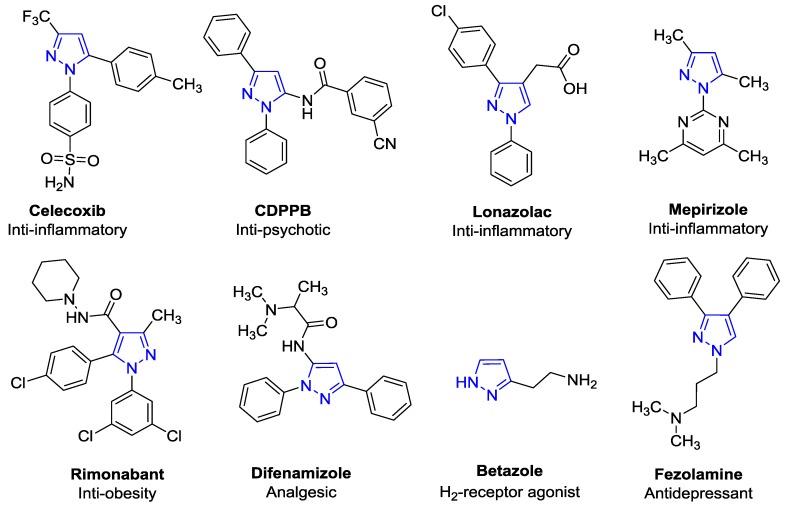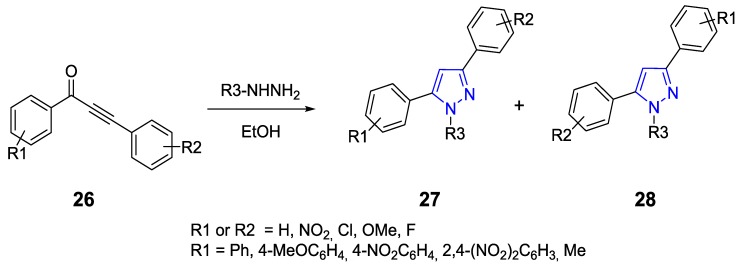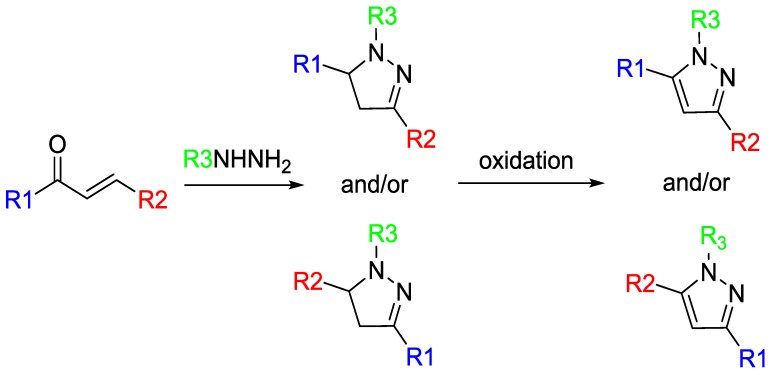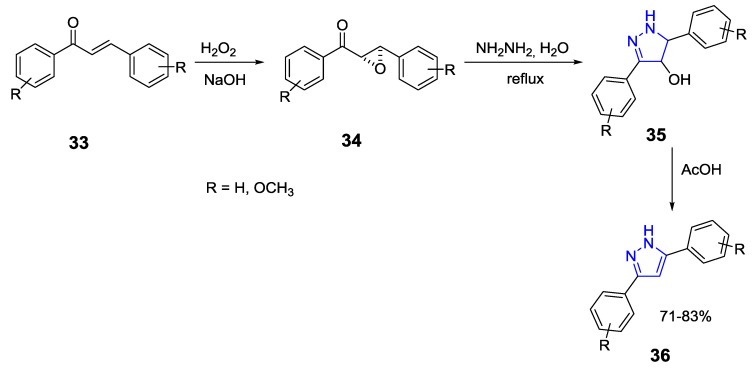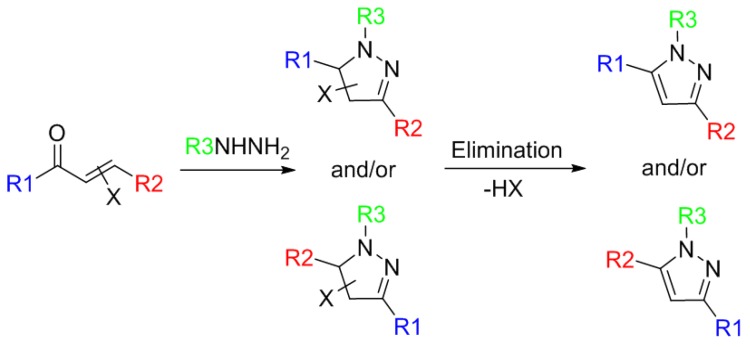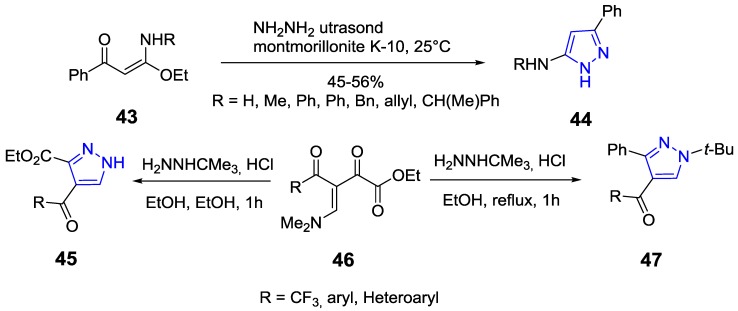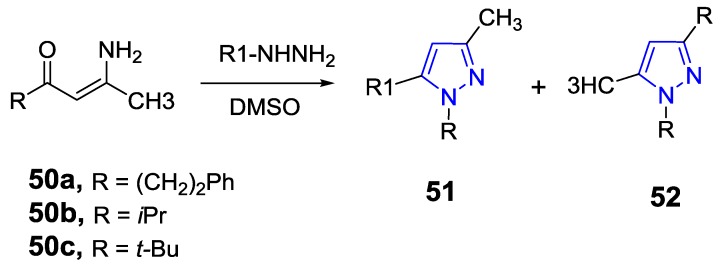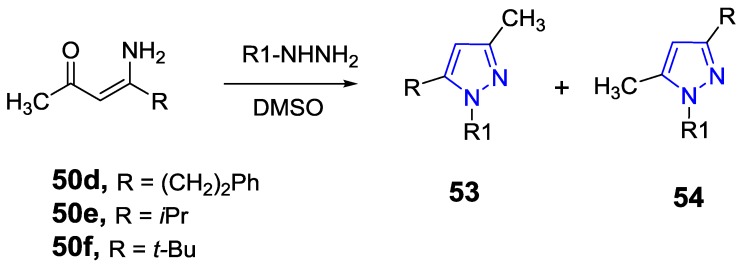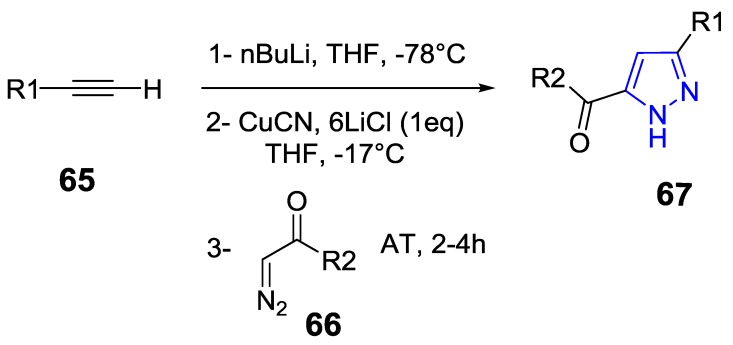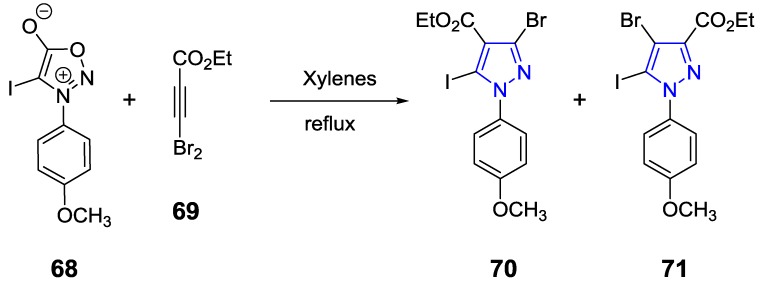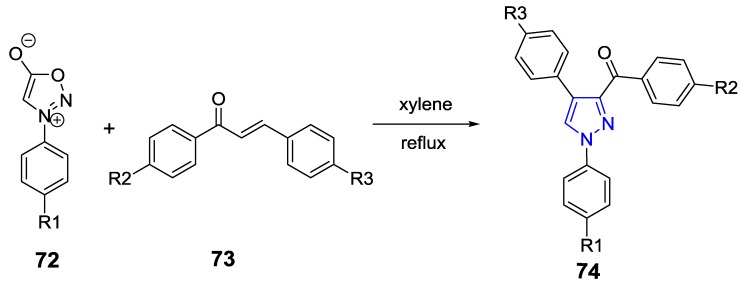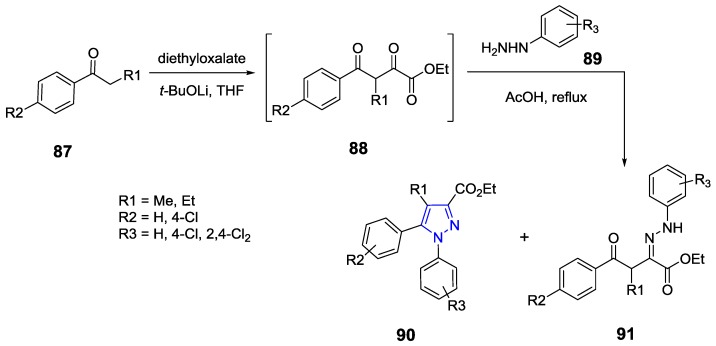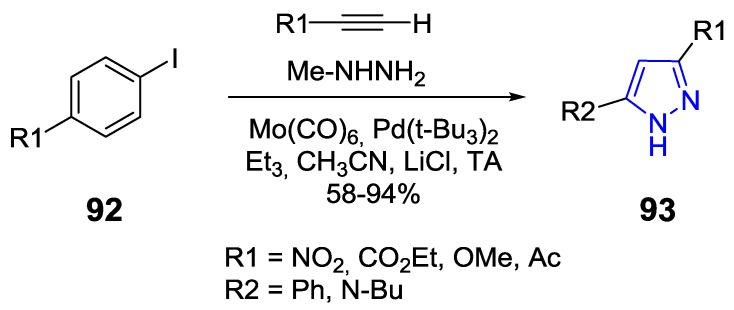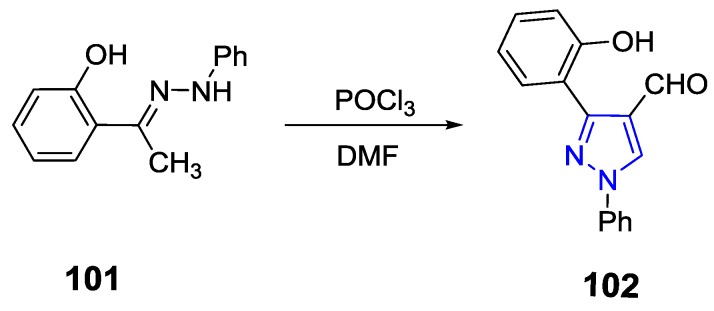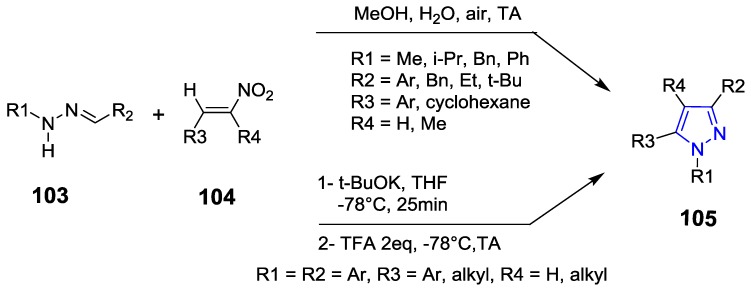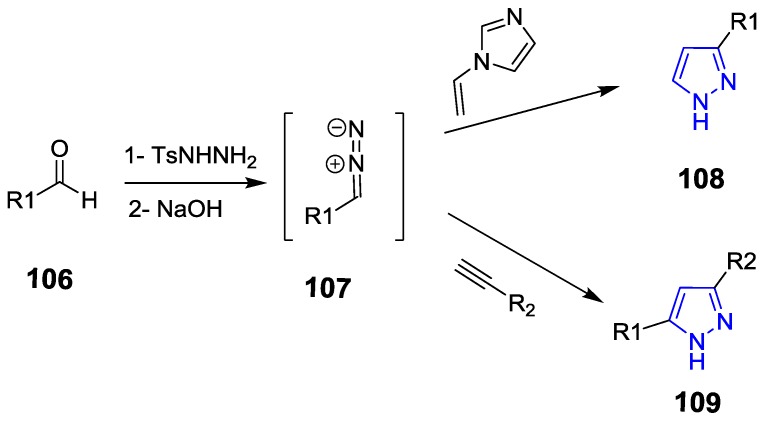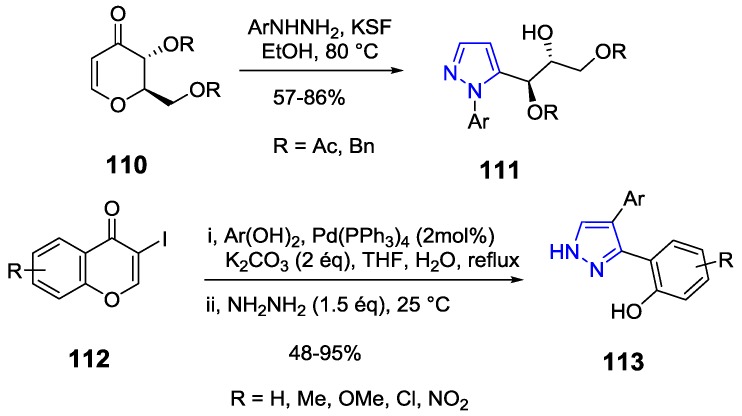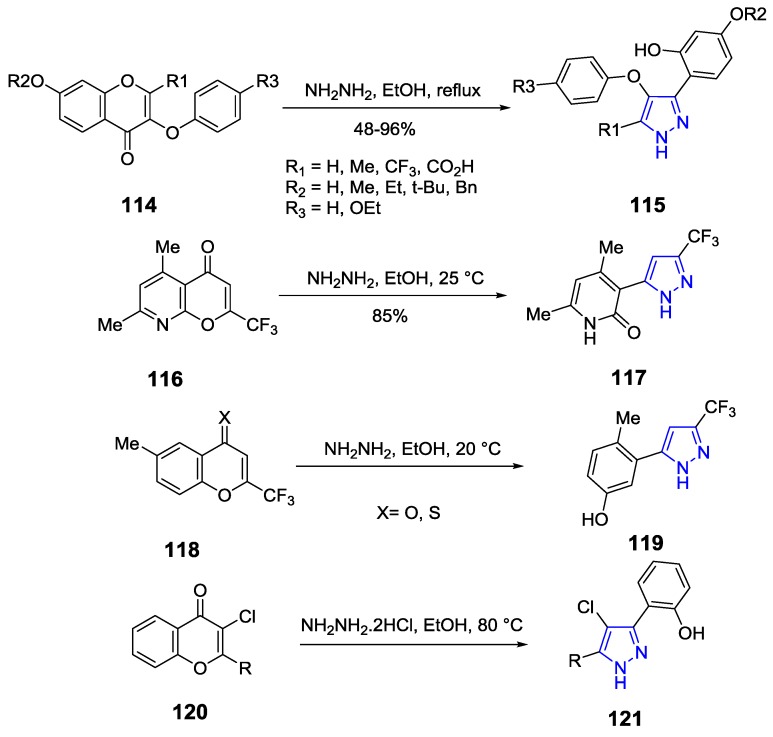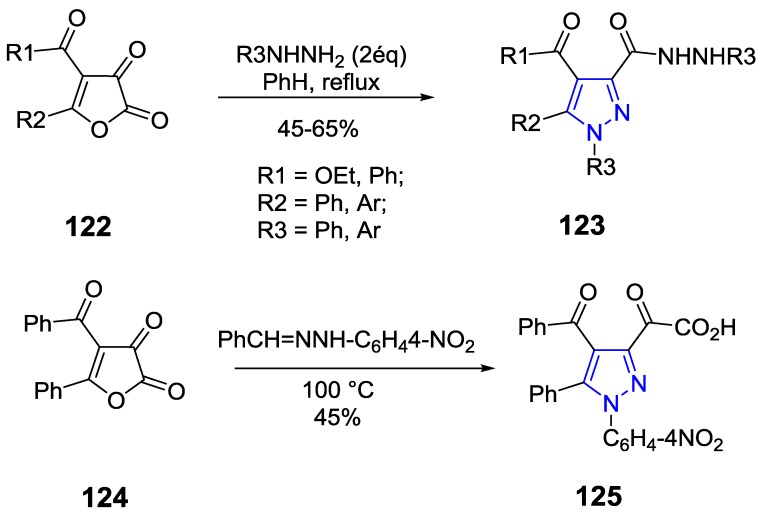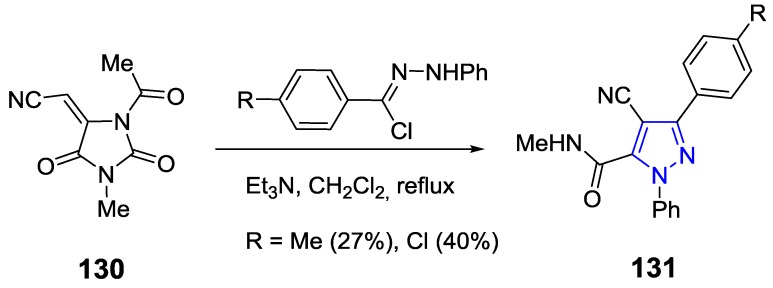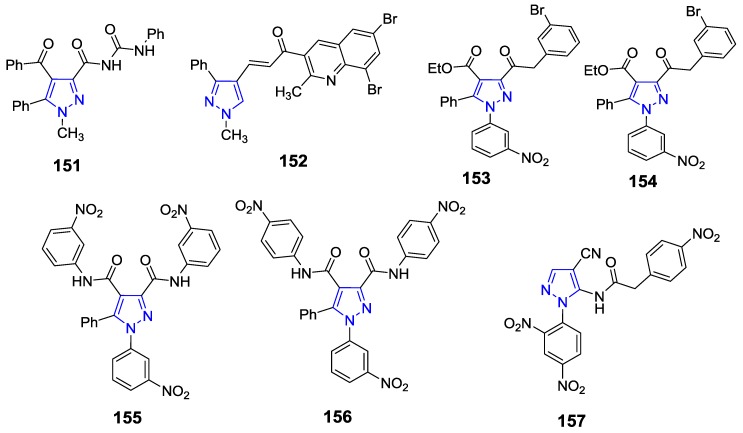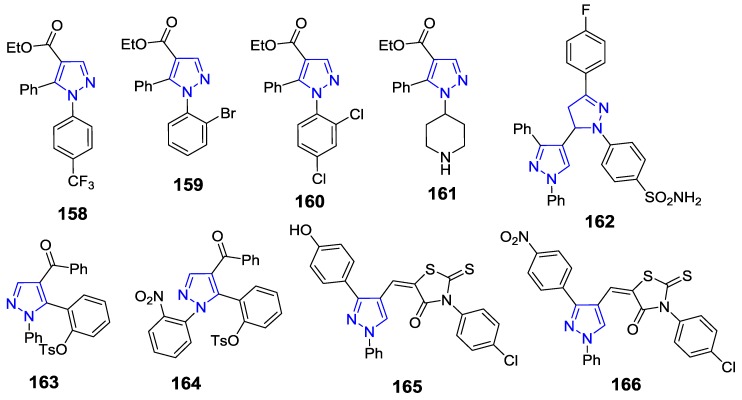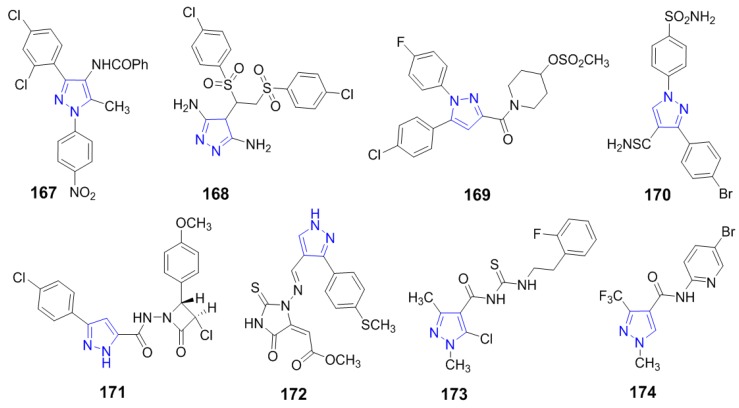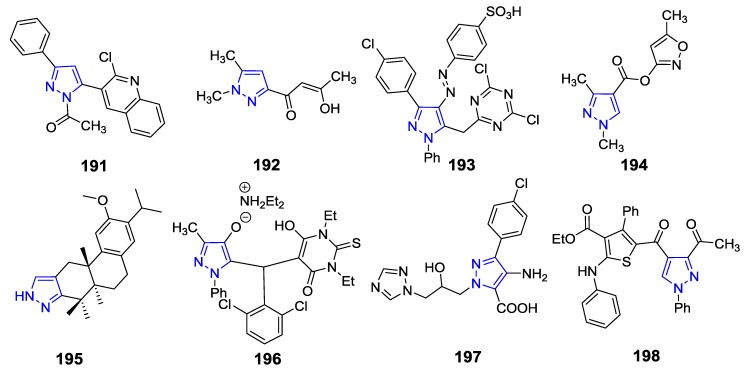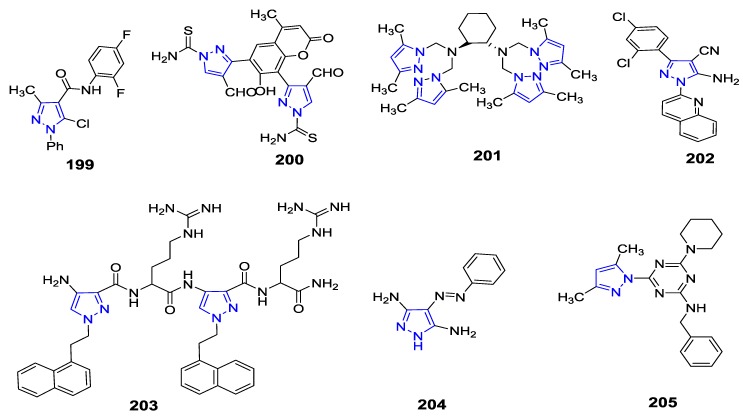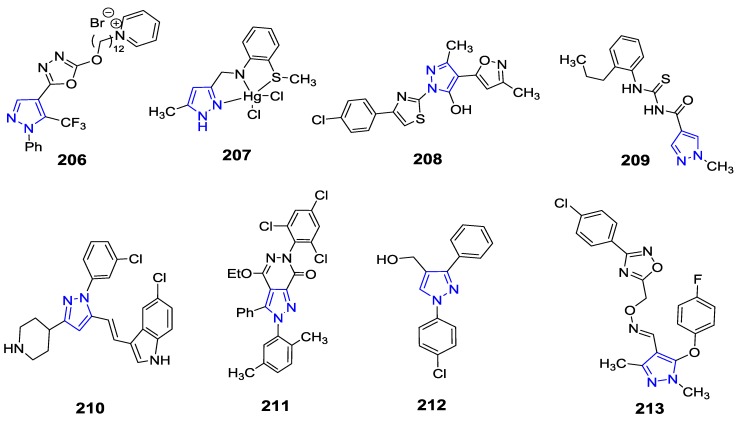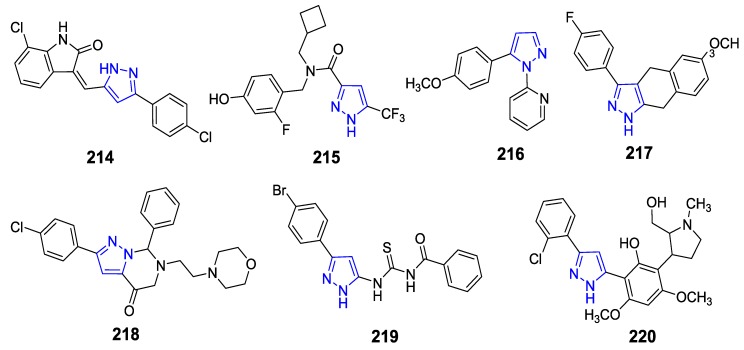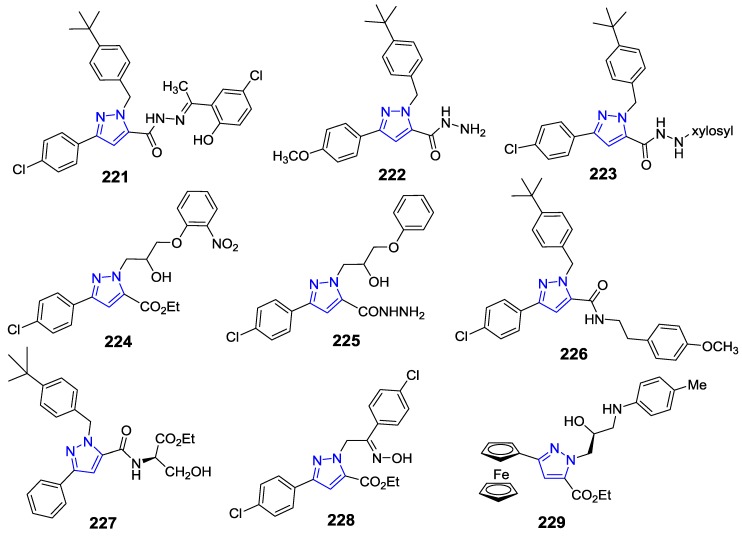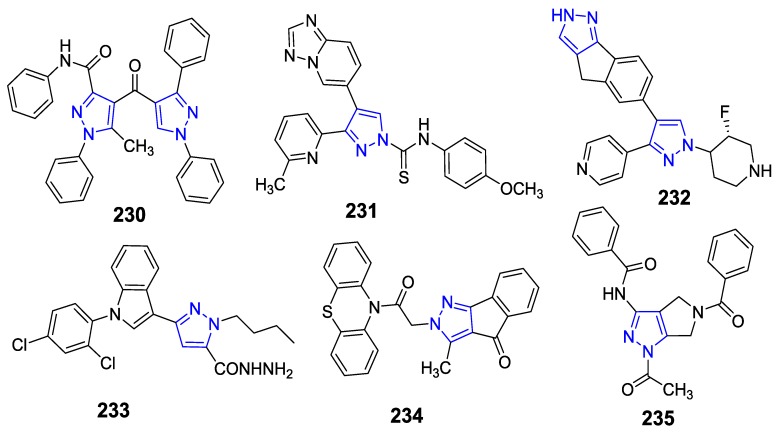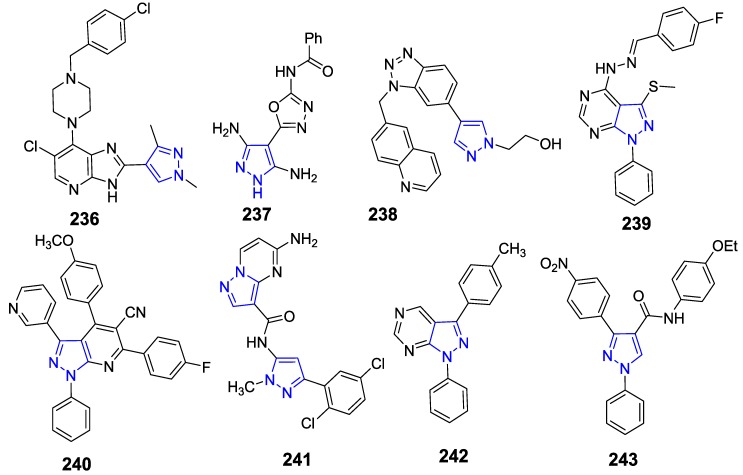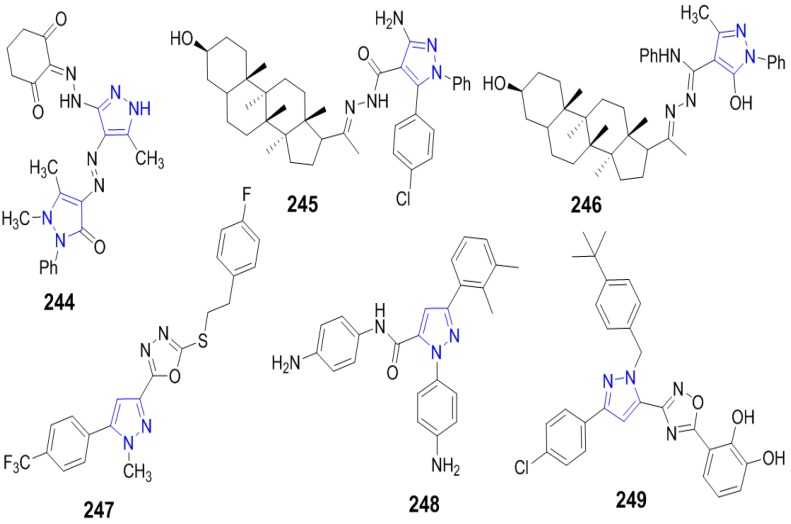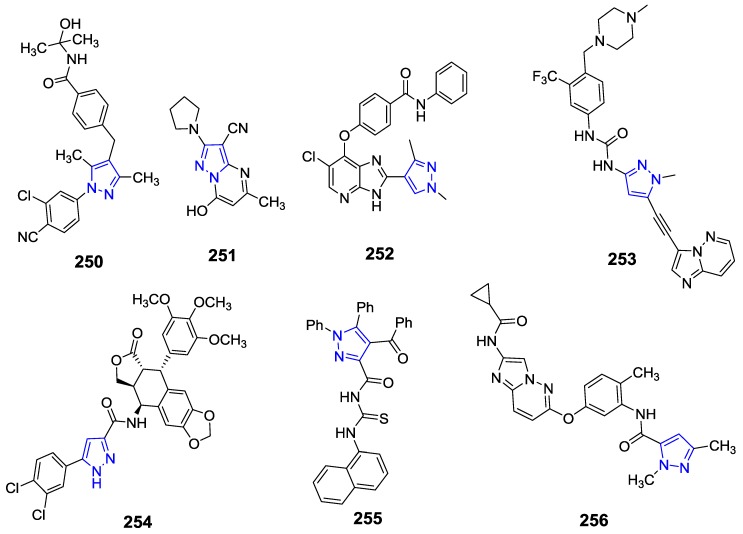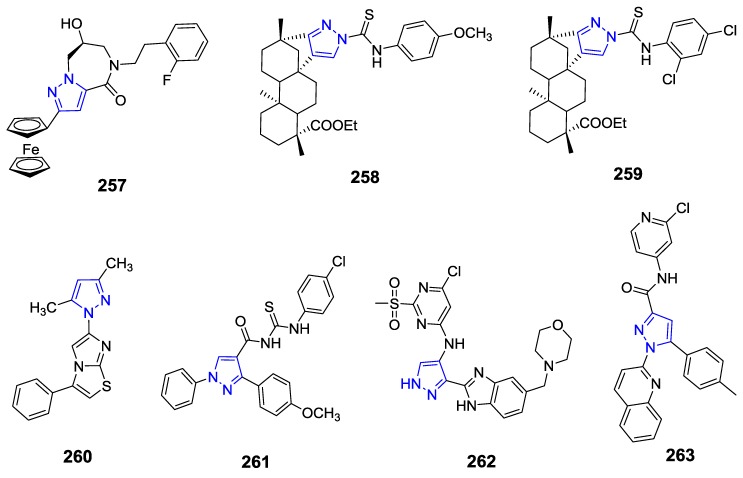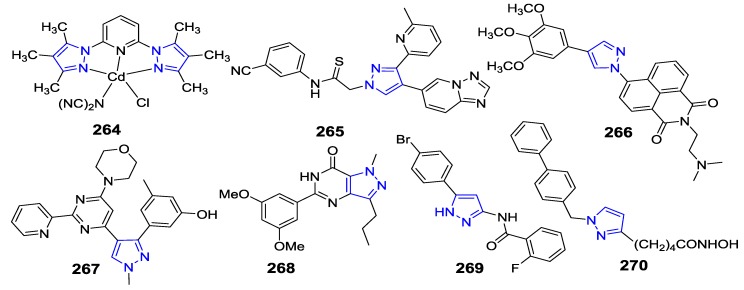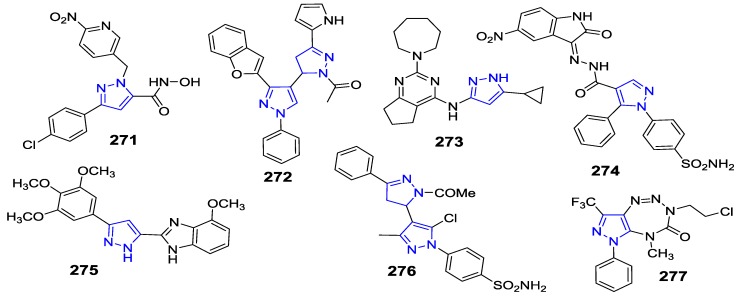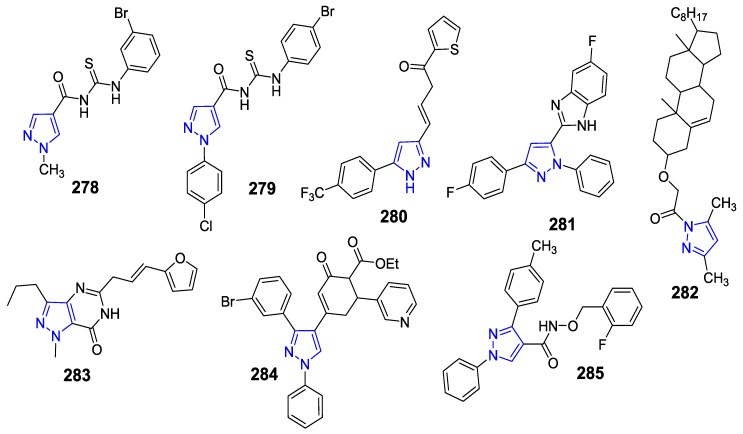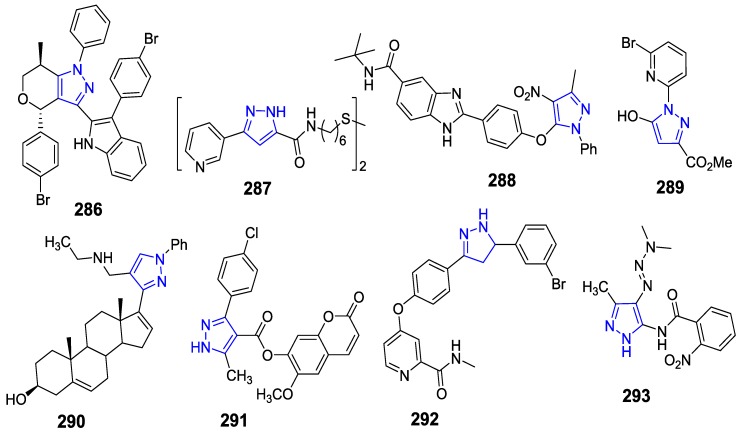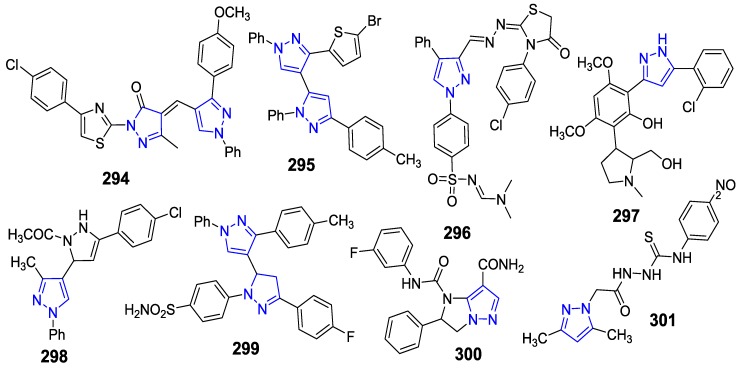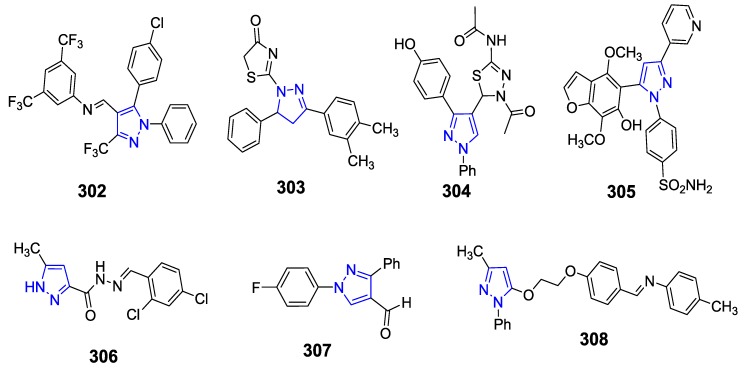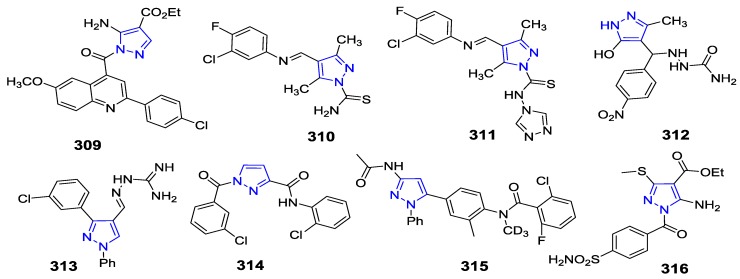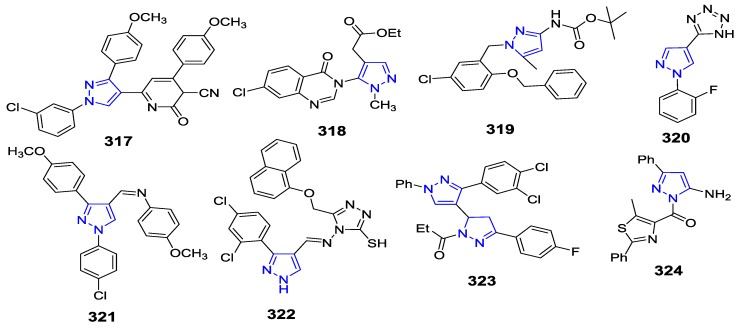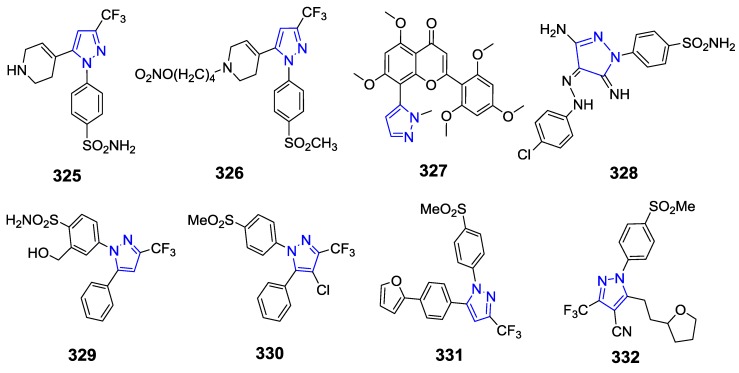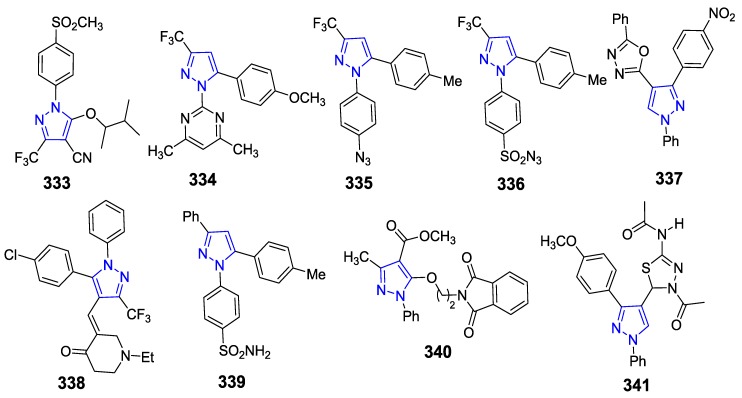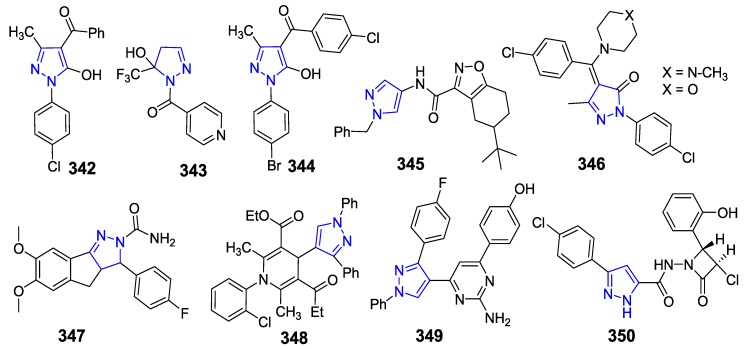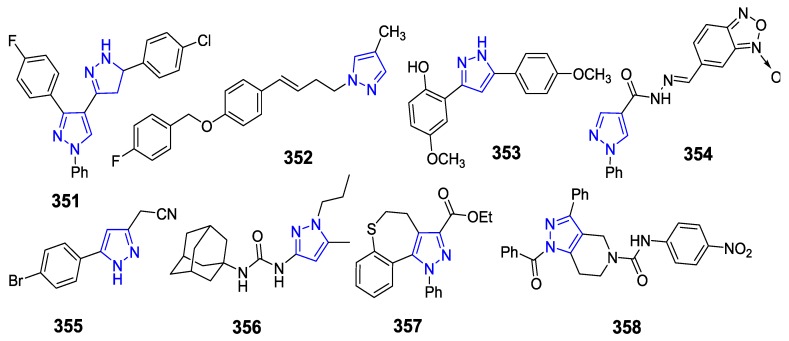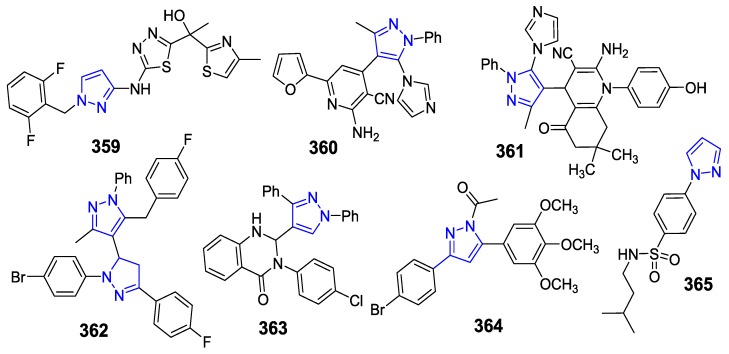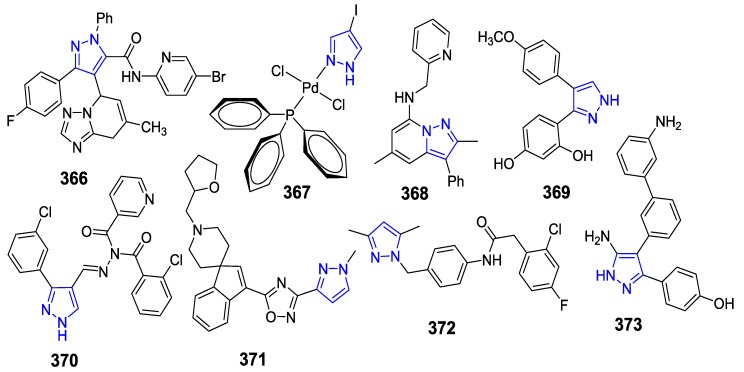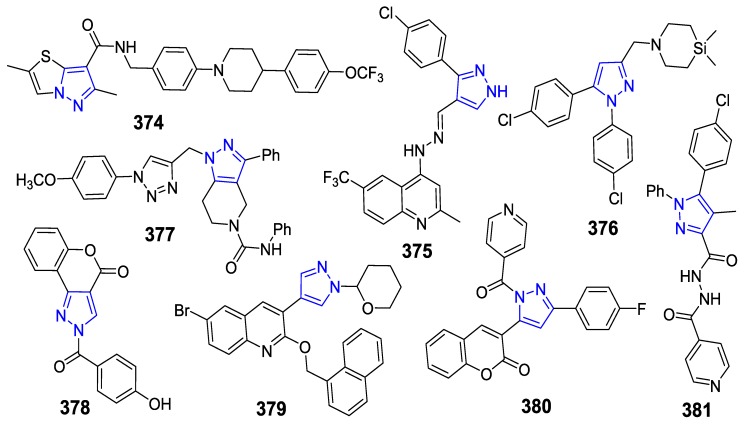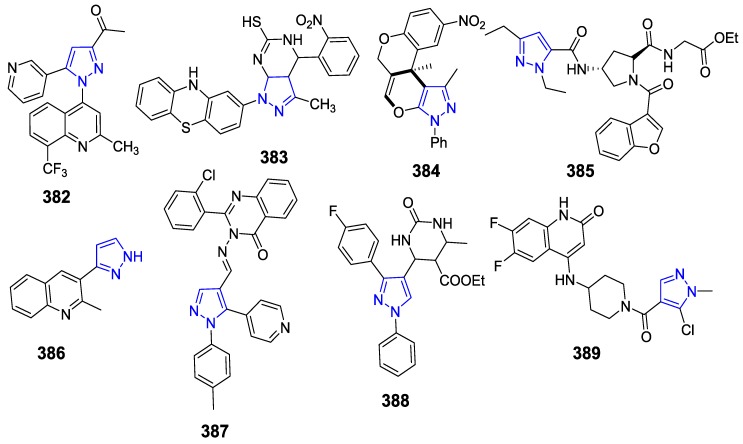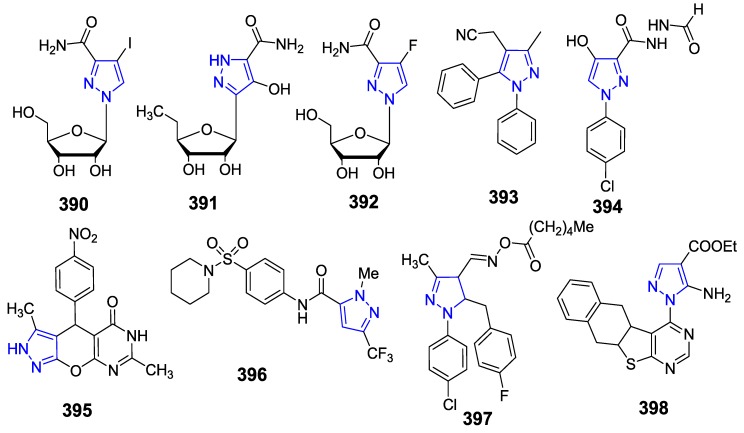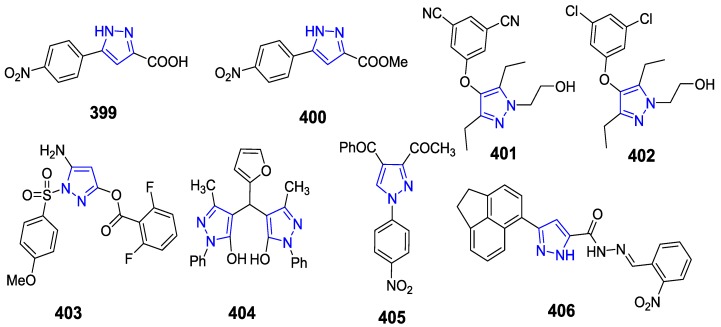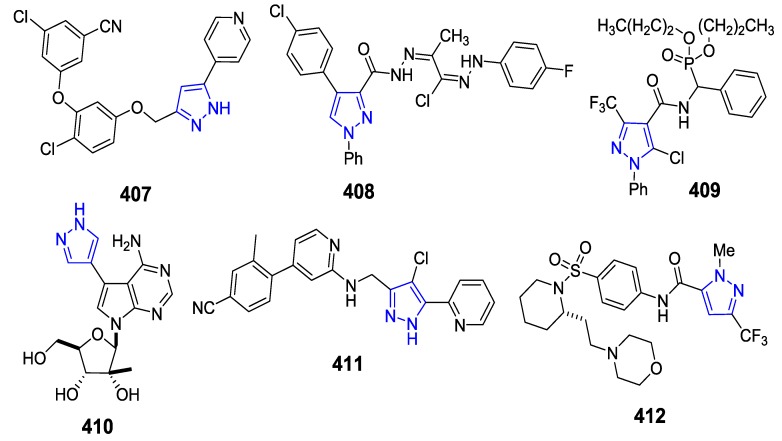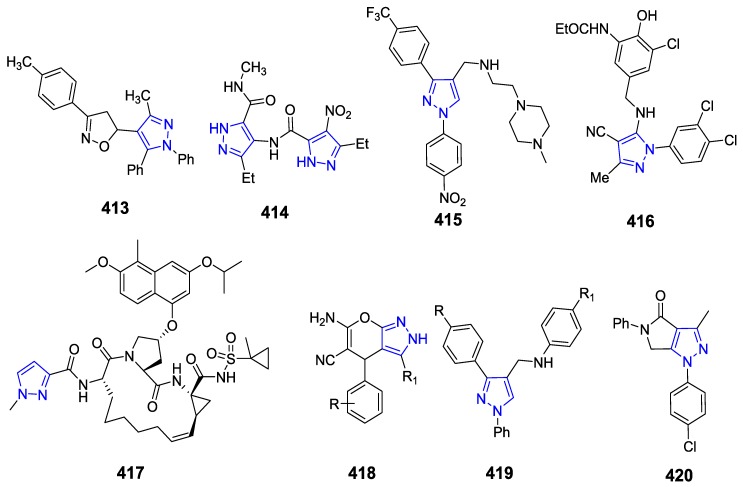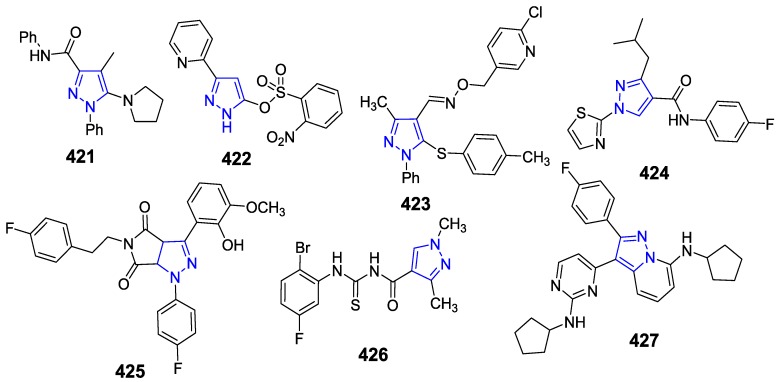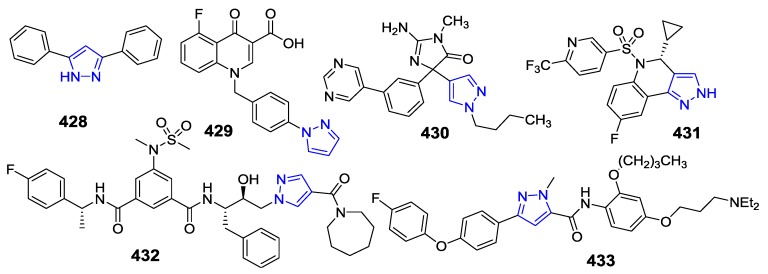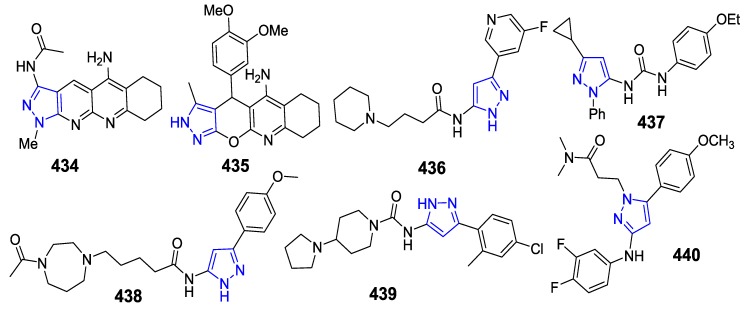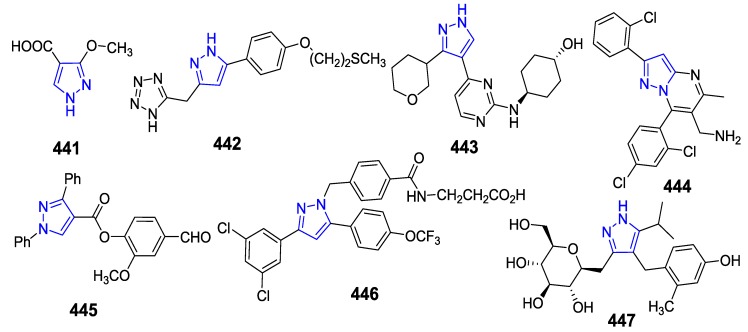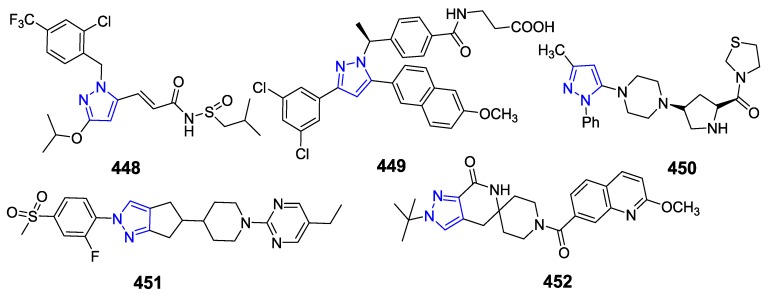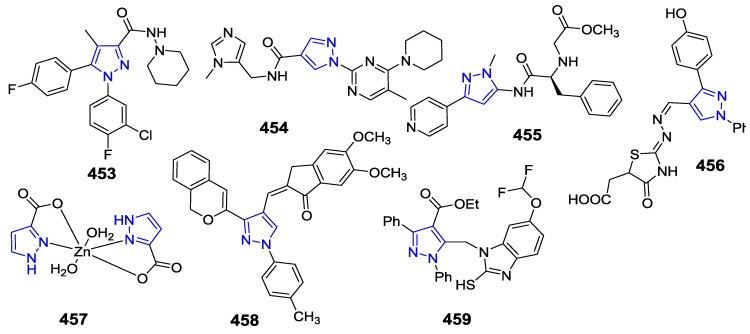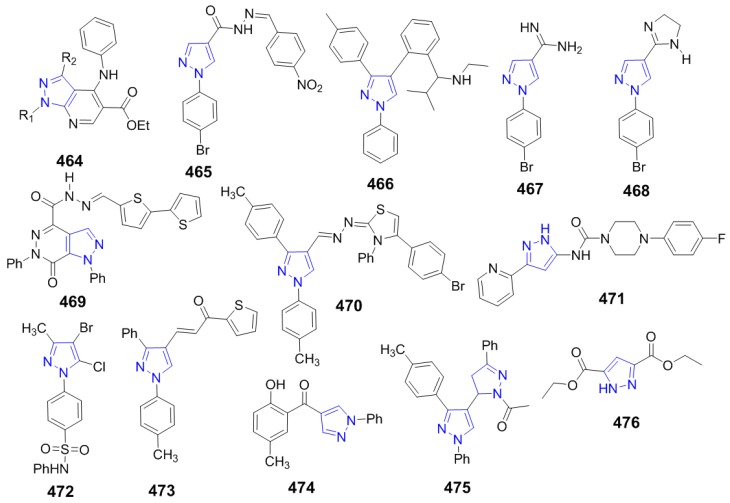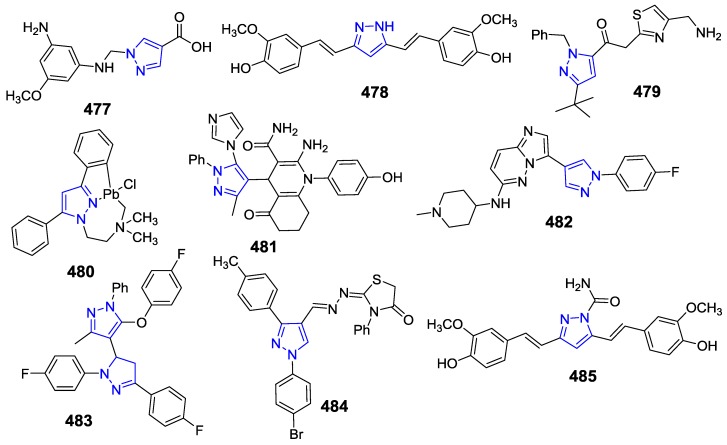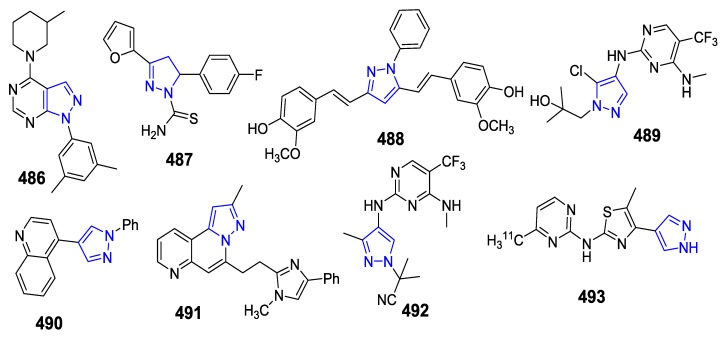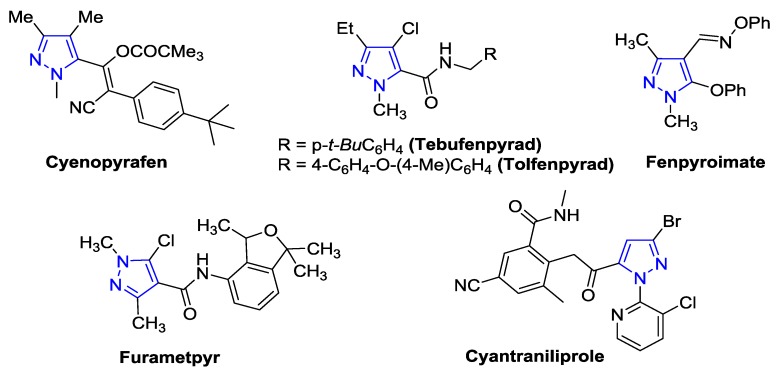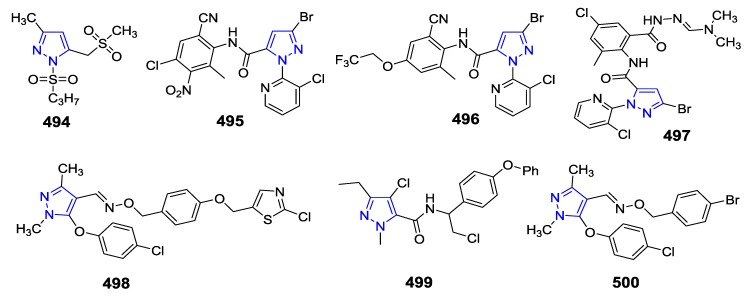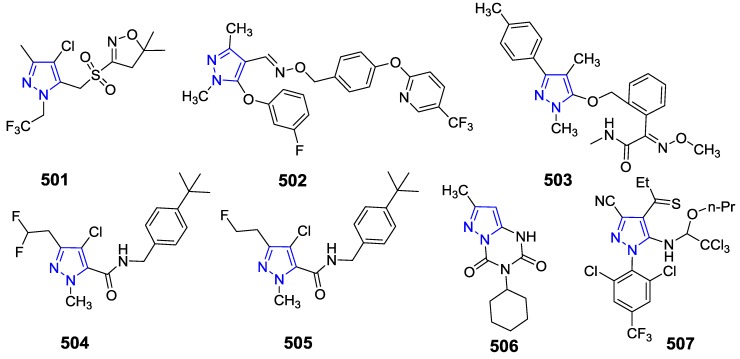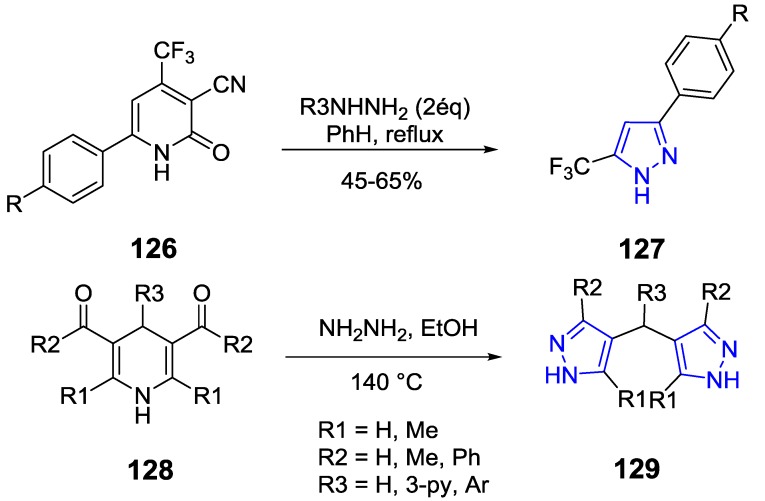Abstract
Pyrazole and its derivatives are considered a pharmacologically important active scaffold that possesses almost all types of pharmacological activities. The presence of this nucleus in pharmacological agents of diverse therapeutic categories such as celecoxib, a potent anti-inflammatory, the antipsychotic CDPPB, the anti-obesity drug rimonabant, difenamizole, an analgesic, betazole, a H2-receptor agonist and the antidepressant agent fezolamide have proved the pharmacological potential of the pyrazole moiety. Owing to this diversity in the biological field, this nucleus has attracted the attention of many researchers to study its skeleton chemically and biologically. This review highlights the different synthesis methods and the pharmacological properties of pyrazole derivatives. Studies on the synthesis and biological activity of pyrazole derivatives developed by many scientists around the globe are reported.
Keywords: pyrazole derivatives, synthesis, biological activities
1. Introduction
Pyrazoles are five-membered heterocycles that constitute a class of compounds particularly useful in organic synthesis. They are one of the most studied groups of compounds among the azole family. Indeed, a huge variety of synthesis methods and synthetic analogues have been reported over the years.
The presence of the pyrazole nucleus in different structures leads to diversified applications in different areas such as technology, medicine and agriculture. In particular, they are described as inhibitors of protein glycation, antibacterial, antifungal, anticancer, antidepressant, antiinflammatory, anti-tuberculosis, antioxidant as well as antiviral agents [1,2].
Nowadays, pyrazole systems, as biomolecules, have attracted more attention due to their interesting pharmacological properties. This heterocycle can be traced in a number of well-established drugs belonging to different categories with diverse therapeutic activities (Figure 1) [3,4,5,6,7,8,9,10].
Figure 1.
Pharmaceutical drugs containing pyrazole unit.
In this review, we present descriptions and discussions on the most relevant synthesis methods and pharmacological properties of pyrazole-derived heterocyclic systems.
2. The Main Methods of Access to the Pyrazole Nucleus
Pyrazole is a π-excess aromatic heterocycle. Electrophilic substitution reactions occur preferentially at position 4 and nucleophilic attacks at positions 3 and 5 (Figure 2).
Figure 2.
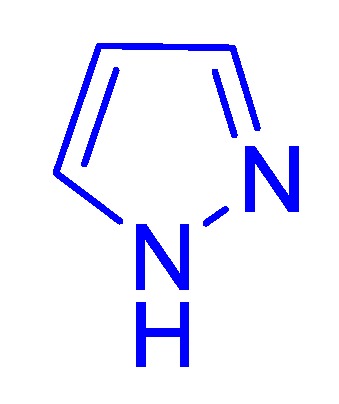
Structure of pyrazole.
The pyrazoles diversely substituted by aromatic and heteroaromatic groups possess numerous biological activities, which makes them particularly interesting. The various access routes to the pyrazole nucleus have undergone numerous modifications since the first syntheses described by Knorr [11]. In this section, we will study this evolution and present the methods generally used to access substituted pyrazoles, that is to say:
Cyclocondensation of hydrazine and similar derivatives with carbonyl systems.
Dipolar cycloadditions.
Multicomponent reactions.
2.1. Cyclocondensation of Hydrazine and Its Derivatives on 1,3-Difunctional Systems
The leading method used for obtaining substituted pyrazoles is a cyclocondensation reaction between an appropriate hydrazine acting as a bidentate nucleophile and a carbon unit like a 1,3-dicarbonyl compound, a 1,3-dicarbonyl derivatives or an α,β-unsaturated ketone (Figure 3).
Figure 3.
Examples of α,β-unsaturated carbonyl compounds.
2.1.1. From 1,3-Diketones
The cyclocondensation of the 1,3-dicarbonyl compounds with the hydrazine derivatives is a simple and rapid approach to obtain polysubstituted pyrazoles. The first synthesis of the substituted pyrazoles was carried out in 1883 by Knorr et al. [11] who reacted β-diketone 1 with hydrazine derivatives to give two regioisomers 2 and 3 (Scheme 1).
Scheme 1.
Synthesis of polysubstituted pyrazoles form 1,3-dicarbonyl compounds.
Girish et al. [12] described an efficient nano-ZnO catalyzed green protocol for the synthesis of 1,3,5-substituted pyrazoles derivatives 6 by condensation of phenylhydrazine 5 with ethyl acetoacetate (4) (Scheme 2). The main advantage of this protocol is the excellent yield (95%) achieved, short reaction time and easy work-up procedure.
Scheme 2.
Synthesis of 1,3,5-substituted pyrazoles from ethyl acetoacetate.
Similarly, Ohtsuka et al. [13] studied the condensation of phenylhydrazine 5 with the 2-(trifluoromethyl)-1,3-diketone 7 in ethanol, affording 1,3,4,5-substituted pyrazole 8 in good yield (63%). Compound 8 was exclusively formed presumably owing to the fact that the sterically small NH2 is more nucleophilic than NHPh (Scheme 3).
Scheme 3.
Synthesis of 1,3,4,5-substituted pyrazoles from 2-(trifluoromethyl)-1,3-diketone.
Gosselin and co-workers have proposed new reaction conditions for the regioselective synthesis of 1,3-substituted 1-arylpyrazoles from 1,3-dicarbonyl compounds. Indeed, the authors have found that the cyclocondensation of an aryl hydrochloride hydrazine with 1,3-diketones in aprotic dipolar solvents gives better results than in the polar protic solvents (like ethanol) generally used for this type of reaction. After optimization of the conditions, the addition of a solution of HCl 10 N to the amide solvent (DMF, NMP, DMAc) or urea (DMPU, TMU) makes it possible to increase the yields by accelerating the dehydration steps. The cyclocondensation of the diketones with hydrazine thus takes place at ambient temperature in N,N-dimethylacetamide, in an acid medium, to give the corresponding pyrazoles with good yields and good regioselectivity. The condensation of various arylhydrazine with 4,4,4-trifluoro-1-arylbutan-1,3-diketones 9, afforded two isomers 11, 12 with 74–77% yields. The selectivity obtained is of the order of 98:2 in favor of the isomer 11. By comparison, the reactions carried out under conventional conditions in ethanol, at ambient temperature, give equimolar mixtures of the regioisomers. Nevertheless, a loss of control of the regioselectivity is observed when the CF3 group is replaced by a CH3 or CHF2. Finally, the condensations of aryl hydrazines with the 1,3-diketones 13 that are 2-substituted by an alkyl group give the trisubstituted pyrazoles 14 and 15 in 79–89% yields and a regioselectivity greater than 99.8:0.2 in favor of isomer 15 in all cases (Scheme 4) [14].
Scheme 4.
Synthesis of pyrazoles from 1,3-diketones and arylhydrazines.
2.1.2. From Acetylenic Ketones
The cyclocondensation reaction of hydrazine derivatives 17 on acetylenic ketones 16 to form pyrazoles has been known for more than 100 years [15]. However, the reaction again results in a mixture of two regioisomers 18 and 19 (Scheme 5).
Scheme 5.
Synthesis of pyrazoles from acetylenic ketones.
The diacetylene ketones 20 reacted with phenylhydrazine 5 in ethanol to give two regioisomeric pyrazoles 21 and 22. When phenylhydrazine was used, a mixture of regio-isomers 21/22 was generated in approximately 3:2 ratio. When hydrazine hydrate was used as the nucleophile, only regioisomer 21 was isolated, presumably due to hydrogen bonding to the ethyl ester group (Scheme 6) [16].
Scheme 6.
Synthesis of pyrazoles from diacetylene ketones.
Guojing et al. reported a new efficient method for the synthesis of 3-trifluoromethylpyrazoles 25 with good yields via trifluoromethylation/cyclization of acetylenic ketones 25 on phenylhydrazine 5 using a hypervalent iodine reagent under transition-metal-free conditions. The optimal conditions were obtained when the ratio 24/Togni reagent was maintained at 1:1.3, giving 25 in 70% isolated yield (Scheme 7) [17].
Scheme 7.
Synthesis of 3-trifluoromethylpyrazoles via cyclization of acetylenic ketones.
Bishop et al. were interested in the factors determining the regioselectivity of this type of reaction in the framework of the synthesis of 3,5-diarylpyrazoles. They studied the cyclocondensation of acetylenic ketones 26 on methylhydrazine or aryl hydrazines in ethanol, which provides two difficultly separable regioisomeric pyrazoles 27 and 28 (Scheme 8) [18].
Scheme 8.
Synthesis of 3,5-diarylpyrazoles from acetylenic ketones and hydrazines derivatives.
The difference in regioselectivity observed when using methylhydrazine (ratio 27/28 = 93:3 to 97:3) or an arylic hydrazine (ratio 28/27 = 87:13 to 99:1) is explained by the fact that the nitrogen carrying a methyl group is much more nucleophilic and will react by Michael addition on the triple bond of the acetylenic ketone followed by the intramolecular formation of an imine. In the case of a hydrazine substituted by an aryl group, the primary amine is the most nucleophilic and will react on the triple bond followed by the attack of the secondary amine on the carbonyl.
2.1.3. From Vinyl Ketones
The cyclocondensation reaction between an α,β-ethylenic ketone and a hydrazine derivative results in the synthesis of pyrazolines which, after oxidation, provide the pyrazole ring (Scheme 9).
Scheme 9.
Synthesis of pyrazoles by cyclocondensation reaction of α,β-ethylenic ketone.
Rao et al. described the condensation of an α,β-ethylenic ketone 29 with p-(4-(tert-butyl)phenyl)hydrazine 30 in the presence of copper triflate and 1-butyl-3-methylimidazolium hexafluorophosphate [bmim] (PF6) as catalysts, to access pyrazoline 31. The corresponding 1,3,5-trisubstituted pyrazole 32 was obtained after oxidation in situ of this pyrazoline. The reaction protocol gave 1,3,5-triarylpyrazoles in good yields (about 82%) via a one-pot addition–cyclocondensation between chalcones and arylhydrazines, and oxidative aromatization stands without the requirement of an additional oxidizing reagent. The catalyst can be reused more than four cycles without much loss in the catalytic activity (Scheme 10) [19].
Scheme 10.
Synthesis of pyrazoles from α,β-ethylenic ketone.
On the other hand, Bhat et al. described a method for the synthesis of 3,5-diaryl-1H-pyrazoles from the reaction β-arylchalcones 33 with hydrogen peroxide that gave epoxides 34. Then, addition of hydrazine hydrate afforded pyrazoline intermediates 35, dehydration of which yielded desired 3,5-diaryl-1H-pyrazoles 36 (Scheme 11) [20].
Scheme 11.
Synthesis of 3,5-diaryl-1H-pyrazoles from β-arylchalcones.
Huang et al. developed a new regioselective synthesis of 4-alkyl-1,3,5-triarylpyrazoles for the preparation of unsymmetrically substituted systems of interest as ligands for the estrogen receptor. The condensation of hydrazines with α,β-ethylenic ketones 37 in DMF gave pyrazolines 38. However, the corresponding pyrazole derivatives 40 were obtained in good yield (66–88%) by alkylation of the pyrazolines 38 in the presence of LDA, before undergoing the oxidation reaction (Scheme 12) [21].
Scheme 12.
Synthesis of 4-alkyl-1,3,5-triarylpyrazoles from α,β-ethylenic ketones.
Similarly, a method for the synthesis of 1,3,5-trisubstituted pyrazoles from an α,β-ethylenic ketone was described. Cyclocondensation of the α,β-ethylenic ketone 41 with phenylhydrazine (1.2 eq.) 5 in acetic acid and in the presence of iodine (1.0 eq.) afforted the corresponding pyrazole 42 in good yield (70%) (Scheme 13) [22].
Scheme 13.
Synthesis of pyrazoles by cyclocondensation reaction of the α,β-ethylenic ketone.
2.1.4. From Vinyl Ketones Having a Leaving Group
The α,β-ethylenic ketones having a leaving group may react with hydrazine derivatives to form pyrazolines which, after removal of the leaving group, provide the desired pyrazoles (Scheme 14).
Scheme 14.
Synthesis of pyrazoles via cyclocondensation of α,β-ethylenic ketones having a leaving group.
5-Amino-3-phenylpyrazoles 44 were prepared from α-oxoketene O,N-acetals 43 using montmorillonite K-10 under sonication conditions [23]. The cyclocondensation of non-symmetrical enaminodicketones 46 on various hydrazine derivatives has been studied in the case of tert-butylhydrazine and carboxymethylhydrazine. The various pyrazoles 45 and 47 are obtained regiospecifically and in good yields (74–94%). It should be noted that in the case of carboxymethylhydrazine, the reaction leads directly to the corresponding NH-pyrazoles [24] (Scheme 15).
Scheme 15.
Synthesis of pyrazoles from α-oxoketene O,N-acetals and enaminodicketones.
Katritzky et al. [25] described the synthesis of 1-methyl(aryl)-3-phenyl-5-alkyl(aryl)pyrazoles 50 by a regioselective condensation reaction of α-benzotriazolylenones 48 with methyl and phenylhydrazines. The intermediate pyrazolines 49 are then treated in a basic medium to give the expected pyrazoles in 50–94% yields after removal of benzotriazole. The advantage of using the benzotriazole group lies in the fact that the proton in the α-position is made more acidic and thus permits functionalization in the 4-position of the pyrazoline nucleus, thus allowing access to tetrasubstituted pyrazoles 50 (Scheme 16).
Scheme 16.
Synthesis of pyrazoles starting from α-benzotriazolylenones.
Alberola et al. [26] studied the regioselectivity of the reaction of various β-aminoenones on different monoalkyl, acetyl-, methoxycarbonyl-hydrazine and semicarbazide. Indeed, when the least bulky substituent is attached at the β position of the enone, high regioselectivity is obtained. This is the case of pyrazoles 51 and 52 which have been obtained with a regioselectivity greater than 90% from the reaction of alkylhydrazines (R1 = Me, t-Bu), in DMSO, with β-aminoenones 50a, 50b and 50c which possess the smallest group (CH3) in the β position (Scheme 17 and Table 1).
Scheme 17.
Synthesis of pyrazoles from β-aminoenones.
Table 1.
Preparation of pyrazoles 55 from β-aminoenones 49a, 49b and 49c.
| Starting Compound | R | R1 | Yields of 51 (%) |
|---|---|---|---|
| 50a | (CH2)2Ph | Me | 81 |
| (CH2)2Ph | t-Bu | 78 | |
| 50b | iPr | Me | 84 |
| iPr | t-Bu | 86 | |
| 50c | t-Bu | Me | 72 |
| t-Bu | t-Bu | 86 |
In the inverse case where the substituent in position β is the largest, the regioselectivity decreases. Indeed, when β-aminoenones 50a, 50b and 50c were replaced by their position isomers 50d, 50e and 50f in the previous reactions, a drop in regioselectivity was observed (Scheme 18 and Table 2).
Scheme 18.
Synthesis of pyrazoles from β-aminoenones.
Table 2.
Preparation of pyrazoles 54 from β-aminoenones 54d, 54e and 54f.
| Starting Compound | R | R1 | Yields of 54 (%) | Ratio 54:53 |
|---|---|---|---|---|
| 50d | (CH2)2Ph | Me | 81 | 1:0 |
| (CH2)2Ph | t-Bu | 23 | 1:1.4 | |
| 50e | iPr | Me | 71 | 1:0 |
| iPr | t-Bu | - | 1:9 | |
| 50f | t-Bu | Me | 72 | 11:1 |
This phenomenon is all the more important as R and alkylhydrazine are more voluminous. In this context, in order to increase the regioselectivity (to increase the ratio 54/53) several experimental attempts have been carried out and have suggested that the selectivity would be improved if the reactions are catalyzed by acetic acid and carried out in DMSO or in ethanol.
2.2. The 1,3-Dipolar Cycloaddition
Other methods allowing access to the pyrazole nucleus involve [3 + 2] cyloaddition reactions between an alkyne (or an olefin) and 1,3-dipolar compounds such as the diazo compounds, the sydnones or the nitrilimines.
2.2.1. Cycloaddition of Diazocarbonyl Compounds
He et al. [27] investigated the action of ethyl α-diazoacetate 56 on phenylpropargyl 55 in triethylamine and in the presence of zinc triflate as a catalyst; the 1,3-dipolar cycloaddition reaction, leads to the corresponding pyrazole 57 in good yield (89%). The simple reaction conditions, straightforward procedure, synthetically useful products, good yielding, and easy manipulation make this method potentially useful in organic synthesis (Scheme 19).
Scheme 19.
Synthesis of pyrazoles by 1,3-dipolar cycloaddition of ethyl α-diazoacetate.
Gioiello and co-workers described a facile one-pot procedure for the synthesis of pyrazole-5-carboxylates by 1,3-dipolar cycloaddition of ethyl diazoacetate 58 with α-methylene carbonyl 59 compounds utilizing 1,8-diazabicyclo[5.4.0]undec-7-ene (DBU) as base and acetonitrile as solvent. Pyrazoles 60 and 61 were obtained with excellent regioselectivity and good yields. In particular, when 58 was reacted with 59 (with R1 = R2 = Ph) in the presence of 1.7 eq. of DBU in acetonitrile under argon atmosphere at room temperature, ethyl 3,4-diphenyl-1H-pyrazole-5-carboxylate was obtained in 65% yield after flash chromatography. The reaction was found to proceed by a domino 1,3-dipolar cycloaddition water elimination (Scheme 20) [28].
Scheme 20.
Synthesis of pyrazole-5-carboxylates using 1,3-dipolar cycloaddition of ethyl diazoacetate and α-methylene carbonyl.
Under the same conditions, the reaction of various aryl α-diazoarylacetacetates on methyl propionate led to the formation of two regioisomers 63 and 64. After cyclization, minor compound 64 (4–12%) is obtained by migration of the ester group on nitrogen atom. The majority compound 63 (77–90%) would be obtained by migration of the aryl group to the adjacent carbon atom followed by a prototropic rearrangement (Scheme 21) [29].
Scheme 21.
Synthesis of pyrazoles using 1,3-dipolar cycloaddition of α-diazoarylacetacetates.
In another approach, Qi and Ready developed a direct and efficient access towards 3-acylpyrazoles 67 that involves the copper-promoted cycloaddition of acetylides 65 with diazocarbonyl compounds 66 under mild conditions. A wide variety of substituents is tolerated at both the acetylide and the diazo compound. The method is a rare example of an inverse-electron-demand cycloaddition (Scheme 22) [30].
Scheme 22.
Synthesis of 3-acylpyrazoles using 1,3-dipolar cycloaddition of diazocarbonyl and acetylides.
2.2.2. The Sydnones
The pyrazoles ca obtained by a cycloaddition reaction of sydnones. Delaunay and co-workers presented the synthesis of the two regioisomeric 1,3,4,5-substituted pyrazoles 70 and 71 via a cycloaddition reaction between a sydnone 68 and alkyne 69. The reaction was completed within 15 h, giving rise to a 3:1 mixture of regioisomeric 5-iodopyrazoles 70 and 71 in 84% combined yield. The pyrazoles were easily separated by silica gel chromatography, and the structure assignment of the desired major isomer 70 (63% isolated yield) was made on the basis of the 1H-NMR spectrum [31] (Scheme 23).
Scheme 23.
Synthesis of pyrazoles by cycloaddition reaction of sydnones and alkyne.
On the other hand, Chen et al. [32] described the synthesis of a trisubstituted pyrazole 74, by 1,3-dipolar cycloaddition of arylsydnones 72 and α,β-unsaturated ketone 73 in dry xylene (Scheme 24).
Scheme 24.
Synthesis of pyrazoles by 1,3-dipolar cycloaddition of arylsydnones and chalcone.
2.2.3. Nitrilimines
Dadiboyena et al. described the synthesis of 1,3,5-trisubstituted pyrazole 78 by 1,3-dipolar cycloaddition of diphenylnitrilimine 75 with an alkene 76 in dichloromethane in the presence of triethylamine. The trisubstituted pyrazole 78, isolated in 88% yield, was the only product rather than the expected spiro-pyrazoline 77 (Scheme 25) [33].
Scheme 25.
Synthesis of pyrazole by 1,3-dipolar cycloaddition of diphenylnitrilimine and alkene.
Oh et al. reported the synthesis of the 1,3,5-substituted pyrazole 82 via 1,3-dipolar cycloaddition reaction of a vinyl derivative 81 with the nitrilimine 80 generated in situ from an arylhydrazone 79. The reaction yielded the corresponding pyrazole in 72% yield. The protocol is simple and practical, employing economical and readily available reagents (Scheme 26) [34].
Scheme 26.
Synthesis of pyrazole via 1,3-dipolar cycloaddition reaction of nitrilimine and vinyl.
2.3. Multicomponent Approaches
2.3.1. In Situ Formation of Carbonyl Derivatives
Harigae and co-workers reported the preparation of 3,5-substituted pyrazole 86 in good yields (68–99%) with high regioselectivity in one pot by the treatment of terminal alkynes 83 with aromatic aldehydes 84, molecular iodine, and hydrazines. The present reaction is a simple and practical method for the preparation of various 1,3-disubstituted pyrazoles from easily available compounds (Scheme 27) [35].
Scheme 27.
Synthesis of pyrazole from α,β-unsaturated carbonyl and hydrazine.
1,3,4,5-Substituted pyrazole 90 was synthetized via a cyclocondensation reaction of arylhydrazine 89 and carbonyl derivatives 88 generated in situ from a ketone 87 and diethyl oxalate. The diketoesters 88 was converted into the desired 1,5-isomers 90 in the yields of 60–66%. Meanwhile, N-arylhydrazones 91 were obtained in the yields of 24–31% (Scheme 28) [36].
Scheme 28.
Synthesis of pyrazole via cyclocondensation reaction of 1,3-dicarbonyl and arylhydrazine.
Lizuka and Kondo demonstrate palladocatalyzed carbonylation of acetylenic acids on aryl iodides 92 in the presence of hexacarbonyl molybdenum as a source of CO and tri-tert-butylphosphine as a palladium ligand, to similarly access 1,3,5-substituted pyrazoles 93 with excellent yields (58–94%). The one-pot formation of pyrazole in the presence of methylhydrazine was also successful and aryl iodides with electron withdrawing groups were easily converted into pyrazoles (Scheme 29) [37].
Scheme 29.
Synthesis of pyrazoles by one-pot reaction of aryl iodides, acetylenic acids and methylhydrazine.
2.3.2. In Situ Formation of β-Aminoenones
Kovacs et al. developed a novel process for the synthesis of 3,5-substituted pyrazoles 97 via cuprocatalyzed coupling between an alkyne 95 and an oxime 94 in dimethylformamide, which provides the β-aminoenone 96. The valuable β-aminoenone was transformed into pyrazoles with the addition of hydrazine in a straightforward one-pot procedure; the product 97 was isolated with 70% yield (Scheme 30) [38].
Scheme 30.
Synthesis of 3,5-diphenylpyrazoles via cuprocatalyzed coupling between alkyne and oxime.
2.3.3. In Situ Formation of a Hydrazone
Dang et al. described a novel reaction for the synthesis of pyrazole-3-carboxylates by one-pot cyclization of hydrazone dianions 98 with diethyl dioxalate 99. The cyclization of diethyl oxalate with the dianions of hydrazones 98 afforded the pyrazole-3-carboxylates 100 in good yields (53%) (Scheme 31) [39].
Scheme 31.
Synthesis of pyrazoles by one-pot cyclization of hydrazone with diethyl dioxalate.
Lokhande et al. used the Vilsmeier-Haack reaction to synthesize carboxaldehyde pyrazoles 101. Condensation of a hydrazine 102 in the presence of phosphorus oxychloride gives the 4-formyl pyrazole (Scheme 32) [40].
Scheme 32.
Synthesis of carboxaldehyde pyrazoles by Vilsmeier-Haack reaction.
1,3,4,5-Substituted pyrazoles 105 were regioselectively synthesized in modest to good yields (26–92%) by Deng and Mani from hydrazone 103 and a nitroolefin 104 in methanol [41]. As a result of this work, the same authors proposed another strategy for synthesis based on the use of the same substrates and selectively leading to 1,3,4-substituted pyrazoles. In this new approach, the cyclocondensation of nitroolefins 104 with hydrazones 103 is carried out using a strong base such as t-BuOK. After treatment with a strong acid, the desired pyrazole 105 is obtained in the form of a single regioisomer in excellent yields (42–88%) (Scheme 33) [42].
Scheme 33.
Synthesis of 1,3,4,5-Substituted pyrazole derivatives.
2.3.4. In Situ Formation of Diazo Compounds
The Aggarwal team has developed a multicomponent process in which diazo 107 derivatives are generated in situ from various aldehydes 106 and tosylhydrazines, thus limiting the risks associated with the isolation of these compounds. These are then used in a 1,3-dipolar cycloaddition reaction to give corresponding pyrazoles 108 and 109 Diazo compounds derived from aldehydes were reacted with terminal alkynes to furnish regioselectively 3,5-disubstituted pyrazoles in 24–67% yields. Furthermore, the reaction of N-vinylimidazole and diazo compounds derived from aldehydes gave exclusively 3-substituted pyrazoles in a one-pot process with 32–79% yields (Scheme 34) [43].
Scheme 34.
Synthesis of pyrazoles by 1,3-dipolar cycloaddition of diazo derivatives.
2.4. From Heterocyclic Systems
2.4.1. From the Pyranones
Pyranones are among the most widely used heterocycles for the preparation of pyrazoles. The condensation of 2,3-dihydro-4H-pyran-4-ones 110 with arylhydrazines in ethanol and in the presence of montmorillonite KSF as catalyst, gives access to 5-substituted pyrazoles 111 in yields of (57–86%) (Scheme 35) [44]. Similarly, Xie et al. have developed a general method for the synthesis of pyrazoles. This involves the use of Suzuki coupling of arylboronic acids with chromones 112, followed by the action of hydrazine hydrate, yields the corresponding 3,4-diarylpyrazoles 113 in a yield of 48–95% (Scheme 35) [45].
Scheme 35.
Synthesis of pyrazoles from pyranones.
Similarly, reaction of pyranones derivatives 114, 116, 118 and 120 with hydrazine in ethanol the give corresponding pyrazoles 115, 117, 119 and 121 respectively (Scheme 36) [46,47,48,49].
Scheme 36.
Synthesis of pyrazoles by reaction of pyranones derivatives with hydrazine.
2.4.2. From Furandiones
Ilham et al. [50] carried out condensation in refluxing benzene, furan-2,3-diones 126 with arylhydrazines, allowing access to pyrazole-3-hydrazides 127 in acceptable to good yields (45–65%) (Scheme 37). Similarly, condensation of furan-2,3-dione 128 with N-benzylidene-N′-(4-nitrophenyl) hydrazine afforted 4-benzoyl-1-(4-nitrophenyl)-5-phenyl-1H-pyrazole-3-carboxylic acid 129 in a 45% yield (Scheme 37) [51].
Scheme 37.
Synthesis of pyrazoles from furandiones.
2.4.3. From Pyrimidines and Pyrimidones
3-Cyano-4-trifluoromethyl-6-aryl-2(1H)-pyridones 126 react with hydrazine hydrate under reflux to give 5-trifluoromethyl-3-arylpyrazoles 127 in 45–65% yields (Scheme 38) [52]. Similarly, the reaction of 3,5-diacyl-1,4-dihydropyridine 128 with hydrazine in ethanol at 140 °C afforded bis-pyrazolyl methanes 129 in good yields (Scheme 38) [53].
2.4.4. From Imidazole
Cycloaddition of (5Z)-1-acyl-5-(cyanomethylidene)-3-methylimidazolidine-2,4-diones 130 with arylhydrazonyl chloride under basic conditions to give pyrazole-5-carboxamides 131 in moderate 27–40% yields (Scheme 39) [54].
Scheme 39.
Synthesis of pyrazoles from oxazoles.
2.4.5. From Oxazoles
5-Trifluoromethyl-3-hydroxypyrazoles 132 were obtained in good yield (46–95%) by heating phenylhydrazine and 4-trifluoroacetyl-1,3-oxazolium-5-olates 133 under reflux of benzene (Scheme 40) [55].
Scheme 40.
Synthesis of pyrazoles from oxazoles.
2.4.6. From Tetrazoles
Cyanopyrazoles 135 are readily prepared from tetrazolo[1,5-b]pyridazines, tetrazolo[1,5-a] pyrimidines, or tetrazolo[1,5-a]pyridines. Tetrazolyl acroleins 134 reacts with fumaronitrile in xylene at 140 °C to give the corresponding pyrazole formation 135 (Scheme 41) [56].
Scheme 41.
Synthesis of pyrazoles from tetrazoles.
2.4.7. From Triazines
Rykowski et al. [57] proposed a synthesis of pyrazoles, based on the condensation of 3-chloro-6-phenyl-1,2,4-triazines 136 on α-chlorosulfonyls in the presence of potassium hydroxide for obtain the corresponding pyrazoles 137 (Scheme 42).
Scheme 42.
Synthesis of pyrazoles from triazines.
2.4.8. From 1,5-Benzodiazepin-2-one
Ferfra et al. [58] prepared pyrazole from benzodiazepine-2-thione in one step. They opened the seven-membered ring by reacting hydrazine with benzodiazepine-2-thione 138 to give o-aminophenylaminopyrazole 139 (Scheme 43).
Scheme 43.
Synthesis of pyrazoles from 1,5-Benzodiazepin-2-one.
2.4.9. From Other Heterocycles
Substituted pyrazoles 141 were synthesized in high yields through the condensation reaction of (Z)-3-Acetyl-2-methyl-2,3-dihydro-1,4-benzodioxin-2-ol 140 with arylhydrazines in a mixture of water and acetic acid (Scheme 44) [59].
Scheme 44.
Synthesis of pyrazoles from (Z)-3-Acetyl-2-methyl-2,3-dihydro-1,4-benzodioxin-2-ol.
Similarly, condensation of ethyl-1-amino-6,7-difluorooxoquinolin-4-one-3-carboxylate 142 with pentane-2,4-dione in acetic acid at reflux afforded 1-(2-acetyl-4,5-difluorophenyl)-3-methyl-4-acetylpyrazole 143 (Scheme 45) [60].
Scheme 45.
Synthesis of pyrazoles from ethyl-1-amino-6,7-difluorooxoquinolin-4-one-3-carboxylate.
5-Aminopyrazoles 145 were obtained in good yield by heating of 3-methyl-6H-1,3,4-thiadiazine 146 under reflux of acetic acid (Scheme 46) [61].
Scheme 46.
Synthesis of pyrazoles from 3-methyl-6H-1,3,4-thiadiazine.
On the other hand, the reaction of nitropyrimidine 146 with arylhydrazines in methanol at room temperature, to afford 4-nitro-3,5-diaminopyrazoles 147 in yields of 21–61% (Scheme 47) [62].
Scheme 47.
Synthesis of pyrazoles from nitropyrimidine.
Suen et al. prepared a series of substituted 1H-pyrazoles 150 by condensing thietanone 148 with 1,2,4,5-tetrazines 149 in the presence of potassium hydroxide (Scheme 48) [63].
Scheme 48.
Synthesis of pyrazoles by condensation of thietanone and 1,2,4,5-tetrazines.
3. Pharmacological Activities
3.1. Antibacterial and Antifungal Activity
Akbas et al. synthesized of series 1H-pyrazole-3-carboxylic acid derivatives (Figure 4) and evaluated for their antibacterial activities against Bacillus cereus, Staphylococcus aureus, Escherichia coli and Pseudomonas putida. The results showed that the compound 151 was the best compound in the series, exhibiting antibacterial activity against both Gram-positive and Gram-negative bacteria [64]. A series of new pyrazoles containing a quinolinyl chalcone group were synthesized and assessed for antibacterial activity. Compound 152 was the most potent against bacterial and fungal strains [65]. A series of pyrazole-3-carboxylic acid and pyrazole-3,4-dicarboxylic acid derivatives were synthesized and evaluated for their antibacterial and antifungal activities against five bacterial and five fungal pathogens. However, only the molecules 153, 154, 155 and 156 demonstrated some inhibitory effects on Candida parapsilosis, Candida tropicalis, and Candida glabrata strains [66]. Rahimizadeh et al. reported the synthesis and antibacterial activity of a series of 5-amido-1-(2,4-dinitrophenyl)-1H-pyrazole-4-carbonitriles. Results showed that the compound 157 exhibit antimicrobial activities against methicillin susceptible S. aureus and methicillin resistant S. aureus with MIC values of 25.1 µM [67].
Figure 4.
Structures of some pyrazole derivatives as antimicrobial compounds.
A series of pyrazole derivatives were synthesized and screened for their antibacterial properties against S. aureus, Bacillus subtilis, E. coli and P. aeruginosa. Among the tested compounds 158, 159, 160 and 161 (Figure 5) have shown excellent antibacterial activity against all the tested bacterial strains as compared with the standard drug ceftriaxone, which was active at 3.125, 1.6125, 1.6125 and 1.6125 µg/mL against S. aureus, B. subtilis, E. coli, and P. aeruginosa strains, respectively [68].
Figure 5.
Structures of some pyrazole derivatives with antibacterial activity.
A series of pyrazolylpyrazolines was synthesized and evaluated for their in vitro anti-microbial activity against two Gram-positive bacteria and two Gram-negative bacteria. The results schowed that the compound 162 was able to inhibit the growth of both the Gram-positive as well as Gram-negative bacteria [69]. A series of pyrazole derivatives were prepared and screened for their anti-bacterial and antifungal activities using ampicillin and norcadine as standard drugs. All the compounds were screened for their antimicrobial activities. The results for these derivatives showed good antibacterial activity for 163 and 164 [70].
B’Bhatt and Sharma synthesized a series of 3-(4-chlorophenyl)-5-((1-phenyl-3-aryl-1H-pyrazol-4-yl)methylene)-2-thioxothiazolidin-4-ones. All the synthesized compounds were screened for in vitro antibacterial activity against E. coli, P. aeruginosa, S. aureus, and S. pyogenes and in vitro anti-fungal activity, these compounds were tested against C. albicans, A. niger and A. clavatus using ampicillin and griseofulvin as standard drugs. Compound 165 was found as a potent compound against E. coli, while compound 166 was found to be potent against S. aureus, S. pyogenes and was found to have very good activity against C. albicans [71].
1,3,4,5-Tetrasubstituted pyrazole derivatives were synthesized and tested for anti-microbial activity against S. aureus, E. coli, Aspergillus flavus and C. albicans. Compound 167 showed promising antibacterial and antifungal activity [72]. Padmaja et al. reported the synthesis and antimicrobial activity of substituted pyrazoles. Results showed that the compound with sulfone moieties 168 displayed the maximum activity [73]. Novel 1,5-diaryl pyrazole derivatives were synthesized and screened for their antimicrobial activity against E. coli, S. aureus, P. aeruginosa, K. pneumonia and for their antifungal activity against A. flavus, A. fumigates, P. marneffei and T. mentagrophytes. Compound 169 (Figure 6) exhibited good antibacterial and antifungal activity with MIC value of 12.5 mg/mL [74]. A series of 1,3-diarylpyrazoles derivatives were synthesized and evaluated for their in vitro antibacterial activity against S. aureus, B. subtilis, E. coli, P. aeruginosa, and in vitro antifungal activity against A. niger and A. flavus. Compound 169 exhibited moderate antibacterial and antifungal activities against the tested bacteria and fungi [75]. A series of 3-(4-chlorophenyl)-4-substituted pyrazoles were synthesized and tested for antifungal activity against a pathogenic strain of fungi and antibacterial activity against Gram-positive and Gram-negative organisms. Among those tested, compound 171 (Figure 6) showed good to excellent antimicrobial at MIC values of 0.0025 to 12.5 µg/mL against all the selected pathogenic bacteria and fungi [76].
Figure 6.
Pyrazole derivatives with antimicrobial activity.
A series of novel imidazole derivatives containing substituted pyrazole moiety were synthesized by Vijesh et al. and screened for antifungal and antibacterial activities. Among the synthesized compounds, compound 172 was found to be potent antimicrobial agent [77]. Several pyrazole acyl thiourea derivatives were synthesized and antifungal activity against G. zeae, F. oxysporum, C. mandshurica. Compound 173 displayed good antifungal activities against the tested fungi [78]. A series of N-(substituted-pyridinyl)-1-methyl(phenyl)-3-trifluoromethyl-1H-pyrazole-4-carboxamide derivatives were synthesized by Wu et al. and evaluated in vitro against three kinds of phytopathogenic fungi (G. zeae, F. oxysporum, C. mandshurica). The results showed that the compound 174 displayed more than 73% inhibition activities against G. zeae at 100 µg/mL [79]. A series of 1,3-diaryl pyrazole derivatives bearing rhodanine-3-fatty acid moieties (Figure 7) were synthesized and investigated for their in vitro antimicrobial activities against various Gram-positive and Gram-negative bacteria. Compound 175 was found active against the methicillin-resistant Staphylococcus aureus (MRSA) with a MIC of 2 mg/mL [80]. A series of novel pyrazole derivatives were synthesized by Desai et al. and screened for their in vitro antibacterial activity against S. aureus, S. pyogenes, E. coli, P. aeruginosa. The results indicated the compound 176 showed potent antibacterial activity against S. aureus, E. coli at 12.5 mg/mL [81]. Pyrido[1,2-a]benzimidazole derivatives bearing the aryloxypyrazole nucleus were synthesized and investigated for in vitro antimicrobial activity. Compound 177 was found active against employed pathogens [82]. Malladi et al. synthesized a series of new Schiff bases containing pyrazole rings and screened them for their antibacterial (S. aureus, B. subtilis, E. coli and P. aeruginosa) activity. The results revealed that, compound 178 exhibited significant antibacterial activity against the tested microorganisms with MIC value of 1.61 mg/mL [83]. A series of formyl-pyrazoles derivatives were synthesized and screened in vitro for their antibacterial and antifungal activities. The compounds 179 exhibited promising antifungal and antibacterial activity with MIC values of 15–60 µg/mL against the different organisms tested [84]. The anti-bacterial activity of 5-aryloxypyrazole derivatives was reported by Song et al. Compound 180 showed good inhibitory activity against selected methicillin resistant and quinolone-resistant S. aureus (MRSA, QRSA) with MIC values in the range of 2–4 µg/mL [85]. Sayed and co-workers described the synthesis and antimicrobial activity of new pyrazole derivatives. The results revealed that the compound 181 showed significant antimicrobial activity against the tested microorganisms [86]. A series of novel 5-imidazopyrazole derivatives were synthesized and evaluated for their in vitro antibacterial activity against a panel of pathogenic strains of bacteria and fungi. Compound 182 exhibited excellent antimicrobial activity as compared with the first line drugs [87].
Figure 7.
Pyrazole derivatives showing antimicrobial activity.
Pyrimidine pyrazole derivatives (Figure 8) were synthesized by Kumar et al. and screened for their antimicrobial activity against bacteria and fungi. Among all the compounds, compound 183 was found to be the most active with MIC value of 31.25 µg/mL against S. aureus and B. cereus [88]. Several pyrazole derivatives were synthesized and evaluated for their fungicidal activities against Botrytis cinerea, Rhizoctonia solani, Valsa mali Miyabe et Yamada, Thanatephorus cucumeris, Fusarium oxysporum, and Fusarium graminearum. The results indicated that the compound 184 showed the highest activity, with EC50 values of 2.432, 2.182, 1.787, 1.638, 6.986 and 6.043 μg/mL against B. cinerea, R. solani, V. mali, T. cucumeris, F. oxysporum, and F. graminearum, respectively [89]. A series of 2,5-disubstitued-1,3,4-oxadiazole derivatives bearing a pyrazole moiety were synthesized and screened for their antibacterial activity against E. coli, S. aureus and P. aeruginosa, and for antifungal activity against A. flavus, C. keratinophilum and C. albicans. The evaluation of antimicrobial screening revealed that compounds 185 exhibited excellent activity [90]. A new series of quinazolin-4(3H)-one derivatives containing a (1,3-diphenyl-1H-pyrazol-4-yl) core were synthesized by Mehta et al. and screened for their antimicrobial, antifungal activities. The results showed that the compound 186 was found the most active against the tested pathogens [91]. A series of pyrazole derivatives containing 1,3,4-oxadiazoles moiety were synthesized by Ningaiah et al. and evaluated for their antimicrobial activity. Among the synthesized compounds, compound 187 showed good to moderate activity with MIC in the range of 20–50 μg/mL against bacteria and 25–55 μg/mL against fungi [92]. A series of pyrazole derivatives linked thiazole and imidazole were prepared and tested for antimicrobial activity. The compounds 188 and 189 exhibited excellent antibacterial and antifungal activities [93]. Du et al. synthesized a series of novel 3-(difluoromethyl)-1-methyl-1H-pyrazole-4-carboxylic acid amides and tested in vitro for their activities against seven phytopathogenic fungi. Among them N-(2-(5-bromo-1H-indazol-1-yl)-phenyl)-3-(difluoromethyl)-1-methyl-1H-pyrazole-4-carboxamide (190) exhibited higher antifungal activity against the seven phytopathogenic fungi than boscalid [94].
Figure 8.
Pyrazole derivatives with antimicrobial activity.
Miniyar et al. synthesized a novel series of pyrazole derivatives bearing a 2-chloroquinoline ring (Figure 9) and screened them for antibacterial and antifungal activity. Among the series, compound 191 was found moderately active against A. fumigatus, P. notatum, B. subtilis and E. coli with MIC values of 48, 46, 44 and 87 µg/mL, respectively [95]. Radi et al. reported the synthesis and antifungal activity of novel pyrazole derivatives. Compound 192 had the most potent activity against Fusarium oxysporum f.sp albedinis FAO with n IC50 value of 0.055 µM [96]. A series of new pyrazole derivatives were synthesized and evaluated for antimicrobial activity. Compound 193 showed the highest activities against tested organisms [97]. A series of isoxazolol pyrazole carboxylate derivatives were synthesized and bioassayed in vitro against four types of phytopathogenic fungi (Alternaria porri, Marssonina coronaria, Cercospora petroselini and Rhizoctonia solani). The results showed that the compound 194 exhibited significant antifungal activity against R. solani, with an EC50 value of 0.37 μg/mL [98]. A series of novel diterpene derivatives containing pyrazole ring were synthesized and investigated for their activity against S. aureus Newman strain and multidrug-resistant strains (NRS-1, NRS-70, NRS-100, NRS-108 and NRS-271). Among the compounds tested, compound 195 showed the most potent activity with MIC values of 0.71–3.12 µg/mL against five multidrug-resistant S. aureus [99]. Elshaier et al. described the synthesis and antimicrobial activity of new series of pyrazole-thiobarbituric acid derivatives. Compound 196 was the most active against C. albicans with MIC = 4 µg/L, and exhibited the best activity against S. aureus, B. subtilis and E. faecalis with MIC = 16 µg/L [100]. A series of novel pyrazole-5-carboxylate derivatives containing a N-triazole scaffold were synthesized and screened for their in vitro antimicrobial activity against three Gram-positive and Gram-negative bacteria as well as three fungi. The results revealed that the compound 197 was more potent antibacterial activity against all bacterial strains, and showed excellent antifungal activities against A. niger and C. albicans in MIC = 4 µg/L [101]. Several new pyrazole derivatives incorporating a thiophene moiety were synthesized and evaluated for their antibacterial and antifungal activities. The results showed that compound 198 revealed a high degree of antibacterial activity towards Pseudomonas aeruginosa and inhibition effects against Escherichia coli [102].
Figure 9.
Pyrazole derivatives with antimicrobial activity.
A series of novel pyrazole amide derivatives (Figure 10) were synthesized and evaluated in vivo for their antifungal activity against P. ultimum Trow, Phytophthora infestans (Mont.) De Bary, Corynespora cassiicola, Botrytis cinerea and Rhizoctonia solani. The fungicidal results indicated that the compound 199 exhibited good control efficacy (77.78%) against P. ultimum Trow at a concentration of 100 µg/mL [103]. Nagamallu et al. synthesized a series of novel coumarin pyrazole hybrids were synthesized and evaluated for antimicrobial activities. Among the series, compound 200 showed excellent antimicrobial activity against different bacterial and fungal strains with MIC values in range of 12.5–50 µg/mL [104]. In another sequence of pyrazole derivatives synthesized by Radi et al., a series of new N,N,N′,N′-tetradentate pyrazoly derivatives were screened for their antimicrobial activity. Among the compound 201 was exceedingly antifungal active against budding yeast (Saccharomyces cerevisiae) cells with MIC = 500 µM [105]. A series of quinoline derivatives bearing pyrazole moiety were synthesized and evaluated for their antibacterial and antifungal activities. Pyrazole compound 202 showed better results when compared with the reference drugs as revealed from their MIC values (0.12–0.98 µg/mL) against the following human pathogens strains: S. flexneri, A. clavatus, C. albicans, P. vulgaris, S. epidermidis and A. fumigatus [106]. Ahn et al. reported the synthesis and antimicrobial activities of pyrazole-derived amino acids and peptidomimetics. Compound 203 showed the good activity against E. coli, P. aeruginosa, S. epidermidis and S. aureus with MIC values range from 4 to 32 µg/mL [107]. Nada et al. synthesized new series pyrazol-based derivatives and tested for their antimicrobial against bacterial strains E. coli and S. aureus. Data showed that pyrazole compound 204 was potent only at 0.075 mg/mL against the tested microorganisms [108]. A new series of pyrazole-containing s-triazine derivatives were synthesized by Sharma et al. and investigated for antimicrobial and antifungal activity against the growth of several microorganisms. Compound 205 exhibited antibacterial activity against bacterial strains: P. aeruginosa, M. luteus and methicillin-resistant S. aureu [109].
Figure 10.
Pyrazole derivatives with antimicrobial activity.
A series of pyridinium-tailored 5-trifluoromethylpyrazoles containing 1,3,4-oxadiazole moieties (Figure 11) were constructed by Zhou et al. and evaluated in vitro for antimicrobial activities against three types of pathogenic bacteria and six fungal strains. Among these derivatives, compound 206 showed potent antibacterial effects against Xanthomonas oryzae pv. oryzae and Xanthomonas axonopodis pv. citri with EC50 values within 0.467 and 0.600 µg/mL, respectively [110]. Recently, Mondal et al. reported the syntheses and antimicrobial activity of some Ni(II), Cd(II) and Hg(II) complexes of a pyrazole containing Schiff base ligands. The results showed that the complex 207 demonstrated highest antimicrobial agents against both Gram positive and Gram negative bacteria [111]. A series of isoxazolyl thiazolyl pyrazoles were synthesized by Mor et al. and evaluated in vitro for antimicrobial activity. Amongst the newly synthesized compounds, compound 208 was found to exhibit the promising antibacterial activity against S. aureus [112]. A series of N-(1-methyl-1H-pyrazole-4-carbonyl)-thiourea derivatives were prepared and evaluated for antibacterial and antifungal activities. Compound 209 was found to be the most potent antimicrobial agent [113]. The synthesis and antibacterial activity of pyrazole derivative were described by Tanitame et al. Results showed that the compound 210 possesses potent antibacterial activity and selective inhibitory activity against bacterial topoisomerases (MRSA, PRSA and VRE) with MIC = 1–2 µg/mL [114]. Antibacterial activity of a-Acyl-pyrazole-3-carboxylic acids was described by Çetin et al. Results showed that the compound 211 has very potent antibacterial activity against B. subtilis, S. aureus, E. coli, P. aeruginosa, and K. pneumonia [115]. A series of novel pyrazolyl alcohols were prepared and evaluated for their anti-bacterial activity. The compound 212 displayed the potent anti-bacterial activity against Micrococcus luteus (MIC 3.9 and MBC 7.81 µg/mL) [116]. A series of novel pyrazole oxime derivatives were synthesized and evaluated for fungicidal activities in vivo against Pseudoperonospora cubensis. Among the synthesized compounds, compound 213 (EC50 = 0.51 µg/mL) showed excellent fungicidal activity against P. cubensis comparable or better than that of the control pyraclostrobin (EC50 = 4.59 µg/mL) [117].
Figure 11.
Pyrazole derivatives with antimicrobial activity.
3.2. Anticancer Activity
A new class of pyrazole-oxindole (Figure 12) were synthesized and investigated for their antiproliferative activity on different human cancer cell lines. Among the active compound 214 manifested significant cytotoxicity and inhibited tubulin assembly with IC50 3 µM [118]. Xu et al. reported compound 215 as hPKM2 activator with (AC50 = 0.011 µM) as the most active anticancer agent with IC50 of 5.94 and 6.40 µM against A549 and NCI-H1299 cell lines respectively [119]. Pyrazoles derivatives synthetized by Viale et al. were secrenned for their anti-proliferative activity. The comparative data once again demonstrate the good antiproliferative activity of these compounds, confirming that 216 may be considered as a good lead compound for subsequent development [120]. Several pyrazole derivatives were reported. The bioactivities of the new compounds were evaluated through in vitro assays for endothelial cell proliferation and tube formation. Results indicated that the synthetized compound 217 exhibit potent cytostatic properties displaying IC50 values of 1.5 µM [121]. A series of pyrazolo[1,5-a]pyrazin-4(5H)-ones were synthesized and tested to determine their ability to inhibit the growth of A549 and H322 cancer cells. Results showed that the compound 218 exerted good activity, with an IC50 of of 24.2 and 29.4 µM against A549 and H322 cells lines, respectively [122]. Balbi et al. synthesized a series of pyrazole derivatives and studied their antiproliferative activity in human ovarian adenocarcinoma A2780 cells, human lung carcinoma A549 cells, and murine P388 leukemia cells. compound 216 demonstated significant antiproliferative agent [123]. A series of substituted pyrazole compounds were synthesized and evaluated in vitro for their anticancer effects on a panel of 60 cellular lines. Results showed that the compound 219 presented significant growth inhibitory effects on the tested cancer cells [124]. A series of 3,5-diarylpyrazole derivatives were synthesized and evaluated for their anticancer activity against five cell lines (breast cancer, prostate cancer, promyelocytic leukemia, lung cancer, colon cancer). Compound 220 was identified as a potent anticancer agent against all selected cell lines [125].
Figure 12.
Structures of pyrazole derivatives with anticancer activity.
Miao and co-worker synthesized a series of pyrazoles derivatives (Figure 13) and investigated the effects of all the compounds on A549 cell growth. The results showed that the compounds 221–229 possessed the highest growth inhibitory effect and induced apoptosis of A549 lung cancer cells [126,127,128,129,130,131,132,133,134].
Figure 13.
Pyrazole derivatives showing anticancer activity.
Farag et al. synthesized a series of pyrazole derivatives (Figure 14) and evaluated them for their antitumor activity. Compound 230 was reported as the most potent anticancer agent against Ehrlich ascites carcinoma tumor cells [135]. Several [1,2,4]triazolo[1,5-a]pyridine-bearing pyrazole moieties were prepared by Jin et al. and evaluated for their ALK5 inhibitory activity in an enzyme assay and in a cell-based luciferase reporter assay. The compound 231 exerted the maximun anticancer actvity with IC50 of 0.57 nM [136]. Newhouse et al. reported the synthesis and anticancer activity of pyrazole derivatives. Results showed that the compound 232 exhibit excellent enzyme activity (B-Raf inhibitor) [137]. A series of novel 3-(1H-indole-3-yl)-1H-pyrazole-5-carbohydrazide derivatives were synthesized and evaluated for their in vitro cytotoxic activity against A549, HepG-2, BGC823 and BT474 cell lines. Compound 233 exhibited more potent antiproliferative activity [138]. A new family of protein farnesyltransferase inhibitors, based on a phenothiazine containing pyrazole scaffold, was synthesized and evaluated for their antiproliferative activity on a NCI-60 cancer cell line panel. Indenopyrazole 234 exhibited the most potent in vitro cytostatic activity inhibiting the growth of HCT-116, LOX IMVI and SK-MEL-5 cell lines [139]. A series of 1,4,5,6-tetrahydropyrrolo[3,4-c]pyrazole derivatives were synthesized and initially evaluated for their in vitro anticancer activity against human colon carcinoma HCT-116 cell line. These results indicated that the compound 235 showed considerable in vitro anticancer activity with IC50 of 0.58 µM [140].
Figure 14.
Pyrazole derivatives with anticancer activity.
A 1,3-dimethyl-1H-pyrazole-based series of imidazo[4,5-b]pyridines (Figure 15) were synthesized by Bevetsias et al. and assessed for their FLT3/Aurora inhibitory activity. Amongst the series, compound 236 displayed antiproliferative activity in a range of human tumor cell lines, including HCT116 human colon carcinoma (GI50 = 0.300 μM) and the human FLT3-ITD positive AML cell lines MOLM-13 (GI50 = 0.104 μM) and MV4−11 (GI50 = 0.291 μM) [141]. Some novel 1,3,4-oxadiazole derivatives carrying pyrazole rings were developed and evaluated for their antitumor and cytotoxic activities. The results revealed that the compound 237 displayed promising in vitro antitumor activity in the 4-cell lines assay [142]. Cui et al. identified a new c-MET inhibitor. Compound 238 demonstrated effective tumor growth inhibition in c-MET dependent tumor models with good oral PK properties and an acceptable safety profile in preclinical studies. Compound 238 progressed to clinical evaluation in a Phase I oncology setting [143]. A series of new pyrazolo[3,4-d]pyrimidines were synthesized and investigated for their anti-tumor activity. Compound 239 was the most active compound with IC50 equal to 7.5 nM [144]. A series of pyrazolo[3,4-b]pyridine derivatives were prepared by El-Borai et al. and tested for antitumor activity against liver cell line. Compounds 240 showed the highest activity with IC50 3.43 µg/mL [145]. Hanan et al. developed a new series of pyrazoles derivatives bearing pyrazolo[1,5-a]pyrimidine scaffold and optimized for their activity against Janus kinase 2 inhibitors. Compound 241 was identified as a potent inhibitor of Jak2 (Ki = 0.1 nM) and demonstrated a time-dependent knock-down of pSTAT5 (IC50 = 7.4 nM) [146]. A novel series of pyrazolo[3,4-d]pyrimidines derivatives were developed by Huang et al. and evaluated for their anticancer activity. Among the examples, compound 242 possessed better potency against NCI-H226 and NPC-TW01 cancer cells with GI50 values 18 mM [147]. Li et al. synthesized a series of 1H-pyrazole-4-carboxamide derivatives and evaluated for their potential antiproliferation activity and Aurora-A kinase inhibitory activity. Among all the compounds, compound 243 possessed the most potent biological activity against HCT116 and MCF-7 cell lines with IC50 values of 0.39 µM and 0.46 µM, respectively. Compound 243 also exhibited significant Aurora-A kinase inhibitory activity (IC50 = 0.16 ± 0.03 µM) [148].
Figure 15.
Pyrazole derivatives with anticancer activity.
A series of pyrazoles derivatives (Figure 16) were synthesized and screened for their cytotoxic activity. The results showed clearly that compound 244 displayed promising in vitro anticancer activity against four different cell lines (HepG2, WI 38, VERO and MCF-7) [149]. Mohareb et al. synthesized of new series of pyrazoles derivatives containing pregnenolone moiety and evaluated for their cytotoxicity against three human tumor cell lines. Compound 245 was found to exhibit much higher inhibitory effects towards adenocarcinoma (MCF-7), non-small cell lung cancer (NCI-H460) and CNS cancer (SF-268), with IC50 values 0.01, 0.02 and 0.04 µM, respectively [150]. The same authors synthesized a series of pyrazolyl semicarbazidoandrrostane derivatives and tested their cytotoxicity activity, whereby compound 246 displayed excellent cytotoxicity with IC50 values 0.02, 0.01 and 0.03 µM against MCF-7, NCI-H460 and SF-268 cells, respectively [151]. Puthiyapurayil et al. reported the synthesis and anticancer activity of pyrazoles derivatives bearing a S-substituted-1,3,4-oxadiazole moiety. Amongst the tested compounds, the compound 247 was the most promising anticancer agent, with an IC50 value of 15.54 µM in MCF-7 cells, compared to doxorubicin as standard drug [152]. Small pyrazole derivatives were developed and evaluated in vitro for their anticancer activity on HCC-derived cell lines. The compound 248 selected as potential agents active against hepatocellular carcinoma (HCC) and showed a promising inhibitory growth efficacy (IC50 = 50 mM) in SNU449 cell line [153]. Synthesis and anticancer activities of new pyrazole derivatives bearing 1,2,4-oxadiazole moiety were reported by Vujasinovic et al. Therefore, compound 249 presents a good starting point for design of new, more potent and safer anticancer therapeutics [154].
Figure 16.
Pyrazole derivatives with anticancer activity.
Yamamoto et al. synthesized a series of 4-arylmethyl-1-phenylpyrazole derivatives (Figure 17) and evaluated their potential as new-generation androgen receptor (AR) antagonists therapeutically effective against castration-resistant prostate cancer (CRPC). Compound 250 exhibited potent antitumor effects against a CRPC model of LNCaP-hr cell line in a mouse xenograft model [155]. Some new pyrazolo[1,5-a]-pyrimidines were prepared and evaluated for their cytotoxicity activity against Vero cells. Compound 251 was reported as the most active compounds of the series [156]. Bevetsias et al. synthesized a new 1,3-dimethyl-1H-pyrazole-based series of imidazo[4,5-b]pyridines and tested them for their Aurora-A kinase inhibitory activity. Amongst the series, compound 252 displayed antiproliferative activity in a range of human tumor cell lines, including Aurora-A (GI50 = 0.067 μM) Aurora-A (IC50 = 12.71 μM) and in HCT116 human colon carcinoma cells (p-T288, IC50 = 0.065 μM; p-HH3, IC50 = 24.65 μM) [157]. Desai et al. synthesized of novel Abl kinase inhibitors. Within just 253 compounds, identified a novel template and hinge binding motif with pIC50 > 8 against Abl kinase both wild type and clinically relevant mutants [158]. A series of pyrazoles derivatives bearing 4b-amidopodophyllotoxin rings were synthesized and evaluated for anticancer activity against five human cancer cell lines. Among the series, one of the compounds, 254, showed significant antiproliferative activity in A549 (lung cancer) cell line [159]. Koca et al. a new series of acyl thiourea derivatives containing pyrazole ring were prepared and evaluated for their anticancer activity. Compound 255 was reported as the most potent anticancer agent [160]. Miyamoto et al. described the synthesis and anticancer activity of 1H-pyrazole-5-carboxamide deriavtives. Compound 256 emerged as a highly potent VEGF receptor 2 kinase inhibitor with an IC50 value of 0.95 nM and suppressed proliferation of VEGF-stimulated human umbilical vein endothelial cells with an IC50 of 0.30 nM [161].
Figure 17.
Pyrazole derivatives with anticancer activity.
A series of novel pyrazolo[1,5-a][1,4]dia-zepin-4-one derivatives containing ferrocene scaffolds (Figure 18) were synthesized and evaluated for their anticancer activity against A549, H322 and H1299 lung cancer cells. Of them, compound 257 possessed notable cytotoxicity and selectivity for A549 vs. H1299 and H322 lung cancer cells [162]. Zhu et al. prepared a series of novel carbothioamide-pyrazole derivatives and tested for their in vitro cytotoxic activities against four human tumor cell lines. Results indicated that compound 258 exhibited potent cytotoxicity (IC50 = 6.51 µM) against Raji cell [163].
Figure 18.
Pyrazole derivatives with anticancer activity.
A series of novel isosteviol-fused pyrazole derivatives were synthesized and evaluated in vitro for their antiproliferative activities on four human malignant cell lines. Results revealed that compound 259 displayed better cytotoxities with IC50 values: 2.71, 3.18, 1.09 and 13.52 mM against SGC 7901, A549, Raji and HeLa, respectively, compared to cisplatin (IC50 values: 7.56, 17.78, 17.32 and 14.31 mM, respectively) [164]. A series of imidazo[2,1-b]thiazoles bearing pyrazole moieties were synthesized and tested in vitro for their anticancer activity. Result showed that compounds 260 had the highest anticancer effect against CNS SNB-75 and renal UO-31 cancer cell lines [165]. Sun et al. synthesized a series of 1H-pyrazole-4-carboxamide derivatives and evaluated for their antiproliferative activities as CDKs inhibitors. Among all the synthesized compounds, compound 261 inhibited CDK2 with an IC50 value 25 nM [166]. Novel pyrazole–benzimidazole derivatives were synthesized and evaluated for their anticancer activities against cancer cell lines U937, K562, A549, LoVo and HT29 and were screened for Aurora A/B kinase inhibitory activity in vitro. The 262 demonstrated significant cancer cell lines and Aurora A/B kinase inhibitory activities [167]. A series of novel 5-(p-tolyl)-1-(quinolin-2-yl)pyrazole-3-carboxylic acid derivatives were synthesized and assessed for their antiproliferative activities against three human cancer cell lines (Huh7, human liver; MCF7, breast and HCT116, colon carcinoma cell lines). Compound 263 exhibited promising cytotoxic activity against all cell lines with IC50 values of 1.6 µM, 3.3 µM and 1.1 µM for Huh7, MCF7 and HCT116 cells, respectively [168].
Cd(II) complexes of tridentate nitrogen donor ligand, 2,6-bis(3,4,5-trimethylpyrazolyl)pyridine (Figure 19) were synthesized and tested for cytotoxic activity against the human carcinoma cell lines HEP3B (hepatocellular carcinoma), PC3 (prostate adenocarcinoma), MCF7 (breast adenocarcinoma) and Saos2 (osteosarcoma). The results showed that, complex 264 is the most cytotoxic complex for PC3 [169]. A series of pyrazoles derivatives were synthesized and evaluated for their ALK5 inhibitory activity. Among them, compound 265 inhibited ALK5 phosphorylation with an IC50 value of 0.018 µM [170].
Figure 19.
Pyrazole derivatives with anticancer activity.
Li et al. synthesized a novel series of 4-pyrazolyl-1,8-naphthalimide derivatives and tested in vitro for their anticancer activity. Compound 266 showed improved cytotoxic activity with IC50 value of 0.51 µM against MCF-7 cells line [171]. Park et al. reported trisubstituted pyrazole-based ROS1 inhibitors. Among these compounds, compound 267 (IC50 = 13.6 nM) has exerted 5 fold potency than crizotinib and exhibited high degree of selectivity (selectivity score value = 0.028) representing the number of non-mutant kinases with biological activity over 90% at 10 µM [172]. A series of 1H-pyrazolo[4,3-d]pyrimidin-7(6H)-ones were developed and evaluated in vitro for their anticancer activity against human cancer cell lines HeLa, CAKI-I, PC-3, MiaPaca-2, A549 gave good results. Compound 268 revealed that the compound shows anticancer activity through apoptosis mechanism and also inhibits mTOR with nonomolar potency [173].
A series of novel 5-phenyl-1H-pyrazole derivatives were synthesized by Wang et al. and evaluated for their antiproliferative as potential BRAFV600E inhibitors. Among them, compound 269 exhibited the most potent inhibitory activity with an IC50 value of 0.33 µM for BRAFV600E and has better antiproliferative activity against WM266.4 and A375 with IC50 value of 2.63 and 3.16 µM, respectively [174]. Yao et al. reported compound 270 to have appreciable inhibitory activity against class I and IIb HDAC and in vitro anticancer activities against several cancer cell lines [175].
A series of novel pyrazolyl hydroxamic acid derivatives (Figure 20) were synthesized and investigated in vitro for their anticancer activities against human lung cancer cell line A549. The results showed that the compounds 271 (10 µM) exerted more effective anti-proliferation activity against A549 cell line [176]. Abd El-Karim et al. synthesized a series of novel benzofuran-pyrazole and evaluated for their in vitro antiproliferative activity. Compound 272 exhibited remarkable growth inhibitory activity pattern against leukemia CCRF-CEM, MOLT-4, lung cancer HOP-92, colon cancer HCC-2998, CNS cancer SNB-75, melanoma SK-MEL-2, ovarian cancer IGROV1, renal cancer 786-0, RXF 393, breast cancer HS 578T and T-47D (GI50: 1.00–2.71 µM) [177]. A series of novel 4-pyrazolecyclopentylpyrimidines were prepared and evaluated in vitro as IGF-1R tyrosine kinase inhibitors. Compound 273 was found to be most active, with an IC50 value of 10 nM [178]. Several new series of benzenesulfonamide derivatives incorporating pyrazole were prepared by Ibrahim et al. and screened for anti-tumor activity against the metalloenzyme carbonic anhydrase and human isoforms hCA I, II, IX and XII. The in vitro evaluation demonstrated compounds 274 was found to inhibit hCA XII with Ki of 3.7 nM [179]. New arylpyrazole linked benzimidazole conjugates were synthesized and evaluated for their ability to inhibit the growth of sixty cancer cell line panel. Compound 275 exhibited significant growth inhibitory activity against most of the cell lines ranging from 0.3 to 3 µM and expressed appreciable cytotoxic potential [180]. A series of pyrazolylpyrazolines were synthesized and evaluated for carbonic anhydrase inhibitory activity against cytosolic human isozymes. Compound 276 exhibited better inhibition profile against hCA II (Ki = 0.17 nM) [181]. 3-(2-chloroethyl)-5-methyl-6-phenyl-8- (trifluoromethyl)-5,6-[3,4-f][1,2,3,5]tetrazepin-4-(3H)-one 277 synthesized by Maggio et al. was tested antiproliferative activity. The compound exerted the maximum antiproliferative activity with GI50 value of 2.3 µM [182].
Figure 20.
Some structures of pyrazoles with anticancer activity.
Nitulescu et al. synthesized new pyrazole thiourea derivatives (Figure 21) and studied their apoptotic effects in human cancer cells. The results showed that the compound 278 exhibited the highest apoptosis-inducing effect [183]. The same author described the synthesis of new pyrazole derivatives as inhibitors of the cell cycle kinases. The compound 279 induced a significant increase of cells in G2/M phases in conjunction with an increased expression of cyclin A and cyclin B, emerging as a promising anticancer drug [184]. New pyrazole chalcones derivatives were described and assessed in vitro for their anticancer activity. The compound 280 was reported as potent anticancer agent with IC50 values of 18 and 47 µM against HeLa and MCF-7 cell lines, respectively [185]. A series of pyrazole derivatives containing benzimidazole moiety were synthesized and evaluated for their potential anti-proliferative activity against three human tumor cell lines. Compound 281 showed potent growth inhibition against A549, MCF-7, HeLa and HaCaT cell lines with IC50 values of 1.13, 0.95 and 1.57 µM, respectively [186]. Steroidal derivatives containing a pyrazole moiety were synthesized and evaluated for anticancer activity against a human leukemia cell line (HL-60). Compound 282 displayed promising behavior by showing better anticancer activity [187]. Shi et al. synthesized a series of pyrazole-carboxamide derivatives and evaluated for anticancer activity. Compound 283 exhibited strong inhibitory activity against MGC-803 cells, and showed the most potent telomerase inhibitory activity [188]. A series of pyrazoles derivatives synthesized by Alam et al. and evaluated for topoisomerase IIa inhibitory activity and in vitro cytotoxicity against a panel of cancerous cell lines (MCF-7, NCI-H460, HeLa) and a normal cell line (HEK-293T). Compound 284 showed superior cytotoxicity with an IC50 value of 7.01 µM for HeLa, 8.55 µM for NCI-H460 and 14.31 µM for MCF-7 cancer cell lines [189]. N-(Benzyloxy)-1,3-diphenyl-1H-pyrazole-4-carboxamide derivatives were synthesized and evaluated for anticancer activity as MEK inhibitors. Among these compounds, compound 285 showed the most potent inhibitory activity with IC50 of 91 nM for MEK1 and GI50 value of 0.26 μM for A549 cells [190].
Figure 21.
Pyrazole derivatives with anticancer activity.
A series of 1,4,6,7-tetrahydropyrano[4,3-c]pyrazole derivatives (Figure 22) were synthesized and tested in vitro for antitumor activity against four human cancer cell lines (MCF-7, EC-109, HGC-27, and PC-3). Compound 286 showed the most potent inhibitory activity against HGC-27 and PC-3 [191]. A new collection of N-(6-mercaptohexyl)-3-substituted-1H-pyrazole-5-carboxamide HDAC inhibitors was developed by Wen et al. The disulfide compound 287 was found to be potent cytotoxic agent against a panel of seven tumor cells, causing hyperacetylation of histone and non-histone proteins in cellular level, and demonstrated a notable in vivo anti-tumor activity in HCT-116 xeno-grafted model [192]. Pyrazole-benzimidazole derivatives are novel potent active Chk2 inhibitors were described by Galal et al. Out of the synthesized compounds, compound 288 was reported as the most potent effects as Chk2 inhibitors with cytotoxic properties besides their potentiation effects on the cytotoxicity of both cisplatin and doxorubicin, and showed marked antitumor activity as single agent in breast cancer–bearing animals [193]. A novel series of 1H-pyrazole-3-carboxylate derivatives were synthesized and screened for antitumor activity against BEL-7404, HepG2, NCI-H460, T-24, A549 tumor cell lines. Compound 289 exhibited lower IC50 value (129.75 µM) against HepG2 [194]. Li et al. synthesized novel steroidal pyrazole derivatives and evaluated for their cytotoxicity activity against 293T cell lines and three cancers cell lines: A549, Hela and MCF-7. Compound 290, showed the highest potency, with an IC50 values of 0.87 µM and 0.53 µM for 293T cell lines and Hela cell lines, respectively [195]. A series of scopoletin-pyrazole hybrids were synthesized and their anticancer activities were evaluated in vitro against three human cancer cell lines including HCT-116, Hun7 and SW620. Results showed that the compound 291 exhibited potent cytotoxic activities with IC50 values below 20 µM [196]. A series of pyrazole derivatives bearing Sorafenib scaffold were synthesized by Wang et al. and evaluated for the cytotoxicity against A549, HepG2, MCF-7, and PC-3 cancer cell lines and some selected compounds were further evaluated for the activity against VEGFR-2/KDR, BRAF, CRAF, c-Met, EGFR and Flt-3 kinases. Compound 292 exhibited moderate to good activity toward c-Met and showed moderate to no activity against CRAF, EGFR, Flt-3 kinases, and showed strong antitumor activities against A549, HepG2 and MCF-7 cell lines with IC50 values of 2.84, 1.85 and 1.96 µM, respectively [197]. Several new 4-(3,3-dimethyltriazeno)-5-benzamidopyrazole derivatives were prepared and tested at 10 µM for their vitro anti-leukemic activity against K562 and Raji cell lines. The most active compound 293 showed growth inhibition values of 97.8% and 99.4% against the K562 and Raji cell lines, respectively [198].
Figure 22.
Pyrazole derivatives with anticancer activity.
3.3. Anti-Inflammatory and Analgesic Activity
A new group of pyrazole derivatives were designed (Figure 23) for evaluation as selective cyclooxygenase-2 (COX-2) inhibitors. Results indicated that the compound 294 exhibited significant COX-II inhibition (78.91±0.80 %) [199]. A series of 1H-pyrazolyl derivatives were described by Bekhit et al. and tested for their in vivo anti-inflammatory activity. Compound 295 exhibited anti-inflammatory activity comparable to that of indomethacin (LD50 > 500 mg/Kg), and showed good selective inhibitory activity against COX-2 enzyme [200]. Bekhit et al. synthesized a series of novel pyrazolyl benzenesulfonamide derivatives bearing thiazolyl ring and evaluated for anti-inflammatory activity. Among the synthesized compounds, compound 296 exhibited higher anti-inflammatory activity than the reference compound (indomethacin) [201]. 3,5-Diaryl pyrazole derivatives were prepared and evaluated for anti-inflammatory activity. Compound 297 was identified as the potent ant-inflammatory agent against TNF-α and IL-6 at 10 µM concentration [125]. Girisha et al. synthesized a novel series of 1-acetyl/propyl-3-aryl-5-(5-chloro-3-methyl-1- phenyl-1H-pyrazol-4-yl)-2-pyrazolines and screened for analgesic and anti-inflammatory activity. Compound 298 showed good activity comparable with that of standard drugs pentazocin and diclofenac sodium, respectively [202]. Sharma et al. synthesized and evaluated pyrazolyl-pyrazoline derivatives for their anti-inflammatory activity using carrageenan-induced rat paw edema assay. Amongst the tested compounds, 299 showed pronounced anti-inflammatory activity (32%) that was comparable to nimesulide (36%) [69]. Synthesis and anti-inflammatory evaluation of new 2,3-dihydro-imidazo[1,2-b]pyrazole derivatives were reported by Brullo et al., in which compound 300 showed an interesting dual activity inhibiting both fMLP-OMe and IL8-induced chemotaxis with IC50 values of 3.9 and 1.2 nM, respectively [203]. A novel series of pyrazoles containing benzenesulfonamides were synthesized by El-Moghazy et al., and evaluated in vivo for their anti-inflammatory activity. Compound 301 was found to be the most active anti-inflammatory agent (62.67% inhibition of edema) comparable to that of indomethacin (60.8% inhibition of edema) [204].
Figure 23.
Pyrazole derivatives with anti-inflammatory activity.
Pyrazole analogues (Figure 24) synthesized by Magda, et al., were evaluated in vitro for their ability to inhibit ovine COX-1/COX-2 isozymes. Among the tested compounds, compound 302 exhibited optimal COX-2 inhibitory potency (IC50 = 0.26 µM) and selectivity (SI = 192.3) comparable with reference drug celecoxib (IC50 value of 0.28 µM and selectivity index of 178.57) [205]. A series of dihydropyrazolyl-thiazolinone derivatives were synthesized and evaluated as potential cyclooxygenase-2 (COX-2) inhibitors. Among these compounds, compound 303 displayed the most potent COX-2 inhibitory activity with IC50 of 0.5 µM [206]. 1,3,4-Trisubstituted pyrazole derivatives were synthesized and screened for the anti-inflammatory activity by carrageenan-induced paw edema method. Compounds 304 showed excellent anti-inflammatory actvity (≥84.2% inhibition) compared to that of the standard drug diclofenac (86.72%) [207]. Novel series of celecoxib analogs were synthesized and evaluated for COX-1/COX-2 inhibitory activity and assessed for their anti-inflammatory activity and ulcerogenic liability in vivo. The 3-(pyridin-3-yl)pyrazole derivative 305 exhibited the highest anti-inflammatory activity and demonstrated about 40% reduction in ulcerogenic potential relative to the reference drug [208]. Karrouchi et al. synthesized pyrazole-hydrazone derivatives and evaluated for their anti-inflammatory activity. The anti-inflammatory activity of 306 at the dose of 100 mg/kg showed excellent protection against inflammation (92.59% inhibition) in comparison with Indomethacin [209]. A series of 1-(4-substituted-phenyl)-3-phenyl-1H-pyrazole-4-carbaldehydes were prepared and tested for their anti-inflammatory and analgesic activities. Among the prepared compounds, compound 307 exhibited the maximum anti-inflammatory and analgesic activities [210]. A novel series of pyrazole derivatives were synthesized by Tewari et al. and evaluated in vivo for their anti-inflammatory activity. Among all compounds, 308 showed comparable anti-inflammatory activity to nimesulide [211].
Figure 24.
Pyrazole derivatives with anti-inflammatory and analgesic activities.
Several new pyrazole derivatives (Figure 25) containing a quinolone moiety were synthesized and tested for their anti-inflammatory and ulcerogenic effect. The most active compound 309 was found to be superior to celecoxib, and demonstrated the highest anti-inflammatory activity as well as the best binding profiles into the COX-2 binding site [212]. Hussain et al. synthesized pyrazole derivatives and investigated them for their, anti-inflammatory and analgesic activities. Results indicated that the compound 310 (80.29% inhibition) showed anti-inflammatory activity almost equal to that of the standard drug, ibuprofen (80.38%). Compound 311 showed moderate analgesic activity in comparison to their standard drugs [213]. Surendra Kumar et al. reported the synthesis and anti-inflammatory activity of pyrazole derivatives. The derivative 312 showed significant anti-inflammatory activity when compared to the standard drug diclofenc sodium [214]. A series of 1,3-diaryl pyrazole derivatives bearing aminoguanidine moiety were synthesized and evaluated for and anti-inflammatory activities. Compound 313 showed the greatest anti-inflammatory activity (93.59% inhibition), which was more potent than the reference drugs ibuprofen and indomethacin [215]. Compound 314 were identified by Pelcman et al., as the most potent inhibitors of human 15-lipoxygenase [216]. Wang et al. identified a series of novel pyrazole containing benzamides as potent RORγ inverse agonists. Compound 315 was found to be more potent, selective and have adequate profiles RORγ inverse agonists [217]. A series of novel ethyl-5-amino-3-methylthio-1H-pyrazole-4-carboxylates were synthesized and were screened for in vivo analgesic and anti-inflammatory activities. Compound 316 exhibited significant analgesic and anti-inflammatory activities at a dose of 25 mg/kg [218].
Figure 25.
Pyrazole derivatives with anti-inflammatory and analgesic activities.
A new series of pyrazole-substituted were synthesized and investigated for their anti-inflammatory activity using the carrageenan-induced paw edema standard technique. Results revealed that, compound 317 seems to be the most effective prepared anti-inflammatory agent, revealing better activity (89.57% inhibition of edema) (Figure 26) [219]. Several new 1H-pyrazole-4-acetates containing quinazolinone rings were synthesized and screened for their analgesic and anti-inflammatory activities. Compound 318 showed appreciable anti-inflammatory and analgesic activities [220]. Compound 319 was identified by Hall et al. as brain penetrant compounds and both demonstrated efficacy in the CFA model of inflammatory pain [221]. De Moura et al. identified new pyrazole-containing tetrazole compound 320 as a non-steroidal anti-inflammatory drug [222]. Some novel 1,3,4-trisubstituted pyrazoles were synthesized by Ragab et al. and screened for their anti-inflammatory and analgesic activities. Compound 321 was found to be the most active one as anti-inflammatory and analgesic agents [223]. Vijesh et al. described the synthesis and analgesic activity of new 1,2,4-triazole and benzoxazole derivatives containing pyrazole moieties. The results revealed that the compound 322 showed significant analgesic activity [224]. A series of new substituted pyrazoline derivatives linked to a substituted pyrazole scaffold were prepared by Vieka et al. and screened for their anti-inflammatory and analgesic activities. The results revealed that the compound 323 could be identified as the most active member within this study with a dual anti-inflammatory and analgesic profile [225]. A series of novel 5-methyl-2-phenylthiazole-4-substituted-pyrazole derivatives were synthesized and evaluated for their anti-inflammatory and analgesic activities. Derivative 324 exhibited moderate to good anti-inflammatory and analgesic activities [226].
Figure 26.
Pyrazole derivatives with anti-inflammatory and analgesic activities.
A series of pyrazole derivatives were synthesized (Figure 27) by Chowdhury et al. All the compounds were evaluated for their anti-inflammatory potential using carrageenan-induced rat paw edema assay. Among the series compound 325 was found to possess potent anti-inflammatory potential (ED50 value 61.2 mg/kg) [227]. In order to improve anti-inflammatory profile some modified and novel nitric oxide releasing coxib prodrugs were synthesize. In contrary to previously described results, compound 326 exhibited higher oral anti-inflammatory potency [228]. A series of novel pyrazole amalgamated flavones were synthesized and tested for their in vitro COX inhibition and in vivo carrageenan induced hind paw edema in rats and acetic acid induced vascular permeability in mice. Among the synthesized compound 327 showed significant inhibitory profiles against COX-2, indicating that they are selective inhibitors for COX-2 [229]. Recently, novel, pyrazole-hydrazone derivatives as anti-inflammatory agents were synthesized and evaluated for their in vitro COX-1, COX-2 and 5-LOX enzymes inhibitition potential. Especially, Compound 328 (IC50 = 0.58 lM) showed better COX-2 inhibitory activity than celecoxib (IC50 = 0.87 lM) [230]. In search of novel anti-inflammatory motifs, several new pyrazole compounds were synthesized by Singh et al. and evaluated for cyclooxygenase inhibition against recombinant human COX-2 enzyme. Outcome of the study revealed that compound 329 having hydroxymethyl group ortho to sulfonamide group exhibited good inhibitory potency and selectivity toward COX-2 enzyme (SI = 297, COX-2 IC50 = 0.036 mM) [231]. In order to explore the canine selective COX-2 inhibitory potential of N-methanesulfonylpyridinyl-substituted trifluoro-methylpyrazole derivatives, several compounds have been screened for their canine selective COX-2 inhibitory activity using in vitro canine whole blood (CWB) COX inhibition assay. Among all the synthesized derivatives, compound 330 was found to be most potent COX-2 inhibitor with high selectivity index (IC50 = 0.06 mM, SI = 132) [232]. Cheng et al. synthesized some new N-methanesulfonyl pyridinyl-substituted pyrazole derivatives bearing heteroaryl moiety at 5-position of pyrazole and evaluated in vitro canine selective COX-2 inhibitory activity. Compound 331 is the most potent and selective canine COX-2 inhibitor (IC50 = 0.012 mM) which displayed COX-1/COX-2 selectivity ratio greater than 4000-fold and thus provided an excellent efficacy profile for the treatment of pain and inflammation [233]. Sakya and coworkers evaluated canine selective COX-2 inhibitory potential of some new substituted pyrazole derivatives. The results revealed that among prepared compounds, the compound 332 (COX-2 IC50 = 0.063 mM, SI = 262) was found to be most potent and COX-2 selective [234].
Figure 27.
Pyrazole derivatives with anti-inflammatory activity.
Sakya et al. also evaluated in vitro canine selective COX-2 inhibitory activity of some new N-methanesulfonylpyridinyl-substituted pyrazole derivatives bearing ether/thioether substituents using CWB assay (Figure 28). The results revealed that among alkyl ethers, the compound 333 showed highest inhibitory potency and selectivity for COX-2 enzyme (IC50 = 0.09 mM, SI = 127) [235]. In a study, Aggarwal et al. explored the effect of 3/5-trifluoromethylpyrazole derivatives on in vivo anti-inflammatory potency at a dose level 50 mg/kg. Among all the tested compounds, 334 possessed very high anti-inflammatory potential 78% comparable to indomethacin (78%) after 3 h induction [236]. Knaus et al. synthesized and evaluated in vitro COX-1/COX-2 inhibitory potential of the celecoxib analogs having an azido group in place of the SO2NH2 moiety. The compound 335 was emerged as a selective COX-2 inhibitor [COX-1 IC50 > 100 µM, COX-2 IC50 = 1.5 µM, SI = 64] and displayed good anti-inflammatory properties [237]. In continuation to previous results, Knaus and coworkers have synthesized a series of celecoxib analogs and evaluated for their in vitro COX-1/COX-2 inhibitory activity with an expectation to find an efficient class of anti-inflammatory agents. Results revealed that compound 336 bearing SO2N3 group at para-position inhibited the activity of COX-1 enzyme selectively [COX-1 IC50 = 3.3 µM, COX-2 IC50 > 100, SI > 0.033] [238]. Some novel 2-phenyl-5-(1,3-diphenyl-1H-pyrazol-4-yl)-1,3,4-oxadiazoles derivatives have been synthesized for selective COX-2 inhibition with potent anti-inflammatory activity. Among all the tested compounds, compound 337 optimal COX-2 inhibitory potency (IC50 = 0.31 µM, ED50 = 74.3 mg/kg) [239]. Other 4-substituted novel trifluoromethylpyrazole derivatives have also been evaluated for their anti-inflammatory and COX-2 inhibitory potential. Results revealed that compound 338 displayed a promising degree of activity with ED50 value in the range 0.261 mmol/kg, in comparison to the standard drug, diclofenac (ED50 = 0.358 mmol/kg) and resulted 89.7% inhibition of edema at dose level of 200 mg/kg [240]. A series of pyrazolylbenzenesulfonamide derivatives were synthesized and evaluated for their anti-inflammatory and COX-1 and COX-2 inhibitory activities. Among investigated compounds, compound 339 was found to possess anti-inflammatory activity comparable to that of indomethacin and celecoxib, and exhibited COX-1/COX-2 selectivity [241]. Tewari et al. synthesized a series of pyrazole ester prodrugs analogues and evaluated in vitro for COX-2 inhibitory activity. The results indicated that compound 340 showed to possess maximum inhibitory effect when compared to control group [242]. A series of 1,3,4-trisubstituted pyrazole derivatives have been synthesized and evaluated for their cyclooxygenase (COX-1 and COX-2) inhibitory activity. Among these derivatives, compound 341 was the most potent and selective COX-2 inhibitor (IC50 = 1.33 μM), with a significant selectivity index (SI > 60) [243].
Figure 28.
Pyrazole derivatives with anti-inflammatory activity.
3.4. Anti-Tubercular Activity
Manetti et al. identified new inhibitors of Mycobacterium tuberculosis (Figure 29). Compound 342 was found to be most active agent with a MIC value of 25 µg/mL [244]. A series of 3-substituted 5-hydroxy-5-trifluoro[chloro]methyl-1H-1-isonicotinoyl-4,5-dihydropyrazoles were synthesized by Almeida da Silva et al. and tested for their in vitro antimycrobial activity against Mycobacterium tuberculosis H37Rv, INH-resistant clinical M. tuberculosis isolates non-tuberculous mycobacteria. Amongst the synthesized compounds, compound 343 was found to be the most active agents against susceptible M. tuberculosis and several INH-resistant strains [245]. As a continuation of our previous work that turned toward the identification of antimycobacterial compounds with innovative structures, two series of pyrazole derivatives were synthesized by Castagnolo et al. and assayed as inhibitors of M. tuberculosis H37Rv. The pyrazole derivative 344, with the p-bromophenyl group at the N1 position, was showed to be very active (MIC = 4 µg/mL) [246]. Velaparthi et al. presented a series of 5-tert-butyl-N-pyrazol-4-yl-4,5,6,7-tetrahydrobenzo[d]isoxazole-3-carboxamide derivatives as novel potent M. tuberculosis pantothenate synthestase inhibitors. The new compound 345 exhibited the maximum activity with IC50 of 90 nM [247]. Castagnolo et al. synthesized two series of novel rigid pyrazolone derivatives and evaluated as inhibitors of M. tuberculosis, the causative agent of tuberculosis. The results showed that compound 346 bearing N-Me-piperazine and morpholine moieties proved to be very active with MIC = 4 µg/mL [248]. A series of 3a,4-dihydro-3H-indeno[1,2-c]pyrazole-2-carboxamide analogues were synthesized and evaluated for antitubercular activity. The compound 347 was found to be the most promising compound active against M. tuberculosis H37Rv and isoniazid resistant M. tuberculosis with MIC concentration 3.12 µM and 6.25 µM, respectively [249]. A new N-aryl-1,4-dihydropyridines derivatives bearing 1H-pyrazole ring were synthesized and evaluated for antitubercular activity. The lowest MIC value 0.02 µg/mL, was found for compound 348 making it more potent than first line antitubercular drug isoniazid [250]. As a part of our ongoing research to develop novel antitubercular agents, a series of N-phenyl-3-(4-fluorophenyl)-4-substituted pyrazoles have been synthesized and tested for antimycobacterial activity in vitro against M. tuberculosis H37Rv. Amongst them, compound 349 displayed the most potency with IC50 of 0.47 µM [251]. As a part to develop novel antitubercular agent, a series of 3-(4-chlorophenyl)-4-substituted pyrazoles have been synthesized by Pathak et al. and tested for antitubercular activity in vitro against M. tuberculosis H37Rv strain. Among them tested, compound 350 showed excellent antitubercular activity with MIC of 0.35 mg/mL [76].
Figure 29.
Pyrazole derivatives with anti-tubercular activity.
A new series of fluorinated pyrazoles (Figure 30) were synthesized and screened for their in vitro anti-tubercular activities against M. tuberculosis H37Rv. Results showed that pyrazoline 351 displayed significant anti-tubercular activities against the M. tuberculosis H37Rv strain (MIC = 6.25 µg/mL) [252]. A series of 1-[(4-benzyloxyphenyl)-but-3-enyl]-1H-azoles has been identified by Anand et al. as potent antitubercular agents against M. tuberculosis. Compound 352 exhibited significant antitubercular activities with MIC value 0.61 µg/mL, comparable to many standard drugs [253]. Fullam et al. described the synthesis and inhibitory potencies of a novel series of 3,5-diaryl-1H-pyrazoles as specific inhibitors of prokaryotic arylamine N-acetyltransferase enzymes. Compound 353 was found to have good anti-mycobacterial activity and inhibited the growth of both M. tuberculosis with an MIC < 10 µg/mL (34 µM) [254]. Hernández et al. reported the preparation and anti-tubercular activity on M. tuberculosis H37Rv of hybrid furoxanyl N-acylhydrazones bearing pyrazole moiety. Among them, compound 354 displayed good selectivity against M. tuberculosis with MIC value 17.9 µM [255]. Various substituted pyrazole derivatives have been synthesized and evaluated for their in vitro anti-tubercular activity against M. tuberculosis H37Rv strain. Compound 355 exhibited significant anti-tubercular activity at MIC value 25 µM concentration [256]. A new series of 1-adamantyl-3-heteroaryl ureas containing pyrazole ring were synthesized by North et al. and evaluated for their anti-mycobacterial activity against MTB H37Rv. Among the synthesized compounds, compound 356 exhibited excellent activity against MTB H37Rv with MIC value 1.56 µg/mL [257]. A series of pyrazole derivatives containing thiochromeno and benzothiepino moieties were prepared and evaluated for antituberculosis activity. The compound 357 showed moderate inhibitory activity against MTB at MIC 14 µM [258]. Samala and coworkers have reported the synthesis and evaluation of the bioactivity of 3-phenyl-4,5,6,7-tetrahydro-1H-pyrazolo[4,3-c]pyridine derivatives against M. tuberculosis (MTB) pantothenate synthetase Trypanosoma. Among the compounds, 358 was found to be the most active compound with IC50 of 21.8 µM against MTB PS [259].
Figure 30.
Pyrazole derivatives with anti-tubercular activity.
The design, synthesis and anti-mycobacterial activities of pyrazole bearing a methylthiazole scaffold (Figure 31) were reported by Shirude et al. Among the synthesized compounds, 359 showed similar enzyme inhibition against M. tuberculosis with a MIC value of 0.5 μM [260]. Novel 5-imidazopyrazoles incorporating 2-amino-3-cyano pyridine derivatives were synthesized and tested for their in vitro, anti-tuberculosis activity. Compound 360 displayed excellent inhibition (96% at 25 μg/mL) against anti-tubercular activity as compared to standard drugs [87]. A new category of polyhydroquinoline derivatives were synthesized were evaluated for their in vitro anti-tubercular activity against M. tuberculosis H37Rv strain. Compound 361 exhibited moderate anti-tuberculosis activity compared with the first line drugs. The outcome of the result revealed that, compound 361 was found to possess excellent activity (94% at 250 mg/mL and 100 mg/mL) against M. tuberculosis H37Rv [261]. Karad et al. reported the synthesized and anti-tuberculosis activity against M. tuberculosis H37Rv of a novel series of fluoro-substituted pyrazolylpyrazolines. Good anti-tubercular activity was exhibited by compound 362 (96% at 250 mg/mL) [262]. Mehta et al. synthesized a new series of quinazolin-4(3H)-one derivatives containing a (1,3-diphenyl-1H-pyrazol-4-yl) core and screened for their anti-tubercular activities. Compound 363 was reported as the most active compound with MIC of 12.5 µg/mL against MTB H37Rv strain [91]. Various substituted 1-(3,5-diaryl-4,5-dihydro-1H-pyrazol-1-yl)ethanone derivatives were synthesized by Pathak et al. and evaluated for their in vitro anti-tubercular activity against M. tuberculosis H37Rv strain. Compound 364 exhibited significant anti-tubercular activity at MIC value 12.5 µM concentration [263]. The design, synthesis, and in vitro anti-tubercular activity of compound 365 were reported by Villemagne and coworkers. The compound displayed moderate anti-tubercular activity (EC50 > 10 µM) [264].
Figure 31.
Pyrazole derivatives with anti-tubercular activity.
A series of novel pyrazole linked triazolo-pyrimidine hybrids (Figure 32) were synthesized and evaluated for their anti-tuberculosis activity against M. tuberculosis H37Rv strain. Compound 366 inhibited M. tuberculosis (99%) at MIC 0.39 µg/mL [265]. A series pyrazolyl-based Pd(II) complexes were synthesized by Da Silva et al. and evaluated in vitro for antimycobacterial activity. Anti-tuberculosis evaluation demonstrated that compound 367 displayed excellent activity with MIC of 7.61 µM [266]. A novel aminopyrazolo[1,5-a]pyrimidine derivatives were synthesis by Street et al. and tested for their anti-mycobacterial activity. Among the prepared compounds, compound 368 displayed promising anti-mycobacterial activity (MIC99 = 5 µM) [267]. Mutai et al. reported the synthesis and antimycobacterial activity of formononetin analogues bearing pyrazole ring. When all compounds were tested at a concentration of 10 µM, the pyrazole linked compound 369, exhibited 40% inhibition of the H37Rv strain of M. tuberculosis [268]. The design, synthesis and evaluation of anti-tubercular activity of new INH-pyrazole analogs were reported by Nayak et al. the in vitro anti-mycobacterial evaluation demonstrated that compound 370 emerged as promising anti-tubercular agents with MIC of 0.8 µg/mL which is much lower than the MIC of the first line anti-tubercular drug, ethambutol [269]. Several 1,2,4-oxadiazole/pyrazole derivatives have been screened for anti-tubercular activity, and most of them showed weak to moderate activity. Amongst them, 1,2,4-oxadiazole pyrazole 371 displayed moderate potency against M. tuberculosis H37Rv strain [270]. A series of N-benzyl-4-((heteroaryl)methyl)-benzamides as a novel class of direct InhA inhibitors by high-throughput screening were identified by Guardia et al. These compounds displayed potent activity against MTB (MIC90: 6 to 125 µM), maintaining activity versus KatG mutant clinical strains (IC50: 12–31 µM) and emerging as a potential tool against MDR-TB and XDR-TB. The pyrazole derivative 372 (IC50 = 0.04 µM) is a potent direct InhA inhibitor with moderate whole-cell activity and an encouraging safety profile, but unfortunately it was not efficacious in an in vivo murine model of TB infection [271]. Using a fragment-based approach, a novel series of potent and isoform selective inhibitors of the essential MTB enzyme CYP121 have been developed by Kavanagh et al. The good selectivity of CYP121 inhibitors, particularly compound 373, demonstrated here against human P450s, is promising for the development of this series of CYP121 inhibitors [272].
Figure 32.
Pyrazole derivatives with anti-tubercular activity.
A series of biheterocyclic (1H-indole, benzofuran, pyrazolo[1,5-a]pyrimidine, pyrazolo[1,5-a]pyrimidin-5-4H)-one, imidazo[2,1-b]thiazole and pyrazolo[5,1-b]thiazole) derivatives (Figure 33) were synthesized and evaluated for their anti-tubercular activities. The imidazo[2,1-b]thiazoles and pyrazolo[5,1-b]thiazoles exhibited promising anti-tubercular activity in varying degrees. Especially, the 2,6-dimethylpyrazolo[5,1-b]thiazole 374 exhibited strong suppressing function against H37Ra strain with MIC value of 0.03 µg/mL [273]. Nayak et al. reported the synthesis and anti-tubercular activity of some active fluorine containing quinoline-pyrazole hybrid derivatives. Among the synthesized compounds, derivatives 375 emerged as active anti-TB leads which exhibited low toxicity profile and high selectivity index value [274]. A novel sila analogues of Rimonabant as potent anti-tubercular agents were identified by Ramesh et al. the sila analogue 376 was found to be the most potent anti-mycobacterial compound with MIC = 31 nM from this series with an excellent selectivity index [275]. Various 1-((1-(substituted)-1H-1,2,3-triazol-4-yl) methyl)-N,3-diphenyl-6,7-dihydro-1H-pyrazolo[4,3-c]pyridine-5(4H)-carboxamides were prepared and screened for in vitro anti-tubercular activity against M. tuberculosis H37Rv strain. Among the compounds, 377 was found to be the most active compound with IC50 1.01 µM against MTB PS; it inhibited MTB with MIC 24.72 µM [276]. A new 2-aroyl-[1]benzopyrano[4,3-c]pyrazol-4(1H)-one derivatives containing hydrazide-hydrazone analogues were prepared and tested in vitro for their anti-mycobacterial activity against reference strain M. tuberculosis H37Rv. Compound 378 demonstrated significant MIC value 0.32 µM, which was comparable to those of isoniazid [277]. A new bedaquiline derivatives containing a pyrazole moiety were identified by He et al. and tested for their inhibitory activities against ATP synthesis inhibition in mycobacteria. The results showed that compound 379 inhibited ATP synthesis with IC50 > 62.9 µM [278]. Various pyrazole derivatives derived from isoniazide pharmacophore along with coumarin scaffold were investigated for their anti-mycobacterial activity against MTB H37Rv by a resazurin MIC assay. Amongst them, compound 380 showed excellent activity at MIC 0.625 µg/mL and exhibited 80% growth inhibition of MTB H37Rv [279]. A series of pyrazole derivatives were synthesized by Sriram et al. and subjected to in vitro screening against MTB H37Rv. The most potent analogue 381 exhibits MIC value of 3.13 µg/mL compared to 3.25 and 50 µg/mL for ethambutol and pyrazinamide [280].
Figure 33.
Pyrazole derivatives with anti-tubercular activity.
The design, synthesis, and in vitro anti-tubercular activity of a new series of 8-trifluoromethyl quinoline substituted pyrazole-3-carboxamides (Figure 34) were described by Nayak et al., Among the tested compounds, compound 382 showed significant inhibition activity against M. tuberculosis H37Rv strain with MIC of 3.13 μg/mL, which is comparable with the activity of standard drug, ethambutol [281]. A series of phenothiazine clubbed pyrazolo[3,4-d]pyrimidines were synthesized by Trivedi et al. and their ability to inhibit growth of M. tuberculosis in vitro have been determined. The results showed that compound 383 exhibited excellent anti-tubercular activity with percentage inhibition of 96%, at a MIC < 6.25 μg/mL [282]. Labana et al. described the synthesis and anti-tubercular activity of benzopyran-annulated pyrano[2,3-c]pyrazoles derivatives. Results indicated that compound 384 showed excellent anti-tubercular activity with a percent inhibition growth around 93% [283]. According to the research by Encinas et al., benzofuran pyrazole derivatives showed considerable in vitro activity against MTB H37Rv, and compound 385 showed the most potency with MIC90 of 0.05 µM [284]. A series of quinolinyl heterocycles were evaluated for their anti-mycobacterial activity against M. smegmatis, and some quinolinyl pyrazole hybrids showed excellent anti-mycobacterial activity such as 386 (MIC = 14.66 µg/mL) was as potent as isoniazide (MIC = 12.07 µg/mL) [285].The in vitro abilities of quinazolinone pyrazole derivatives to inhibit growth of MTB H37Rv have been reported by Pandit et al. The results exhibited all hybrids showed considerable anti-TB activity, particularly, hybrid 387 (96%, MIC90 < 3.125 µg/mL) warrant further investigation [286]. Dihydropyrimidine pyrazole derivatives were synthesized and evaluated for their in vitro anti-tubercular activity against MTB H37Rv, compound 388 were found to be the most active compounds in vitro with MIC of 0.02 µg/mL, with the highest SI > 500 were more potent than INH (0.03 µg/mL) [287]. A series of 4-aminoquinolone piperidine amides were synthesized by Naik et al. and evaluated for their anti-tubercular activity against non-replicating phase (NRP) and drug-resistant strains of MTB. The most active 389 (MIC of 0.4–50 µM) showed promising activity against MTB H37Rv, DprE1 overexpressed (OE), InhA OE, TopA OE, PimA OE, BTZ043 (C387S), TMC207-resistant mutant clone 8.1 and moxifloxacin-resistant mutant clone 4.1 strains [288].
Figure 34.
Pyrazole derivatives with anti-tubercular activity.
3.5. Anti-Viral Activity
Several pyrazole and pyrazolo[4,3-d]-1,2,3-triazine-4-one ribonucleozides (Figure 35) were prepared by Manfredini et al. and tested in vitro for antiviral activities against herpes simplex type 1 (HSV-1), africain swine fever (ASFV), polio, coxsackie, vescicular stomatitis virus (VSV), and HIV-1. Among pyrazole nucleosides, compound 390 showed a selective and inhibited the HIV-1 multiplication in acutely infected C8166 cells [289]. In searching for derivatives of pyrazofurin that could display antiviral properties by means that do not require 5′-deoxypyrazofurin derivatives has been synthesized by Chen and Schneller and evaluated for their antiviral activity against a large number of viruses including herpes-, pox-, myxo-, toga-, arena-, rhabdo-, picorna-, reo-, and retroviruses. Compound 391 proved active against respiratory syncytial virus (in HeLa cells), vaccinia virus (in embryonic skin-muscle fibroblast cells), vesicular stomatitis virus (in HeLa cells), and influenza A virus (in Madin-Darby canine kidney cells) at concentrations ranging from 4 to 20 µg/mL [290]. A novel fluoropyrazole ribonucleoside has been synthesized and evaluated in vitro for their anti-influenza activity. The fluoropyrazole nucleoside 392 was found to have excellent activity against influenza A and B in vitro with I50 values of 0.2 and 0.4 µg/mL, respectively [291]. Genin et al. discovered a novel 1,5-diphenylpyrazole class of HIV-1 nonnucleoside reverse transcriptase inhibitors (NNRTIs). Compound 393 was found to have good activity versus wild-type (IC50 = 2.3 µM) and delavirdine-resistant P236L (IC50 = 1.1 µM) reverse transcriptase (RT) [292]. Anovel series of 1-(4-chlorophenyl)-4-hydroxy-1H-pyrazole-3-carboxylic acid hydrazide analogs has been synthesized and were investigated for their in vitro effect on the replication of hepatitis-C virus (HCV) in HepG2 hepatocellular carcinoma cell line infected with the virus using the reverse transcription-polymerase chain reaction (RT-PCR) technique. The results revealed that compounds 394 were capable of inhibiting the replication of both the HCV RNA (+) and (−) strands at 10–100 µg/mL concentration range [293]. Some novel pyrazolo[4′,3′:5,6]pyrano[2,3-d]pyrimidine derivatives were prepared and tested for antiviral activity against Herpes Simplex Virus type-1 (HSV-1). The obtained results revealed that the pyrazolopyranopyrimidine 395 showed the highest effect on HSV-1 than the other tested compounds, where its antiviral activity increased from 63% at concentration of 20 µg/105 cells to 95% at concentration of 40 µg/105 cells [294]. Sun et al. identified 1-methyl-3-(trifluoromethyl)-N-[4-(pyrrolidinylsulfonyl)phenyl]-1H-pyrazole-5-carboxamide as a novel and potent inhibitor against multiple primary isolates of diverse measles virus (MV) genotypes currently circulating worldwide. The most active piperidine derivative 396, when subjected to a secondary virus titer reduction assay, revealed activity against live MV (0.012 ± 0.017 µM, strain Alaska) and no cytotoxicity [295]. A novel series of pyrazolaldoxime ester derivatives were synthesized by Ouyang et al. and evaluated for their antiviral activities against TMV. The results of bioassay showed that these title compounds exhibited weak to good anti-TMV bioactivity. Title compound 397 showed better biological activity and exhibited a higher affinity for TMV CP [296]. Some novel substituted pyrazole and pyrazolo[3,4-d]pyrimidine derivatives 2, 4, 8, and 9 were synthesized and tested for their antiviral activity against hepatitis-A virus (HAV) and herpes simplex virus type-1 (HSV-1). Compound 398 revealed the highest anti-HAV activity at a concentration of 20 µg/105 cells, in comparison with the other tested compounds [297].
Figure 35.
Pyrazole derivatives with anti-viral activity.
Zeng et al. have been synthesized a novel phenyl-substituted 1H-pyrazole-3-carboxylic acids (Figure 36) and were conveniently examined with respect to the effect on the IN inhibition and HIV replication. The best antiviral effect was exhibited by 5-(4-nitrophenyl)-1H-pyrazole-3-carboxylic acid 399 and 3-(3-(benzyloxy)phenyl)isoxazole-5-carboxylic acid 400 with an EC50 value of 3.6 and 253 µM [298]. A new series of N-hydroxyethyl pyrazoles derivatives were prepared by Mowbray et al. and evaluated in vivo for their anti-HIV activity. Compound 401 demonstrated excellent activities against large panels of wild type and drug-resistant HIV consistent with the encouraging profile demonstrated against the isolated RT enzymes shown above [299]. In another study, the same authors described the design and synthesis of a novel series of non-nucleoside HIV reverse transcriptase inhibitors (NNR-TIs) based on a pyrazole template. The compounds are active against wild type reverse transcriptase (RT) and retain activity against clinically important mutants. Combining the best 3- and 5-substituents gave the 3,5-diethylpyrazole 402 as the most potent compound in this early series [300]. Sidique et al. described the design and synthesis of 3-substituted pyrazole ester derivatives which are active as allosteric inhibitors of West Nile Virus NS2B-NS3 proteinase. Compound 403 was found to be more promising in comparison to the other one, with the IC50 value 1.96 µM [301]. 4,4′-(Arylmethylene)bis(1H-pyrazol-5-ol) derivatives has been synthesized by Sujatha et al. and evaluated for in vitro antiviral activity against peste des petits ruminant virus (PPRV). Compound 404 emerged as the most interesting compound in this series exhibiting excellent antiviral activity against PPRV and found to be more potent than the standard drug ribavirin used [302]. Three series of novel pyrazole derivatives were synthesized by Riyadh et al. and tested for anti-viral activity against HCV. Compound 405 was proved to be a notable anti-HCV activity with MIC value of 0.144 µg/mL [303]. Shih et al. identified novel pyrazole compound with potent and selective anti-influenza virus activity using a similar cell-based neutralization (inhibition of virus-induced cytopathic effect) assay. After screening 20,800 randomly selected compounds from a library, we found that 406 has potent inhibitory activity [304].
Figure 36.
Pyrazole derivatives with anti-viral activity.
Su et al. reported a series of novel pyrazole derivatives (Figure 37) as potent inhibitors of HIV-1 RT with nanomolar intrinsic activity on the WT and key mutant enzymes and potent antiviral activity in infected cells. Compound 407 showed excellent intrinsic antiviral activity against WT, K103N, and Y181C mutants, and exhibited excellent activity in the cell base assay against the same panel of mutants with small shift in activity between 10% FBS and 50% NHS [305]. Several new pyrazole- and isoxazole-based heterocycles were synthesized by Dawood et al. and screened for their inti-viral activity against Herpes simplex type-1 (HSV-1). Among the tested compounds, compound 408 showed the highest activity and reduced the number of HSV-1 plaques by 69% [306]. A series of novel pyrazole amides containing α-aminophosphonate moiety were synthesized by Wu et al. and evaluated for their antiviral activity. The title compound 409 showed some curative activities (50.1%) against tobacco mosaic virus at 0.5 mg/mL [307]. A novel series of potent nucleoside inhibitors of Hepatitis C virus (HCV) NS5B polymerase bearing pyrazole ring were reported by Di Francesco et al. Amongst these, the pyrazole analog 410 showed significantly improved intrinsic potency, both inhibiting NS5B polymerase with NTP IC50 = 0.5 µM and displayed interesting levels of anti-viral activity in the replicon assay, with EC50 = 7.8 µM [308]. Kim et al. identified a novel class of aryl substituted pyrazole compounds as potent non-nucleoside reverse transcriptase inhibitors (NNRTIs) for anti-human immunodeficiency virus (HIV) activity using a cell-based full replication assay. The optimization of the antiviral activity leading to the discovery of compound 411 which possessed excellent potency against wild-type HIV-1 (EC50 = 0.2 nM) as well as viruses bearing Y181C and K103N resistance mutations in the reverse transcriptase gene [309]. Ndungu et al. the synthesis and a SAR strategy that led to the discovery of novel pyrazole derivatives as potent measles virus (MeV). Optimization of in vitro potency and aqueous solubility led to the discovery of pyrazole 412, a potent inhibitor of MeV (EC50 = 60 nM) with an aqueous solubility of approximately 60 μg/mL [310].
Figure 37.
Pyrazole derivatives with anti-viral activity.
A new series of 4-substituted 3-methyl-1,5-diphenyl-1H-pyrazoles (Figure 38) has been synthesized by Tantawy et al. and evaluated in vitro for antiviral activity against herpes simplex virus type-1 grown on Vero African green monkey kidney cells through plaque-reduction assay method using acyclovir as a positive control. The results of the antiviral activity of the prepared compounds showed that compound 413 exhibited strong antiviral activity with IC50 value of 0.02 compared to the used reference drug [311]. A novel series of bis-pyrazole compounds were synthesized by Zhang et al. and tested for anti-viral activity against tobacco mosaic virus (TMV). Compound 414 showed higher activity superior to ningnanmycin at a concentration of 0.5 µg/mL and equal activity at 0.1 µg/mL [312]. Hwang et al. identified a series of 1,3,4-trisubstituted pyrazoles as potent hepatitis C virus (HCV) inhibitor by our phenotypic high-throughput screening using infectious HCVcc. Among them compound 415 was the most potent compound with EC50 value of 0.11 µM [313]. Mizuhara et al. synthesized a series of phenylpyrazole derivatives for the development of novel anti-HIV agents. Among the synthesized compounds, the 3,4-dichloro derivative 416 also exhibited more potent anti-HIV activity when (EC50 = 0.047 µM) [314]. Given the emergence of resistance observed for the current clinical-stage hepatitis C virus (HCV) NS3 protease inhibitors, there is a need for new inhibitors with a higher barrier to resistance. Moreau et al. reported a rational approach to the discovery of macrocyclic acylsulfonamides bearing pyrazole moiety as HCV protease inhibitors addressing potency against clinically relevant resistant variants. Compound 417 displayed most remarkable antiviral activity with an EC50 values of 0.14 and 1.0 nM against mutant D168V 1b and R155K 1a, respectively [315]. A series 24 compounds of diarylaniline analogues bearing pyrazole scaffold as non-nucleoside reverse transcriptase inhibitors (NNRTIs) were developed by Bhadoriya et al. using 3D-QSAR and pharmacophore modelling of NNRTIs. The survived 12 hits show new scaffolds 2,4-dihydropyrano[2,3-c]pyrazole 418 for anti-HIV-1 chemotherapy as NNRTIs [316]. A series of N-((1,3-diphenyl-1H-pyrazol-4-yl)methyl)anilines were synthesized by Fioravanti et al. and evaluated in vitro for cytotoxicity and antiviral activity against a large panel of viruses. Most of the tested compounds 419 interfered with RSV replication in the micromolar concentrations (EC50s ranging from 5 μM to 28 μM) [317]. A series of novel pyrazole fused heterocyclic derivatives were synthesized and evaluated for their catalytic DNA cleavage abilities and anti-BVDV activities. Among them, compound 420 showed the highest antiviral activity (EC50 = 0.12 mmol/L) and was 10 fold more than that of the positive control ribavirin (EC50 = 1.3 mmol/L) [318].
Figure 38.
Pyrazole derivatives with anti-viral activity.
Manvar et al. reported the synthesis and mechanism of inhibition of pyrazolecarboxamide derivatives (Figure 39) as a new class of HCV inhibitors. Compound 421 exhibited an EC50 of 6.7 µM and selectivity index of 23 against HCV 1b, and reduced the RNA copies of the infectious Jc1 chimeric 2a clone by 82% at 7 µM [319]. A new series of pyridine-pyrazole-sulfonate compounds were synthesized evaluated for their anti-HBV activities and established the structure-activity relationship (SAR) in HepG2 2.2.15 cells. Among these compounds, compound 422 showed the most potent inhibitory activity with IC50 value of 9.19 µM, and high selectivity index, SI (TC50/IC50) 35.46 [320]. Ouyang et al. reported the synthesis and antiviral activities of pyrazole derivatives containing oxime moiety. The bioassay revealed that the compounds possessed antiviral activities. Compound 423 was found to possess inactivation effects against tobacco mosaic virus (TMV) (EC50 = 58.7 μg/mL) as the commercial product ningnanmycin (EC50 = 52.7 μg/mL) [321]. Jia et al. identified a series of novel pyrazole derivatives as non-nucleoside HBV inhibitors via bioisosterism and pharmacophore hybrid strategy. In particular, compound 424 displayed the most potent activity against the secretion of HBsAg and HBeAg with IC50 of 24.33 µM and 2.22 µM, respectively [322]. A series of pyrrolopyrazole derivatives were synthesized by Liu et al. and evaluated for their anti-viral activity against HIV-1. Among of them, compound 425 had potent anti-HIV-1 activities (EC50 = 3.98 µM) and excellent therapeutic index (TI, CC50/EC50 > 105.25). The compound has potential as lead compounds for further optimization into clinical anti-HIV-1 agents [323]. Novel pyrazole acyl thiourea derivatives were synthesized and tested for their anti-TMV activity. Amongst the new products compound 426 showed curative rates by 41.23% [78]. Pyrazolo[1,5-a]pyridine derivatives synthesized by Johns et al. were evaluated for antiviral activity against herpes virus. Compound 427 was reported as the most potent anti-viral agent with EC50 = 0.26 µM [324].
Figure 39.
Pyrazole derivatives with anti-viral activity.
3.6. Anti-Azheimer’s Activity
Chimenti et al. prepared a series of 3,5-diaryl pyrazoles (Figure 40) and assayed for their ability to inhibit reversibly monoamine oxidase-A (MAO-A) and monoamine oxidase B (MAO-B). Several compounds show inhibitory activity with concentration values in the nanomolar range. Compound 428 showed good inhibitory activity against MAO-A and MAO-B, but low selectivity (pIC50 MAO-A = 9.00 nM, pIC50 MAO-B = 8.00 nM, and pSI = 1.00) [325]. Kuduk et al. identified compound 429 as a potent and selective full agonist of the M1 positive allosteric modulators. Compound 429 also exhibited high potency, which gave an M1 IP = 94 nM and a high free fraction (10%) in rat and human plasma [326]. Malamas et al. developed new pyrazolyl and thienyl aminohydatoins as potent BACE1 inhibitors. The n-butyl analog 430 was the most potent analog, with an IC50 value of 8 nM [327]. A series of metabolically stable γ-secretase inhibitors selective for inhibition of the production of amyloid-β over notch were reported by Probst et al. Compound 431 both entered human clinical trials and lowered Aβ in the CSF of healthy human volunteers [328]. A series of pyrazole based compounds were synthesized by Zou et al. and identified them as novel C-terminus Beta-secretase 1 (BACE1) inhibitors. Further, modification over pyrazole scaffold lead to the identification of compound 432 as a potent inhibitor of BACE1 with IC50 value of 0.025 µM [329]. In an effort to develop novel inhibitors of receptor for advanced glycation end products (RAGE) for the treatment of Alzheimer’s disease, a series of pyrazole-5-carboxamides were synthesized by Han et al. and evaluated for anti-Alzheimer’s activity. Results indicated that the most active analogs 433 exhibited higher inhibitory activities and exhibited significant brain Aβ-lowering effects as well as favorable aqueous solubility [330].
Figure 40.
Pyrazole derivatives with anti-azheimer activity.
A new series of pyrazolotacrine as acetylcholinesterase (AChE) inhibitors (Figure 41) were reported by Silva et al. The results showed that compound 434 was the most potent inhibitor of AChE, which inhibited the aforementioned enzyme with an IC50 value of 0.069 µM [331]. Khoobi et al. synthesized a new tetracyclic tacrine analogs containing pyrano[2,3-c]pyrazole and evaluated for inhibition of acetylcholinesterase (AChE). Compound 435 bearing 3,4-dimethoxyphenyl group was the most potent compound against AChE, being more active than the reference drug tacrine [332]. Zanaletti et al. developed a new α7 nicotinic acetylcholine receptors (α7 nAChR) represented promising therapeutic candidates for the treatment of cognitive impairment associated with Alzheimer’s disease (AD) and schizophrenia. Compound 436 was found a potent and selective full agonist of the α7 nAChR that demonstrated improved plasma stability, brain levels, and efficacy in behavioral cognition models [333]. The same author reported the synthesis and α7 nAChR inhibitory activity of novel class of pyrazole derivative. Compound 437 proved to be potent and selective, and it demonstrated a fair pharmacokinetic profile accompanied by efficacy in rodent behavioral cognition models [334]. Nencini et al. reported the design and synthesis of a pyrazole hybrid series of potent and selective agonists of α7 nicotinic acetylcholine receptor. The results revealed that compound 438 was the most potent inhibitor of α7 nAChR with an IC50 value of 0.07 µM [335]. AstraZeneca AB developed diverse series of pyrazole derivatives as positive allosteric modulators (PAMs). Compound 439 expressed good activity by inhibiting nicotinic acetylcholine receptors (nAChRs) [336]. Janssen Pharmaceutica identified a new series of trisubstituted pyrazole derivatives to PAM types 1–4 related to their kinetic properties in whole-cell voltage-clamp recordings using the agonist choline at a concentration of 1 mM. The trisubstituted pyrazole 440 showed remarkable activity with a pEC50 value of 7.11 (6268% efficacy) and a PAM type 4 profile [337].
Figure 41.
Pyrazole derivatives as anti-azheimer’s compounds.
3.7. Anti-Diabetic Activity
A new series of substituted pyrazole-4-carboxylic acids were synthesized (Figure 42) by Cottineau et al. and evaluated for their antidiabetic activity. The results indicated that compound 441 emerges as the best hypoglycemic agent in the series [338]. Sharon et al. synthesized a new series of 5-[(5-aryl-1H-pyrazol-3-yl)methyl]-1H-tetrazoles and evaluated them for their in vivo anti- hyperglycemic activity. Out of screened compounds, compound 442 demonstrated 24.6% of blood glucose lowering activity at 100 mg/kg [339]. Humphries et al. reported the development of a series of novel 4-pyrazolyl-2-aminopyrimidines as inhibitors of c-Jun N-terminal kinases. This study led to the identification of 443, which showed good selectivity across a panel of diverse protein and lipid kinases [340]. Several pyrazolopyrimidines were synthesized by Brigance et al. and evaluated as inhibitors of dipeptidyl peptidase-4 (DPP4). Among the synthesized compounds, the 444 displayed the greatest potency (Ki = 20 nM) and demonstrated excellent selectivity over the other dipeptidyl peptidases [341]. Choi et al. identified 1,3-diphenyl-1H-pyrazole derivatives as a new series of potent PPARγ partial agonists using an improved virtual screening method combining ligand-centric and receptor-centric methods. The pyrazole-based compound 445 showed relatively strong binding activities against PPARγ among the virtual candidates [342]. A novel class of 1,3,5-pyrazoles has been discovered by Shen et al. as potent human glucagon receptor antagonists. Compound 446 was identified as a potent human glucagon receptor antagonist with good pharmacokinetic profiles in four preclinical species, and showed excellent oral pharmacodynamics efficacy in rhesus monkeys and transgenic mice by blocking glucagon-induced hyperglycemia [343]. A series of 4-benzyl-1H-pyrazol-3-yl β-d-glucopyranoside derivatives were synthesized and evaluated for their inhibitory activity toward sodium glucose co-transporter 1 (SGLTs). Compound 447 was identified as potent and selective SGLT1 inhibitors, both of which showed improved in vitro intestinal stability over phlorizin, high solubility to water [344].
Figure 42.
Pyrazole derivatives with anti-diabetic activity.
Rikimaru et al. described the design, synthesis, and structure-activity relationships of novel benzylpyrazole acylsulfonamides as non-thiazolidinedione, non-carboxylic-acid-based peroxisome proliferator activated receptor (PPAR) γ agonists (Figure 43). Overall, the compound 448 exhibited favorable metabolic stability and potent PPARγ agonist with EC50 values of 8.3 nM [345]. Xiong et al. discovered a new pyrazole compound 449 as a potent, selective glucagon receptor antagonist by optimization of a previously identified lead. Compound 449 is a reversible and competitive antagonist with high binding affinity (IC50 of 6.6 nM) and functional cAMP activity (IC50 of 15.7 nM) [346]. Yoshida et al. reported the discovery and preclinical profile of teneligliptin as a highly potent, selective, long-lasting and orally active dipeptidyl peptidase IV inhibitor for the treatment of type 2 diabetes. Compound 450 (teneligliptin), at 0.03 mg/kg or higher doses, significantly inhibited the increase of plasma glucose levels after an oral glucose load in Zucker fatty rats, and has been approved for the treatment of type 2 diabetes in Japan [347]. A series of pyrazole-based GPR119 agonists were designed by Futatsugi et al., a novel and potent GPR119 full agonist 451 was identified through a conformational restriction-core flipping strategy. Compound 451 was roughly 10-fold less potent than exemplars from other series [348]. Griffith et al. disclosed a series of acetyl-CoA carboxylase (ACC) inhibitors based on a spirocyclic pyrazololactam core. Compound 452 showed excellent oral bioavailability, moderate systemic clearance, and acceptable exposure in rat pharmacokinetic studies. The oral dosing of rats with 452 resulted in potent, dose-proportional inhibition of ACC activity as measured by incorporation of 14C in DNL product [349].
Figure 43.
Pyrazole derivatives with anti-diabetic activity.
Novel 1,5-diaryl pyrazole derivatives were synthesized (Figure 44) by Hernández-Vázquez et al. and evaluated in vivo for their hypoglycemic activity. Compound 453 showed the most significant plasma glucose reduction, with decreases of 64% [350]. Toda et al. identified a new pyrazole compounds as novel insulin secretagogues for the treatment of type 2 diabetes. Compound 454 showed potent glucose lowering effects during an oral glucose tolerance test in mice and monkeys [351]. Yu et al. reported the lead optimization of pyrazole based GPR142 agonists. Structure−activity relationship studies indicated that amino-pyrazole-phenylalanine carboxylic acid 455, exhibited good agonistic activity (h-GPR142-EC50 = 0.052 µM), high target selectivity, desirable pharmacokinetic properties, and no cytochrome P450 or hERG liability [352]. Bhosle et al. synthesized a new series of 2-hydrazolyl-4-thiazolidinone-5-carboxylic acids having pyrazolyl pharmacophores and evaluated their anti-hyperglycemic activity. Among the prepared compounds, 456 have displayed significant anti-hyperglycemic activity at 100 mg/kg [353]. A novel Zn mononuclear complex with 3-carboxy-pyrazole ligand has been prepared and evaluated in vivo for their antidiabetic activity. This compound 457 exhibits a potential in vivo anti-diabetic activity (62% reduction in blood glucose in the diabetic group treated compared with untreated diabetic) [354]. Kenchappa et al. reported the synthesis of coumarin derivatives containing pyrazole and indenone rings as potent anti-hyperglycemic agents. The compound 458 showed significant decrease in glucose concentration (115 and 138 mg/dL) with the dose of 100 mg/kg [355]. A series of substituted pyrazoles derivatives were synthesized by Doddaramappa et al. and tested in vitro for their anti-diabetic activity by measuring the α-amylase and α-glucosidase inhibitory potential. Among the synthesized compounds, compound 459 emerged as an excellent antidiabetic agent with IC50 values of 10 and 15 µg/mL against α-amylase and α-glucosidase inhibitors, respectively [356].
Figure 44.
Pyrazole derivatives with anti-diabetic activity.
Hernández-Vázquez et al. reported the design, synthesis and anti-diabetic activity of novel N′-arylidene pyrazole-3-carbohydrazides (Figure 45). Compound 460 exhibited a remarkable hypoglycemic effect with a 90% of plasma glucose reduction [357]. A series of dihydropyrano[2,3-c] pyrazoles derivatives were synthesized and evaluated for their α-glucosidase inhibitory activity. Compound 461 was the most potent analog of this series (IC50 = 54.2 µM), when compared with standard drug, i.e., acarbose (IC50 = 937.0 µM) [358]. A series of imidazolylpyrazoles were synthesized by Chaudhry et al. and tested for their α-glucosidase inhibitory activity. The in vitro enzyme inhibition indicated that the compound 462 showed significant inhibitory potentials and binding affinities (IC50 = 23.95 µM) as compared to that of reference acarbose [359]. During current investigation concerning the synthesis of novel 1,5-diarylpyrazole derivatives as antidiabetic entities, Hernández-Vázquez et al. synthesized the hybrid 463, a novel dual compound that exhibited both anti-diabetic and in vitro antioxidant effects. Compound 463 showed a pronounced anti-hyperglycemic effect even at a dose of 5 mg/kg (p < 0.001) in a glucose tolerance test on normoglycemic rats [360].
Figure 45.
Pyrazole derivatives with anti-diabetic activity.
3.8. Anti-Leishmanial Activity
A series of 4-anilino-1H-pyrazolo[3,4-b]pyridine-5-carboxylic esters (Figure 46) were synthesized by De Mello et al. and tested against promastigote forms of Leishmania amazonensis as part of a program to study potential anti-Leishmania drugs. The very promising results showed the compound 464 as the most active [IC50 = 0.12 μM (22)] [361]. Bernardino et al. reported the synthesis and in vitro leishmanicidal acitivities of 1H-pyrazole-4-carbohydrazides. Among all the 1H-pyrazole-4-carbohydrazides derivatives examined, the compound 465 was found the most active against L. amazonensis, L. chagasi and L. braziliensis species [362]. Dardari et al. reported the synthesis and the antileishmanial activity of a new pyrazole derivative 466. This compound inhibited the in vitro multiplication of Leishmania tropica, Leishmania major, and Leishmania infantum with IC50 values of 0.48 μg/mL, 0.63 μg/mL and 0.40 μg/mL, respectively [363]. 1-Aryl-1H-pyrazole- 4-carboximidamide derivatives were synthesized by Dos Santos et al. and evaluated in vitro for their anti-leishmanial activities. Compound 467 showed an activity profile that can be improved through medicinal chemistry strategies [364]. This same author, synthesized a series of 1-aryl-4-(4,5-dihydro-1H-imidazol-2-yl)-1H-pyrazoles and evaluated in vitro against three Leishmania species: L. amazonensis, L. braziliensis and L. infantum (L. chagasi syn.). Among the derivatives examined, compound 468 emerged as the most active on promastigotes forms of L. amazonensis, with an IC50 value of 15 μM [365]. A new series of pyrazolo[3,4-d]pyridazin-7-one derivatives were synthesised and evaluated for their in vitro anti-leishmanial activity against Leishmania amazonensis promastigote and axenic amastigote forms. The results showed that compound 469 exhibit better anti-leishmanial activity with IC50 3.63 and 2.32 μM, against the promastigote form and axenic amastigote form, respectively [366].
Figure 46.
Pyrazole derivatives with anti-leishmanial activity.
A new series of pyrazole derivatives were synthesized by Bekhit et al. and evaluated for their in vitro anti-leishmanial activity against Leishmania aethiopica promastigotes and amastigotes. The results showed that compound 470 had the highest anti-leishmanial activity, with an IC50 value of [367]. Mowbray et al. identified a novel series of amino-pyrazole ureas with potent in vitro anti-leishmanial activity. Furthermore, compound 471 showed high levels of in vivo efficacy (>90%) against Leishmania infantum, thus demonstrating proof of concept for this series [368]. A series of 4-(1H-pyrazol-1-yl)-benzenesulfonamides were synthesized and evaluated in vitro for their anti-leishmanial profile against Leishmania infantum and Leishmania amazonensis. Interestingly, 472 showed the best in vitro active profile against the infective L. amazonensis promastigotes and L. infantum forms, with IC50 values of 0.059 and 0.070 mM, respectively [369]. Bekhit et al. prepared a novel series of 1H-pyrazole derivatives and tested for their in vitro anti-leishmanial activities against L. aethiopica promastigotes. The highest anti-leishmanial activity was exhibited by compound 473, with an IC50 of 0.079 µg/mL [370]. Pyrazole derivatives were prepared and tested for their in vitro antiparasitic activity against promastigotes of Leishmania mexicana (Bel 21) and epimastigotes of Trypanosoma cruzi (DM28) using a modified MTT assay. Only 474 displayed selectivity on L. mexicana with a SI of 3, however, the IC50 obtained here was around four times higher (25 μM) [371]. A new series of pyrazole derivatives were prepared and tested in vitro for their anti-leishmanial activity. Compound 475 was found to be the most active (IC50 = 0.0112 µg/mL) than the standards miltefosine (IC50 = 0.3 ± 0.04 µg/mL) and amphotericin B deoxycholate (IC50 = 0.2 ± 0.02 µg/mL) for Leishmania donovani [372]. Reviriego et al. reported the synthesis and antiprotozoal activity of some simple dialkyl pyrazole-3,5-dicarboxylates against Trypanosoma cruzi, Leishmania infantum and Leishmania braziliensis. The diethyl ester 476 showed high efficiency against the mentioned protozoa [373].
3.9. Anti-Malarial Activity
A series of pyrazoles were described (Figure 47) as part of efforts directed toward the synthesis of some potent antimalarial agents. Further modification of the heterocyclic ring to give substituted aryl derivatives afforded potent antimalarial derivatives 477 with IC50 = 0.149 µmol/L [374]. Novel curcumin analogues bearing pyrazole ring were prepared and evaluated for their anti-malarial activity against CQ-S and CQ-R Plasmodium falciparum culture. Compound 478 was found to be the most potent analogue with IC50 values 0.48 and 0.45 μM against CQ-S and CQ-R, respectively [375]. Gonzalez Cabrera et al. identified an aminomethylthiazole pyrazole carboxamide lead 479 with good in vitro antiplasmodial activity [IC50: 0.08 μM (K1, chloroquine and multidrug resistant strain) and 0.07 μM (NF54, chloroquine-sensitive strain)] and microsomal metabolic stability from whole cell screening of a SoftFocus kinase library. Compound 479 also exhibited in vivo activity in the P. berghei mouse model at 4 × 50 mg/kg administration via the oral route, showing 99.5% activity [376]. Quirante et al. described the synthesis and in vitro antimalarial activities of platinum(II) and palladium(II) complexes with ligands derived from pyrazole. Compound 480 exhibited only moderate antimalarial activities against two P. falciparum strains (3D7 and W2) [377]. A new category of polyhydroquinoline derivatives containing pyrazole moieties were prepared by Kalaria et al. and evaluated for their in vitro antimalarial activity against Plasmodium falciparum. Among the tested compounds, compound 481 exhibited excellent antimalarial activity with an IC50 value of 0.033 µg/mL [261]. A series of imidazopyridazine inhibitors of Plasmodium falciparum calcium-dependent protein kinase 1 (PfCDPK1) has been explored and extended by Large et al. Diaminocyclohexane 482 showed a good in vitro potency and metabolic stability profile against Plasmodium falciparum (PfCDPK1 enzyme IC50 = 0.056 µM, Pf anti-parasite EC50 = 0.262 µM) [378]. A novel series of fluoro-substituted pyrazolylpyrazolines were synthesized and screened for their antimalarial activity against Plasmodium falciparum. Compound 483 displayed excellent activity with an IC50 value of 0.022 µg/mL against P. falciparum stain as compared to quinine IC50 = 0.268 µg/mL [262]. A new series of pyrazole derivatives were synthesized and evaluated for their in vivo antimalarial activity against Plasmodium berghei-infected mice and the most active derivatives were further examined for their in vitro antimalarial activity against chloroquine resistant (RKL9) strain of Plasmodium falciparum. Compound 484 had more than 90% parasite suppression activity of that found with the antimalarial reference standard drug, chloroquine phosphate and had lower IC50 values than chloroquine [367]. Belaji et al. reported the molecular modelling, synthesis, and antimalarial potentials of curcumin analogues containing pyrazole ring. The compound 485 showed the most significant result, with maximum schizonticidal (IC50 = 1.48 μM) and parasiticidal activities (MKC; 3.87 = μM) [379].
Figure 47.
Pyrazole derivatives with anti-malarial activity.
3.10. Anti-Parkinson Activity
Niswender et al. discovered a new pyrazolo[3,4-d]pyrimidines derivatives (Figure 48) as novel modulators of the metabotropic glutamate receptor subtype 4 (mGluR4) positive allosteric modulators. Results indicated that the compound 486 showed a remarkable anti-parkinson activity [380]. A series of N1-thiocarbamoyl-3,5-di(hetero)aryl-4,5-dihydro-(1H)-pyrazole derivatives has been synthesized by Chimenti et al. and tested for their ability to inhibit the activity of the A and B isoforms of human monoamine oxidase (hMAO). Compound 487 was found the most active of the series with IC50 value of 2.75 µM and selectivity ratio of 25 [381]. Maher et al. synthesized a pyrazole structure 488 as aderivative of curcumin and was tested for its ability to enhance the activity of Ca2+/calmodulin dependent protein kinase II (CaMKII). Results indicated that the compound 488 enhanced the induction both long-term potentiation (LTP) in rat hippocampal slices and memory in a rat object [382]. Chan et al. identified a new aminopyrazole as a Leucine-Rich Repeat Kinase 2 (LRRK2) inhibitor. In in vivo rodent PKPD studies, compound 489 demonstrated good brain exposure and engendered significant reduction in brain pLRRK2 levels post-ip administration [383]. 4-(1-Phenyl-1H-pyrazol-4-yl)quinoline 490 was identified by screening the Lundbeck compound collection, and characterized as having mGlu4 receptor positive allosteric modulator properties. Compound 490 showed excellent anti-parkinson activity with an EC50 value of 220 nM [384]. Dore et al. designed and synthesized a novel tricyclic pyrazoles as potent phosphodiesterase 10A (PDE10A). Pyrazolo[5,1-f] [1,6]naphthyridine 491 showed the highest affinity for PDE10A enzyme (IC50 = 40 nM) [385]. Estrada et al. discovered a new aminopyrazoles as Leucine-Rich Repeat Kinase 2 (LRRK2) inhibitors. Compound 492 was identified as as highly potent and selective LRRK2 inhibitors with IC50 value of 3 nM [386]. Fujinaga et al. reported the radio-synthesis and evaluation of 5-methyl-N-(4-[11C]methylpyrimidin-2-yl)-4-(1H-pyrazol-4-yl)thiazol-2-amine (493) as a novel radio-ligand for imaging of metabotropic glutamate receptor subtype 4 (mGluR4). In vitro autoradiography and ex vivo bio-distribution study in rat brains showed specific binding of compound 493 in the cerebellum, striatum, thalamus, cerebral cortex, and medulla oblongata, which showed dose-dependent decreases by administration with multiple dosing [387].
Figure 48.
Pyrazole derivatives with anti-parkinson activity.
3.11. Agrochemical Activity
In the past few years, the interest in pyrazole derivatives has increased due to their proven usefulness as intermediates in the preparation of new biological materials. Specifically, pyrazole derivatives have a long history of application in the agrochemical industry as herbicides, insecticides, fungicides and acaracides. The pyrazole ring is present in many agrochemically important compounds, such as the pesticides, furametpyr [388], cyantraniliprole [389], cyenopyrafen [390], tebufenpyrad [391], tolfenpyrad [392], and fenpyroximate [388] (Figure 49).
Figure 49.
Agrochemical molecules containning pyrazole scaffold.
Finkelstein et al. described the synthesis and insecticidal activity of novel pyrazole methanesulfonates (Figure 50) against Diabrotica undecimpunctata Howardi, Nilaparvata lugens, Nephotettix cincticeps. Compound 494 showed a very high level of activity with LD values of 0.5, 2.5 and 5.5 mg/L against Diabrotica undecimpunctata Howardi, Nilaparvata lugens, Nephotettix cincticeps, respectively [393]. A series of novel N-pyridylpyrazolecarboxamides were designed and synthesized by Mao et al. The bioassays showed that some of the compounds exhibited excellent insecticidal activities against oriental armyworm (Mythimna separata) and diamondback moth (Plutella xylostella). Compound 495 showed 86% larvicidal activities against P. xylostella at the concentration of 0.1 mg/L, while the activity of compound 496 against M. separata was 80% at 1 mg/L [394]. Wu et al. reported the synthesis and insecticidal activities of novel pyrazole amide derivatives containing hydrazone substructures. In vivo tests indicated that the compound 497 exhibited good activity against different insect species, such as P. xylostella, H. armigera, C. pipiens pallens, N. lugens and R. maidis [395]. A series of new pyrazole oximes bearing substituted thiazole ring were prepared and tested for their insecticidal and acaricidal activities. The results of primary bioassay indicated that the compound 498 was more potent against Tetranychus cinnabarinus and Plutella xylostella than other analogues [396]. Song et al. synthesized a novel pyrazole derivatives and evaluated for their insecticidal activity against cotton bollworm (Helicoverpa armigera), diamondback moth (Plutella xylostella), bean aphid (Aphis craccivora), mosquito (Culex pipiens pallens), and spider mite (Tetranychus cinnabarinus). The results of bioassays indicated that the compound 499 showed high insecticidal activity against cotton bollworm was 60% at 5 mg/kg [397]. Fu et al. reported the synthesis and insecticidal activities of novel pyrazole oxime ether derivatives. Bioassays showed that at a 10 mg/L, the insecticidal activity of compounds 500 exceeded 90% [398].
Figure 50.
Pyrazole derivatives with insecticidal and acaricidal activities.
A series of novel N-(2,2,2)-trifluoroethylpyrazole derivatives (Figure 51) were synthesized and tested for their herbicidal activity. The bioassay results indicated that the compound 501 showed the best preemergence herbicidal effects against both dicotyledonous and monocotyledonous weeds with good safety to maize and rape at the dosage of 150 g·ha−1 in greenhouse [399]. Dai et al. synthesized a new series of pyrazole oxime derivatives containing a 5-trifluoromethylpyridyl moiety and evaluated for their insecticidal and acaricidal activities against Plutella xylostella, Aphis craccivora and Tetranychus cinnabarinus. Results showed that the compound 502 possessed excellent acaricidal activity against T. cinnabarinus and displayed potential insecticidal activity against P. xylostella and A. craccivora [400]. Li et al. reported Synthesis and fungicidal activities of new pyrazole derivatives. The test results indicated that the compound 503 exhibited strong fungicidal activities against Pyricularia oryzae, Phytophthora infestans, Pseudoperonospora cubensis, and Erysiphe graminis [401]. Fustero et al. described the synthesis of new fluorinated tebufenpyrad analogs with acaricidal activity. Among the synthesized compounds, two of these compounds 504 and 505 display a fertility inhibition superior to that of tebufenpyrad [402]. Two series of new pyrazoles, namely pyrazolo[1,5-a][1,3,5]triazine-2,4-dione and pyrazolo-[1,5-c][1,3,5]thiadiazine-2-one derivatives, were synthesized as potential inhibitors of the photosynthetic electron transport chain at the photosystem II level. Among the pyrazolo[1,5-a][1,3,5]triazine-2,4-dione derivatives, those including cyclohexyl substituents like 506 showed maximal activity [403]. A series of novel phenylpyrazoles containing a 2,2,2-trichloro-1-alkoxyethyl moiety were designed and synthesized by Zhao et al. and tested for their insecticidal activity. The results of bioassays indicated that the target compounds possessed excellent activities against a broad spectrum of insects such as bean aphid (Aphis craccivora), mosquito (Culex pipiens pallens) and diamondback moth (Plutella xylostella). Especially, the foliar contact activity against bean aphid of compound 507 at 2.5 mg/kg was 89% [404].
Figure 51.
Pyrazole derivatives with pesticidal activity.
4. Conclusions
Pyrazoles represent a major pharmacophore with various biological properties, and some pyrazole-containing derivatives have already been used for therapeutic purposes. This literature review shows that pyrazole derivatives are pharmacologically very potent and, therefore, their design and synthesis is the potential area of research. It has been noted so far that the structural modifications of the basic structure of pyrazole, have allowed the preparation of new derivatives with a broad spectrum of biological activity, with the most important structural variations concerning the substituents at the 1-position, the carbon at the 3-position and the substituent at the 5-position. Previous studies have shown that the structural modification on the different positions of the basic molecule allows for improving its pharmacological profile, giving it antimicrobial, anticonvulsant, analgesic, anti-inflammatory, anti-viral, anti-malarial and anti-cancer properties. For the moment, researchers have been drawn to the design of more potent pyrazole derivatives having great diversity of biological activity.
Scheme 38.
Synthesis of pyrazoles from pyrimidines and pyrimidones.
Acknowledgments
The authors extend their appreciation to the Deanship of Scientific Research at King Saud University for funding this work through research group No. (RGP-007). Sincere appreciation is also extended to the PPR2-MESRSFC-CNRST-P10 project (Morocco).
Author Contributions
K.K., S.R., Y.R., J.T. and M.A. cooperated in the preparation and writing of the manuscript. Y.N.M. participated in the preparation of the manuscript and took charge of payment of the publication fees. F.A.A. contributed in the revision of the manuscript and payment of the publication fees.
Conflicts of Interest
The authors declare no conflict of interest.
References
- 1.Fustero S., Sánchez-Roselló M., Barrio P., Simón-Fuentes A. From 2000 to Mid-2010: A fruitful decade for the synthesis of pyrazoles. Chem. Rev. 2011;111:6984–7034. doi: 10.1021/cr2000459. [DOI] [PubMed] [Google Scholar]
- 2.Ansari A., Ali A., Asif M. biologically active pyrazole derivatives. New J. Chem. 2017;41:16–41. doi: 10.1039/C6NJ03181A. [DOI] [Google Scholar]
- 3.Steinbach G., Lynch P.M., Robin K.S.P., Wallace M.H., Hawk E., Gordon G.B., Wakabayashi N., Saunders B., Shen Y., Fujimura T., Su L.-K., Levin A.B. The effect of celecoxib, a cyclooxygenase-2 inhibitor, in familial adenomatous polyposis. N. Engl. J. Med. 2000;342:1946–1952. doi: 10.1056/NEJM200006293422603. [DOI] [PubMed] [Google Scholar]
- 4.Uslaner J.M., Parmentier-Batteur S., Flick R.B., Surles N.O., Lam J.S., McNaughton C.H. Dose-dependent effect of CDPPB, the mGluR5 positive allosteric modulator, on recognition memory is associated with GluR1 and CREB phosphorylation in the prefrontal cortex and hippocampus. Neuropharmacology. 2009;57:531–538. doi: 10.1016/j.neuropharm.2009.07.022. [DOI] [PubMed] [Google Scholar]
- 5.Friedrich G., Rose T., Rissler K. Determination of lonazolac and its hydroxy and O-sulfated metabolites by on-line sample preparation liquid chromatography with fluorescence detection. J. Chromatogr. B. 2002;766:295–305. doi: 10.1016/S0378-4347(01)00514-X. [DOI] [PubMed] [Google Scholar]
- 6.Hampp C., Hartzema A.G., Kauf T.L. Cost-utility analysis of rimonabant in the treatment of obesity. Value Health. 2008;11:389–399. doi: 10.1111/j.1524-4733.2007.00281.x. [DOI] [PubMed] [Google Scholar]
- 7.Spitz I., Novis B., Ebert R., Trestian S., LeRoith D., Creutzfeld W. Betazole-induced GIP secretion is not mediated by gastric HCl. Metabolism. 1982;31:380–382. doi: 10.1016/0026-0495(82)90114-7. [DOI] [PubMed] [Google Scholar]
- 8.Luttinger D., Hlasta D.J. Antidepressant Agents. Annu. Rep. Med. Chem. 1987;22:21–30. doi: 10.1016/S0277-5387(96)00346-4. [DOI] [Google Scholar]
- 9.Tsutomu K., Toshitaka N. Effects of 1,3-diphenyl-5-(2-dimethylaminopropionamide)-pyrazole [difenamizole] on a conditioned avoidance response. Neuropharmacology. 1978;17:249–256. doi: 10.1016/0028-3908(78)90108-9. [DOI] [PubMed] [Google Scholar]
- 10.García-Lozano J., Server-Carrió J., Escrivà E., Folgado J.-V., Molla C., Lezama L. X-ray crystal structure and electronic properties of chlorobis (mepirizole) copper (II) tetrafluoroborate (mepirizole = 4-methoxy-2-(5-methoxy-3-methyl-1H-pyrazol-1-yl)-6-methylpyrimidine) Polyhedron. 1997;16:939–944. doi: 10.1016/S0277-5387(96)00346-4. [DOI] [Google Scholar]
- 11.Knorr L. Einwirkung von acetessigester auf phenylhydrazin. Eur. J. Inorg. Chem. 1883;16:2597–2599. doi: 10.1002/cber.188301602194. [DOI] [Google Scholar]
- 12.Girish Y.R., Kumar K.S.S., Manasa H.S., Shashikanth S. ZnO: An Ecofriendly, Green Nano-catalyst for the Synthesis of Pyrazole Derivatives under Aqueous Media. J. Chin. Chem. Soc. 2014;61:1175–1179. doi: 10.1002/jccs.201400170. [DOI] [Google Scholar]
- 13.Ohtsuka Y., Uraguchi D., Yamamoto K., Tokuhisa K., Yamakawa T. Syntheses of 2-(trifluoromethyl)-1, 3-dicarbonyl compounds through direct trifluoromethylation with CF3I and their application to fluorinated pyrazoles syntheses. Tetrahedron. 2012;68:2636–2649. doi: 10.1016/j.tet.2012.01.075. [DOI] [Google Scholar]
- 14.Gosselin F., O’Shea P.D., Webster R.A., Reamer R.A., Tillyer R.D., Grabowski E.J.J. Highly Regioselective Synthesis of 1-Aryl-3,4,5-Substituted Pyrazoles. Synlett. 2006;19:3267–3270. doi: 10.1055/s-2006-956487. [DOI] [Google Scholar]
- 15.Moureu C., Delange R. Over some Acetylenketone and over a new method to the synthesis of β-Diketones. Bull. Soc. Chim. Fr. 1901;25:302–313. [Google Scholar]
- 16.Baldwin J.E., Pritchard G.J., Rathmell R.E. The reactions of diacetylenic ketones with nitrogen nucleophiles; facile preparation of alkynyl substituted pyrimidines and pyrazoles. J. Chem. Soc. Perkin Trans. 1. 2001:2906–2908. doi: 10.1039/b108645f. [DOI] [Google Scholar]
- 17.Ji G., Wang X., Zhang S., Xu Y., Ye Y., Li M. Synthesis of 3-trifluoromethylpyrazoles via trifluoromethylation/cyclization of α,β-alkynic hydrazones using a hypervalent iodine reagent. Chem. Commun. 2014;50:4361–4363. doi: 10.1039/C4CC01280A. [DOI] [PubMed] [Google Scholar]
- 18.Bishop B.C., Brands K.M., Gibb A.D., Kennedy D.J. Regioselective synthesis of 1,3,5-substituted pyrazoles from acetylenic ketones and hydrazines. Synthesis. 2004;2004:43–52. doi: 10.1055/s-2003-44376. [DOI] [Google Scholar]
- 19.Rao V.K., Tiwari R., Chhikara B.S., Shirazi A.N., Parang K., Kumar A. Copper triflate-mediated synthesis of 1,3,5-triarylpyrazoles in [bmim][PF6] ionic liquid and evaluation of their anticancer activities. RSC Adv. 2013;3:15396–15403. doi: 10.1039/c3ra41830h. [DOI] [PMC free article] [PubMed] [Google Scholar]
- 20.Bhat B.A., Puri S.C., Qurishi M.A., Dhar K.L., Qazi G.N. Synthesis of 3,5-diphenyl-1H-pyrazoles. Synth. Commun. 2005;35:1135–1142. doi: 10.1081/SCC-200054225. [DOI] [Google Scholar]
- 21.Huang Y.R., Katzenellenbogen J.A. Regioselective synthesis of 1,3,5-triaryl-4-alkylpyrazoles: Novel ligands for the estrogen receptor. Org. Lett. 2000;2:2833–2836. doi: 10.1021/ol0062650. [DOI] [PubMed] [Google Scholar]
- 22.Ponnala S., Prasad S.D. Iodine-Mediated Synthesis of 2-Arylbenzoxazoles, 2-Arylbenzimidazoles, and 1,3,5-Trisubstituted Pyrazoles. Synth. Commun. 2006;36:2189–2194. doi: 10.1080/00397910600638879. [DOI] [Google Scholar]
- 23.Braibante M.E., Braibante H.T., Da Roza J.K., Henriques D.M., de Carvalho T.L. Synthesis of Aminopyrazoles from α-Oxoketene O,N-Acetals Using Montmorillonite K-10/Ultrasound. Synthesis. 2003;2003:1160–1162. doi: 10.1055/s-2003-39398. [DOI] [Google Scholar]
- 24.Rosa F.A., Machado P., Vargas P.S., Bonacorso H.G., Zanatta N., Martins M.A. Straightforward and regiospecific synthesis of pyrazole-5-carboxylates from unsymmetrical enaminodiketones. Synlett. 2008;2008:1673–1678. doi: 10.1055/s-2008-1078482. [DOI] [Google Scholar]
- 25.Katritzky A.R., Wang M., Zhang S., Voronkov M.V., Steel P.J. Regioselective synthesis of polysubstituted pyrazoles and isoxazoles. J. Org. Chem. 2001;66:6787–6791. doi: 10.1021/jo0101407. [DOI] [PubMed] [Google Scholar]
- 26.Alberola A., Gonzalez-Ortega A., Luisa Sadaba M., Carmen Sanudo M. [small beta]-Aminoenones in the regioselective synthesis of 1,3,5-trialkylpyrazoles. The influence of the substituents in the mechanism and the regioselectivity of the reaction. J. Chem. Soc. Perkin Trans. 1. 1998;0:4061–4066. doi: 10.1039/a807692h. [DOI] [Google Scholar]
- 27.He S., Chen L., Niu Y.-N., Wu L.-Y., Liang Y.-M. 1,3-Dipolar cycloaddition of diazoacetate compounds to terminal alkynes promoted by Zn (OTf)2: An efficient way to the preparation of pyrazoles. Tetrahedron Lett. 2009;50:2443–2445. doi: 10.1016/j.tetlet.2009.03.030. [DOI] [Google Scholar]
- 28.Gioiello A., Khamidullina A., Fulco M.C., Venturoni F., Zlotsky S., Pellicciari R. New one-pot synthesis of pyrazole-5-carboxylates by 1,3-dipole cycloadditions of ethyl diazoacetate with α-methylene carbonyl compounds. Tetrahedron Lett. 2009;50:5978–5980. doi: 10.1016/j.tetlet.2009.07.152. [DOI] [Google Scholar]
- 29.Jiang N., Li C.-J. Novel 1,3-dipolar cycloaddition of diazocarbonyl compounds to alkynes catalyzed by InCl3 in wate. Chem. Commun. 2004:394–395. doi: 10.1039/b311763d. [DOI] [PubMed] [Google Scholar]
- 30.Qi X., Ready J.M. Copper-Promoted Cycloaddition of Diazocarbonyl Compounds and Acetylides. Angew. Chem. Int. Ed. 2007;46:3242–3244. doi: 10.1002/anie.200700069. [DOI] [PMC free article] [PubMed] [Google Scholar]
- 31.Delaunay T., Genix P., Es-Sayed M., Vors J.-P., Monteiro N., Balme G. A Modular Sydnone Cycloaddition/Suzuki-Miyaura Cross-Coupling Strategy to Unsymmetrical 3,5-Bis (hetero) aromatic Pyrazoles. Org. Lett. 2010;12:3328–3331. doi: 10.1021/ol101087j. [DOI] [PubMed] [Google Scholar]
- 32.Chen F., Liu F.-M., Shi H., Chen S.-L. A facile access to 1,3,4-trisubstituted pyrazoles via 1,3-dipolar cycloaddition of 3-arylsydnones with α,β-unsaturated ketones. Monatsh. Chem. Chem. Mon. 2013;144:879–884. doi: 10.1007/s00706-012-0901-7. [DOI] [Google Scholar]
- 33.Dadiboyena S., Valente E.J., Hamme A.T. A novel synthesis of 1,3,5-trisubstituted pyrazoles through a spiro-pyrazoline intermediate via a tandem 1,3-dipolar cycloaddition/elimination. Tetrahedron Lett. 2009;50:291–294. doi: 10.1016/j.tetlet.2008.10.145. [DOI] [PMC free article] [PubMed] [Google Scholar]
- 34.Oh L.M. Synthesis of celecoxib via 1,3-dipolar cycloaddition. Tetrahedron Lett. 2006;47:7943–7946. doi: 10.1016/j.tetlet.2006.08.138. [DOI] [Google Scholar]
- 35.Harigae R., Moriyama K., Togo H. Preparation of 3,5-Disubstituted Pyrazoles and Isoxazoles from Terminal Alkynes, Aldehydes, Hydrazines, and Hydroxylamine. J. Org. Chem. 2014;79:2049–2058. doi: 10.1021/jo4027116. [DOI] [PubMed] [Google Scholar]
- 36.Jiang J.-A., Huang W.-B., Zhai J.-J., Liu H.-W., Cai Q., Xu L.-X. ‘One-pot’ synthesis of 4-substituted 1,5-diaryl-1H-pyrazole-3-carboxylates via lithium tert-butoxide-mediated sterically hindered Claisen condensation and Knorr reaction. Tetrahedron. 2013;69:627–6235. doi: 10.1016/j.tet.2012.11.012. [DOI] [Google Scholar]
- 37.Iizuka M., Kondo Y. Palladium-Catalyzed Alkynylcarbonylation of Aryl Iodides with the Use of Mo (CO) 6 in the Presence of tBu3P Ligand. Eur. J. Org. Chem. 2007;2007:5180–5182. doi: 10.1002/ejoc.200700700. [DOI] [Google Scholar]
- 38.Kovacs S., Novak Z. Copper on iron promoted one-pot synthesis of β-aminoenones and 3,5-disubstituted pyrazoles. Tetrahedron. 2013;69:8987–9893. doi: 10.1016/j.tet.2013.08.047. [DOI] [Google Scholar]
- 39.Dang T.T., Dang T.T., Fischer C., Görls H., Langer P. Synthesis of pyrazole-3-carboxylates and pyrazole-1,5-dicarboxylates by one-pot cyclization of hydrazone dianions with diethyl oxalate. Tetrahedron. 2008;64:2207–2215. doi: 10.1016/j.tet.2007.12.024. [DOI] [Google Scholar]
- 40.Lokhande P., Hasanzadeh K., Konda S.G. A novel and efficient approach for the synthesis of new halo substituted 2-arylpyrazolo[4,3-c]coumarin derivatives. Eur. J. Chem. 2011;2:223–228. doi: 10.5155/eurjchem.2.2.223-228.336. [DOI] [Google Scholar]
- 41.Deng X., Mani N.S. Reaction of N-monosubstituted hydrazones with nitroolefins: A novel regioselective pyrazole synthesis. Org. Lett. 2006;8:3505–3508. doi: 10.1021/ol061226v. [DOI] [PubMed] [Google Scholar]
- 42.Deng X., Mani N.S. Base-mediated reaction of hydrazones and nitroolefins with a reversed regioselectivity: A novel synthesis of 1,3,4-trisubstituted pyrazoles. Org. Lett. 2008;10:1307–13010. doi: 10.1021/ol800200j. [DOI] [PubMed] [Google Scholar]
- 43.Aggarwal V.K., de Vicente J., Bonnert R.V. A novel one-pot method for the preparation of pyrazoles by 1,3-dipolar cycloadditions of diazo compounds generated in situ. J. Org. Chem. 2003;68:5381–5383. doi: 10.1021/jo0268409. [DOI] [PubMed] [Google Scholar]
- 44.Yadav J., Reddy B.S., Srinivas M., Prabhakar A., Jagadeesh B. Montmorillonite KSF clay-promoted synthesis of enantiomerically pure 5-substituted pyrazoles from 2,3-dihydro-4H-pyran-4-ones. Tetrahedron Lett. 2004;45:6033–6036. doi: 10.1016/j.tetlet.2004.06.031. [DOI] [Google Scholar]
- 45.Xie F., Cheng G., Hu Y. Three-component, one-pot reaction for the combinatorial synthesis of 1,3,4-substituted pyrazoles. J. Comb. Chem. 2006;8:286–288. doi: 10.1021/cc050159d. [DOI] [PubMed] [Google Scholar]
- 46.Arkhipov V., Garazd M., Smirnov M., Khilya V. Chemistry of Modified Flavonoids. 24. Synthesis of 4-Aryloxy-3-(2-hydroxy-4-hydroxy/alkoxyphenyl) pyrazoles. Chem. Heterocycl. Compd. 2004;40:183–187. doi: 10.1023/B:COHC.0000027889.10448.c1. [DOI] [Google Scholar]
- 47.Sosnovskikh V.Y., Barabanov M., Usachev B. Reactions of 5,7-dimethyl-2-polyfluoroalkyl-8-azachromones with N-nucleophiles. Russ. Chem. Bull. 2003;52:1758–1767. doi: 10.1023/A:1026000619881. [DOI] [Google Scholar]
- 48.Usachev B., Shafeev M., Sosnovskikh V.Y. Synthesis and reactivity of 2-polyfluoroalkylchromene-4(4H)-thiones. Russ. Chem. Bull. 2004;53:2285–2292. doi: 10.1007/s11172-005-0115-9. [DOI] [Google Scholar]
- 49.Sosnovskikh V.Y., Usachev B., Sizov A.Y. 2-Polyfluoroalkylchromones. 14. Synthesis of 4-chloro-3(5)-(2-hydroxyaryl)-5(3)-polyfluoroalkylpyrazoles. Russ. Chem. Bull. 2003;52:508–510. doi: 10.1023/A:1023408327104. [DOI] [Google Scholar]
- 50.İlhan İ.Ö., Saripinar E., Akçamur Y. Synthesis of some pyrazole-3-carboxylic acid-hydrazide and pyrazolopyridazine compounds. J. Heterocycl. Chem. 2005;42:117–120. doi: 10.1002/jhet.5570420117. [DOI] [Google Scholar]
- 51.Sener A., Kasimogullari R., Sener M., Genç H. Studies on reactions of cyclic oxalyl compounds with hydrazines or hydrazones. 2. Synthesis and reactions of 4-benzoyl-1-(4-nitrophenyl)-5-phenyl-1H-pyrazole-3-carboxylic acid. Chem. Heterocycl. Compd. 2004;40:1039–1046. doi: 10.1023/B:COHC.0000046695.00178.79. [DOI] [Google Scholar]
- 52.Krishnaiah A., Narsaiah B. A novel approach to the synthesis of 5-trifluoromethyl-3-substituted pyrazoles. J. Fluor. Chem. 2002;115:9–11. doi: 10.1016/S0022-1139(01)00501-2. [DOI] [Google Scholar]
- 53.Bisenieks E., Uldrikis J., Duburs G. Reaction of 3,5-carbonyl-substituted 1,4-dihydropyridines with hydrazine hydrate. Chem. Heterocycl. Compd. 2004;40:869–875. doi: 10.1023/B:COHC.0000044569.14048.79. [DOI] [Google Scholar]
- 54.Grošelj U., Drobnič A., Rečnik S., Svete J., Stanovnik B., Golobič A., Nina L., Ivan L., Anton M., Simona G.-G. 1,3-Dipolar Cycloadditions to (5Z)-1-Acyl-5-(cyanomethylidene)-imidazolidine-2,4-diones: Synthesis and Transformations of Spirohydantoin Derivatives. Helv. Chim. Acta. 2001;84:3403–3417. doi: 10.1002/1522-2675(20011114)84:11<3403::AID-HLCA3403>3.0.CO;2-G. [DOI] [Google Scholar]
- 55.Kawase M., Koiwai H., Yamano A., Miyamae H. Regioselective reaction of mesoionic 4-trifluoroacetyl-1,3-oxazolium-5-olates and phenylhydrazine: Synthesis of trifluoromethyl substituted pyrazole and 1,2,4-triazine derivatives. Tetrahedron Lett. 1998;39:663–666. doi: 10.1016/S0040-4039(97)10712-2. [DOI] [Google Scholar]
- 56.Simoni D., Rondanin R., Furnò G., Aiello E., Invidiata F.P. Facile synthesis of pyrazoles and pyrroles via thermolysis of tetrazolo[1,5-b]pyridazines, tetrazolo[1,5-a]pyrimidines and tetrazolo[1,5-a]pyridines. Tetrahedron Lett. 2000;41:2699–2703. doi: 10.1016/S0040-4039(00)00243-4. [DOI] [Google Scholar]
- 57.Rykowski A., Branowska D. Ring transformation of 3-halo-1,2,4-triazines with α-chlorocarbanions: A novel route to pyrazoles with sulfonyl, sulfonamido and sulfonyloxy groups. Heterocycles. 1996;10:2095–2098. doi: 10.3987/COM-96-7554. [DOI] [Google Scholar]
- 58.Ferfra S., Ahabchane N.H., Garrigues B., Essassi E.M. Nouvelle méthode de synthèse de quinoxalines associées à différents hétérocycles à cinq chaînons. C. R. Acad. Sci. IIC. 2001;4:905–911. doi: 10.1016/S1387-1609(01)01336-6. [DOI] [Google Scholar]
- 59.Dzvinchuk I., Lozinskii M. Hydrazinolytic Recyclization of (Z)-3-Acetyl-2-methyl-2,3-dihydro-1,4-benzodioxin-2-ol. Chem. Heterocycl. Compd. 2001;37:459–462. doi: 10.1023/A:1017647803950. [DOI] [Google Scholar]
- 60.Azev Y.A., Lork E., Gabel D., Duelcks T. New way of the reaction of 1-amino-6,7-difluoro-4-oxoquinolyl-3-ethylcarboxylate with acetoacetone. Mendeleev Commun. 2003;13:184–185. doi: 10.1070/MC2003v013n04ABEH001797. [DOI] [Google Scholar]
- 61.Pfeiffer W.-D., Dilk E., Rossberg H., Langer P. Synthesis and Reactivity of 3,4-Dimethyl-4H-1,3,4-thiadiazines. Synlett. 2003;2003:2392–2394. doi: 10.1055/s-2003-43342. [DOI] [Google Scholar]
- 62.Guillard J., Goujon F., Badol P., Poullain D. New synthetic route to diaminonitropyrazoles as precursors of energetic materials. Tetrahedron Lett. 2003;44:5943–5945. doi: 10.1016/S0040-4039(03)01301-7. [DOI] [Google Scholar]
- 63.Suen Y.F., Hope H., Nantz M.H., Haddadin M.J., Kurth M.J. A novel route to fully substituted 1H-pyrazoles. J. Org. Chem. 2005;70:8468–8471. doi: 10.1021/jo051319a. [DOI] [PubMed] [Google Scholar]
- 64.Akbas E., Berber I., Sener A., Hasanov B. Synthesis and antibacterial activity of 4-benzoyl-1-methyl-5-phenyl-1H-pyrazole-3-carboxylic acid and derivatives. Farmaco. 2005;60:23–26. doi: 10.1016/j.farmac.2004.09.003. [DOI] [PubMed] [Google Scholar]
- 65.Prasath R., Bhavana P., Sarveswari S., Ng S.W., Tiekink E.R.T. Efficient ultrasound-assisted synthesis, spectroscopic, crystallographic and biological investigations of pyrazole-appended quinolinyl chalcones. J. Mol. Struct. 2015;1081:201–210. doi: 10.1016/j.molstruc.2014.10.026. [DOI] [Google Scholar]
- 66.Mert S., Kasimogullari R., Ica T., Colak F., Altun A., Ok S. Synthesis, structure-activity relationships, and in vitro antibacterial and antifungal activity evaluations of novel pyrazole carboxylic and dicarboxylic acid derivatives. Eur. J. Med. Chem. 2014;78:86–96. doi: 10.1016/j.ejmech.2014.03.033. [DOI] [PubMed] [Google Scholar]
- 67.Rahimizadeh M., Pordel M., Bakavoli M., Rezaeian S., Sadeghian A. Synthesis and antibacterial activity of some new derivatives of pyrazole. World J. Microbiol. Biotechnol. 2010;26:317–321. doi: 10.1007/s11274-009-0178-0. [DOI] [Google Scholar]
- 68.Chandrakantha B., Isloor A., Shetty P., Isloor S., Malladi S., Fun H. Synthesis, characterization and antimicrobial activity of novel ethyl 1-(N-substituted)-5-phenyl-1H-pyrazole-4-carboxylate derivatives. Med. Chem. Res. 2012;21:2702–2708. doi: 10.1007/s00044-011-9796-9. [DOI] [Google Scholar]
- 69.Sharma P.K., Kumar S., Kumar P., Kaushik P., Kaushik D., Dhingra Y. Synthesis and biological evaluation of some pyrazolylpyrazolines as anti-inflammatory–antimicrobial agents. Eur. J. Med. Chem. 2010;45:2650–2655. doi: 10.1016/j.ejmech.2010.01.059. [DOI] [PubMed] [Google Scholar]
- 70.Kendre B.V., Landge M.G., Bhusare S.R. Synthesis and biological evaluation of some novel pyrazole, isoxazole, benzoxazepine, benzothiazepine and benzodiazepine derivatives bearing an aryl sulfonate moiety as antimicrobial and anti-inflammatory agents. Arab. J. Chem. 2015 doi: 10.1016/j.arabjc.2015.01.007. [DOI] [Google Scholar]
- 71.B’Bhatt H., Sharma S. Synthesis and antimicrobial activity of pyrazole nucleus containing 2-thioxothiazolidin-4-one derivatives. Arab. J. Chem. 2017;10:S1590–S1596. doi: 10.1016/j.arabjc.2013.05.029. [DOI] [Google Scholar]
- 72.Abunada N., Hassaneen H., Kandile N., Miqdad O. Synthesis and Antimicrobial Activity of Some New Pyrazole, Fused Pyrazolo[3,4-d]-pyrimidine and Pyrazolo[4,3-e][1,2,4]-triazolo[1,5-c]pyrimidine Derivatives. Molecules. 2008;13:1501–1517. doi: 10.3390/molecules13071501. [DOI] [PMC free article] [PubMed] [Google Scholar]
- 73.Padmaja A., Payani T., Reddy G.D., Padmavathi V. Synthesis, antimicrobial and antioxidant activities of substituted pyrazoles, isoxazoles, pyrimidine and thioxopyrimidine derivatives. Eur. J. Med. Chem. 2009;44:4557–4566. doi: 10.1016/j.ejmech.2009.06.024. [DOI] [PubMed] [Google Scholar]
- 74.Ragavan R.V., Vijayakumar V., Kumari N.S. Synthesis and antimicrobial activities of novel 1,5-diaryl pyrazoles. Eur. J. Med. Chem. 2010;45:1173–1180. doi: 10.1016/j.ejmech.2009.12.042. [DOI] [PubMed] [Google Scholar]
- 75.Sharma P.K., Chandak N., Kumar P., Sharma C., Aneja K.R. Synthesis and biological evaluation of some 4-functionalized-pyrazoles as antimicrobial agents. Eur. J. Med. Chem. 2011;46:1425–1432. doi: 10.1016/j.ejmech.2011.01.060. [DOI] [PubMed] [Google Scholar]
- 76.Pathak R.B., Chovatia P.T., Parekh H.H. Synthesis, antitubercular and antimicrobial evaluation of 3-(4-chlorophenyl)-4-substituted pyrazole derivatives. Bioorg. Med. Chem. Lett. 2012;22:5129–5133. doi: 10.1016/j.bmcl.2012.05.063. [DOI] [PubMed] [Google Scholar]
- 77.Vijesh A.M., Isloor A.M., Telkar S., Peethambar S.K., Rai S., Isloor N. Synthesis, characterization and antimicrobial studies of some new pyrazole incorporated imidazole derivatives. Eur. J. Med. Chem. 2011;46:3531–3536. doi: 10.1016/j.ejmech.2011.05.005. [DOI] [PubMed] [Google Scholar]
- 78.Wu J., Shi Q., Chen Z., He M., Jin L., Hu D. Synthesis and Bioactivity of Pyrazole Acyl Thiourea Derivatives. Molecules. 2012;17:5139–5150. doi: 10.3390/molecules17055139. [DOI] [PMC free article] [PubMed] [Google Scholar]
- 79.Wu Z., Hu D., Kuangn J., Cain H., Wun S., Xuen W. Synthesis and Antifungal Activity of N-(Substituted pyridinyl)-1-methyl(phenyl)-3-(trifluoromethyl)-1H-pyrazole-4-carboxamide Derivatives. Molecules. 2012;17:14205–14218. doi: 10.3390/molecules171214205. [DOI] [PMC free article] [PubMed] [Google Scholar]
- 80.Xu L.-L., Zheng C.-J., Sun L.-P., Miao J., Piao H.-R. Synthesis of novel 1,3-diaryl pyrazole derivatives bearing rhodanine-3-fatty acid moieties as potential antibacterial agents. Eur. J. Med. Chem. 2012;48:174–178. doi: 10.1016/j.ejmech.2011.12.011. [DOI] [PubMed] [Google Scholar]
- 81.Desai N.C., Rajpara K.M., Joshi V.V. Synthesis of pyrazole encompassing 2-pyridone derivatives as antibacterial agents. Bioorg. Med. Chem. Lett. 2013;23:2714–2717. doi: 10.1016/j.bmcl.2013.02.077. [DOI] [PubMed] [Google Scholar]
- 82.Jardosh H.H., Sangani C.B., Patel M.P., Patel R.G. One step synthesis of pyrido [1,2-a] benzimidazole derivatives of aryloxypyrazole and their antimicrobial evaluation. Chin. Chem. Lett. 2013;24:123–126. doi: 10.1016/j.cclet.2013.01.021. [DOI] [Google Scholar]
- 83.Malladi S., Isloor A.M., Isloor S., Akhila D., Fun H.-K. Synthesis, characterization and antibacterial activity of some new pyrazole based Schiff bases. Arab. J. Chem. 2013;6:335–340. doi: 10.1016/j.arabjc.2011.10.009. [DOI] [Google Scholar]
- 84.Renuka N., Kumar K.A. Synthesis and biological evaluation of novel formyl-pyrazoles bearing coumarin moiety as potent antimicrobial and antioxidant agents. Bioorg. Med. Chem. Lett. 2013;23:6406–6409. doi: 10.1016/j.bmcl.2013.09.053. [DOI] [PubMed] [Google Scholar]
- 85.Song M.-X., Zheng C.-J., Deng X.-Q., Sun L.-P., Wu Y., Hong L., Li Y.J., Liu Y., Wei Z.Y., Jin M.J., et al. Synthesis and antibacterial evaluation of rhodanine-based 5-aryloxy pyrazoles against selected methicillin resistant and quinolone-resistant Staphylococcus aureus (MRSA and QRSA) Eur. J. Med. Chem. 2013;60:376–385. doi: 10.1016/j.ejmech.2012.12.007. [DOI] [PubMed] [Google Scholar]
- 86.Sayed G.H., Azab M.E., Anwer K.E., Raouf M.A., Negm N.A. Pyrazole, pyrazolone and enaminonitrile pyrazole derivatives: Synthesis, characterization and potential in corrosion inhibition and antimicrobial applications. J. Mol. Liq. 2018;252:329–338. doi: 10.1016/j.molliq.2017.12.156. [DOI] [Google Scholar]
- 87.Kalaria P.N., Satasia S.P., Avalani J.R., Raval D.K. Ultrasound-assisted one-pot four-component synthesis of novel 2-amino-3-cyanopyridine derivatives bearing 5-imidazopyrazole scaffold and their biological broadcast. Eur. J. Med. Chem. 2014;83:655–664. doi: 10.1016/j.ejmech.2014.06.071. [DOI] [PubMed] [Google Scholar]
- 88.Kumar R., Arora J., Ruhil S., Phougat N., Chhillar A.K., Prasad A.K. Synthesis and antimicrobial studies of pyrimidine pyrazole heterocycles. Adv. Chem. 2014;2014:1–12. doi: 10.1155/2014/329681. [DOI] [Google Scholar]
- 89.Liu X.-R., Wu H., He Z.-Y., Ma Z.-Q., Feng J.-T., Zhang X. Design, Synthesis and Fungicidal Activities of Some Novel Pyrazole Derivatives. Molecules. 2014;19:14036–14051. doi: 10.3390/molecules190914036. [DOI] [PMC free article] [PubMed] [Google Scholar]
- 90.Malladi S., Isloor A.M., Peethambar S., Fun H.K. Synthesis and biological evaluation of newer analogues of 2,5-disubstituted 1,3,4-oxadiazole containing pyrazole moiety as antimicrobial agents. Arab. J. Chem. 2014;7:1185–1191. doi: 10.1016/j.arabjc.2013.12.020. [DOI] [Google Scholar]
- 91.Mehta H.B., Dixit B.C., Dixit R.B. L-Proline catalyzed one-pot multi-component synthesis of 2-(1,3-diphenyl-1H-pyrazol-4-yl)quinazolin-4(3H)-one derivatives and their biological studies. Chin. Chem. Lett. 2014;25:741–744. doi: 10.1016/j.cclet.2014.03.015. [DOI] [Google Scholar]
- 92.Ningaiah S., Bhadraiah U.K., Doddaramappa S.D., Keshavamurthy S., Javarasetty C. Novel pyrazole integrated 1,3,4-oxadiazoles: Synthesis, characterization and antimicrobial evaluation. Bioorg. Med. Chem. Lett. 2014;24:245–248. doi: 10.1016/j.bmcl.2013.11.029. [DOI] [PubMed] [Google Scholar]
- 93.Prakash T.B., Reddy G.D., Padmaja A., Padmavathi V. Synthesis and antimicrobial activity of amine linked bis-and tris-heterocycles. Eur. J. Med. Chem. 2014;82:347–3454. doi: 10.1016/j.ejmech.2014.06.001. [DOI] [PubMed] [Google Scholar]
- 94.Du S., Tian Z., Yang D., Li X., Li H., Jia C., Che C., Wang M., Qin Z. Synthesis, Antifungal Activity and Structure-Activity Relationships of Novel 3-(Difluoromethyl)-1-methyl-1H-pyrazole-4-carboxylic Acid Amides. Molecules. 2015;20:8395–8408. doi: 10.3390/molecules20058395. [DOI] [PMC free article] [PubMed] [Google Scholar]
- 95.Miniyar P.B., Barmade M.A., Mahajan A.A. Synthesis and biological evaluation of 1-(5-(2-chloroquinolin-3-yl)-3-phenyl-1H-pyrazol-1-yl) ethanone derivatives as potential antimicrobial agents. J. Saudi Chem. Soc. 2015;19:655–660. doi: 10.1016/j.jscs.2013.12.004. [DOI] [Google Scholar]
- 96.Radi S., Tighadouini S., Feron O., Riant O., Bouakka M., Benabbes R., Mabkhot Y.N. Synthesis of Novel β-Keto-Enol Derivatives Tethered Pyrazole, Pyridine and Furan as New Potential Antifungal and Anti-Breast Cancer Agents. Molecules. 2015;20:19684–19694. doi: 10.3390/molecules201119684. [DOI] [PMC free article] [PubMed] [Google Scholar]
- 97.Rizk H.F., Ibrahim S.A., El-Borai M.A. Synthesis, fastness properties, color assessment and antimicrobial activity of some azo reactive dyes having pyrazole moiety. Dyes Pigment. 2015;112:86–92. doi: 10.1016/j.dyepig.2014.06.026. [DOI] [Google Scholar]
- 98.Sun J., Zhou Y. Synthesis and Antifungal Activity of the Derivatives of Novel Pyrazole Carboxamide and Isoxazolol Pyrazole Carboxylate. Molecules. 2015;20:4383–4394. doi: 10.3390/molecules20034383. [DOI] [PMC free article] [PubMed] [Google Scholar]
- 99.Yu L.-G., Ni T.-F., Gao W., He Y., Wang Y.-Y., Cui H.-W., Yang C.-G., Qiu W.-W. The synthesis and antibacterial activity of pyrazole-fused tricyclic diterpene derivatives. Eur. J. Med. Chem. 2015;90:10–20. doi: 10.1016/j.ejmech.2014.11.015. [DOI] [PubMed] [Google Scholar]
- 100.Elshaier Y., Barakat A., Al-Qahtany B., Al-Majid A., Al-Agamy M. Synthesis of Pyrazole-Thiobarbituric Acid Derivatives: Antimicrobial Activity and Docking Studies. Molecules. 2016;21:1337. doi: 10.3390/molecules21101337. [DOI] [PMC free article] [PubMed] [Google Scholar]
- 101.Hafez H., El-Gazzar A.-R. Synthesis and Biological Evaluation of N-Pyrazolyl Derivatives and Pyrazolopyrimidine Bearing a Biologically Active Sulfonamide Moiety as Potential Antimicrobial Agent. Molecules. 2016;21:1156. doi: 10.3390/molecules21091156. [DOI] [PMC free article] [PubMed] [Google Scholar]
- 102.Mabkhot Y., Alatibi F., El-Sayed N., Kheder N., Al-Showiman S. Synthesis and Structure-Activity Relationship of Some New Thiophene-Based Heterocycles as Potential Antimicrobial Agents. Molecules. 2016;21:1036. doi: 10.3390/molecules21081036. [DOI] [PMC free article] [PubMed] [Google Scholar]
- 103.Mu J.-X., Shi Y.-X., Yang M.-Y., Sun Z.-H., Liu X.-H., Li B.-J., Sun N.-B. Design, Synthesis, DFT Study and Antifungal Activity of Pyrazolecarboxamide Derivatives. Molecules. 2016;21:68. doi: 10.3390/molecules21010068. [DOI] [PMC free article] [PubMed] [Google Scholar]
- 104.Nagamallu R., Srinivasan B., Ningappa M.B., Kariyappa A.K. Synthesis of novel coumarin appended bis(formylpyrazole) derivatives: Studies on their antimicrobial and antioxidant activities. Bioorg. Med. Chem. Lett. 2016;26:690–694. doi: 10.1016/j.bmcl.2015.11.038. [DOI] [PubMed] [Google Scholar]
- 105.Abrigach F., Bouchal B., Riant O., Macé Y., Takfaoui A., Radi S., Oussaid A., Bellaoui M., Touzani R. New N,N,N′,N′-tetradentate Pyrazoly Agents: Synthesis and Evaluation of their Antifungal and Antibacterial Activities. Med. Chem. 2016;12:83–89. doi: 10.2174/1573406411666150519111800. [DOI] [PubMed] [Google Scholar]
- 106.El Shehry M.F., Ghorab M.M., Abbas S.Y., Fayed E.A., Shedid S.A., Ammar Y.A. Quinoline derivatives bearing pyrazole moiety: Synthesis and biological evaluation as possible antibacterial and antifungal agents. Eur. J. Med. Chem. 2018;143:1463–1473. doi: 10.1016/j.ejmech.2017.10.046. [DOI] [PubMed] [Google Scholar]
- 107.Ahn M., Gunasekaran P., Rajasekaran G., Kim E.Y., Lee S.-J., Bang G., Cho K., Hyun J.-K., Lee H.-J., Jeon Y.H., et al. Pyrazole derived ultra-short antimicrobial peptidomimetics with potent anti-biofilm activity. Eur. J. Med. Chem. 2017;125:551–564. doi: 10.1016/j.ejmech.2016.09.071. [DOI] [PubMed] [Google Scholar]
- 108.Nada A., Al-Moghazy M., Soliman A.A.F., Rashwan G.M.T., Eldawy T.H.A., Hassan A.A.E., Sayed G.H. Pyrazole-based compounds in chitosan liposomal emulsion for antimicrobial cotton fabrics. Int. J. Biol. Macromol. 2018;107:585–594. doi: 10.1016/j.ijbiomac.2017.09.031. [DOI] [PubMed] [Google Scholar]
- 109.Sharma A., Ghabbour H., Khan S.T., de la Torre B.G., Albericio F., El-Faham A. Novel pyrazolyl-s-triazine derivatives, molecular structure and antimicrobial activity. J. Mol. Struct. 2017;1145:244–253. doi: 10.1016/j.molstruc.2017.05.040. [DOI] [Google Scholar]
- 110.Zhou L., Wang P.-Y., Zhou J., Shao W.-B., Fang H.-S., Wu Z.-B., Yang S. Antimicrobial activities of pyridinium-tailored pyrazoles bearing 1,3,4-oxadiazole scaffolds. J. Saudi Chem. Soc. 2017;21:852–860. doi: 10.1016/j.jscs.2017.04.005. [DOI] [Google Scholar]
- 111.Mandal S., Mondal M., Biswas J.K., Cordes D.B., Slawin A.M.Z., Butcher R.J., Saha M., Saha N.C. Synthesis, characterization and antimicrobial activity of some nickel, cadmium and mercury complexes of 5-methyl pyrazole-3yl-N-(2′-methylthiophenyl) methyleneimine, (MPzOATA) ligand. J. Mol. Struct. 2018;1152:189–198. doi: 10.1016/j.molstruc.2017.09.015. [DOI] [Google Scholar]
- 112.Mor S., Mohil R., Kumar D., Ahuja M. Synthesis and antimicrobial activities of some isoxazolyl thiazolyl pyrazoles. Med. Chem. Res. 2012;21:3541–3548. doi: 10.1007/s00044-011-9859-y. [DOI] [Google Scholar]
- 113.Nitulescu G.M., Draghici C., Chifiriuc M.C., Marutescu L., Bleotu C., Missir A.V. Synthesis and antimicrobial screening of N-(1-methyl-1H-pyrazole-4-carbonyl)-thiourea derivatives. Med. Chem. Res. 2012;21:308–314. doi: 10.1007/s00044-010-9541-9. [DOI] [Google Scholar]
- 114.Tanitame A., Oyamada Y., Ofuji K., Fujimoto M., Iwai N., Hiyama Y., Suzuki K., Ito H., Terauchi H., Kawasaki M., et al. Synthesis and Antibacterial Activity of a Novel Series of Potent DNA Gyrase Inhibitors. Pyrazole Derivatives. J. Med. Chem. 2004;47:3693–3696. doi: 10.1021/jm030394f. [DOI] [PubMed] [Google Scholar]
- 115.Çetin A., Bildirici İ. A study on synthesis and antimicrobial activity of 4-acyl-pyrazoles. J. Saudi Chem. Sci. 2016 doi: 10.1016/j.jscs.2016.05.008. [DOI] [Google Scholar]
- 116.Dayakar C., Kumar B.S., Sneha G., Sagarika G., Meghana K., Ramakrishna S., Prakasham R.S., China R.B. Synthesis, pharmacological activities and molecular docking studies of pyrazolyltriazoles as anti-bacterial and anti-inflammatory agents. Bioorg. Med. Chem. 2017;25:5678–5691. doi: 10.1016/j.bmc.2017.08.042. [DOI] [PubMed] [Google Scholar]
- 117.Dai H., Chen J., Li G., Ge S., Shi Y., Fang Y., Ling Y. Design, synthesis, and bioactivities of novel oxadiazole-substituted pyrazole oximes. Bioorg. Med. Chem. Lett. 2017;27:950–953. doi: 10.1016/j.bmcl.2016.12.083. [DOI] [PubMed] [Google Scholar]
- 118.Kamal A., Shaik A.B., Jain N., Kishor C., Nagabhushana A., Supriya B., Kumar G.B., Chourasiya S.S., Suresh Y., Mishra R.K. Anthony Addlagatta. Design and synthesis of pyrazole–oxindole conjugates targeting tubulin polymerization as new anticancer agents. Eur. J. Med. Chem. 2015;92:501–513. doi: 10.1016/j.ejmech.2013.10.077. [DOI] [PubMed] [Google Scholar]
- 119.Xu Y., Liu X.-H., Saunders M., Pearce S., Foulks J.M., Parnell K.M., Clifford A., Nix R.N., Bullough J., Hendrickson T.F., et al. Discovery of 3-(trifluoromethyl)-1H-pyrazole-5-carboxamide activators of the M2 isoform of pyruvate kinase (PKM2) Bioorg. Med. Chem. Lett. 2014;24:515–519. doi: 10.1016/j.bmcl.2013.12.028. [DOI] [PubMed] [Google Scholar]
- 120.Viale M., Anzaldi M., Aiello C., Fenoglio C., Albicini F., Emionite L., Gangemi R., Balbi A. Evaluation of the anti-proliferative activity of three new pyrazole compounds in sensitive and resistant tumor cell lines. Pharmacol. Rep. 2013;65:717–723. doi: 10.1016/S1734-1140(13)71050-8. [DOI] [PubMed] [Google Scholar]
- 121.Tzanetou E., Liekens S., Kasiotis K.M., Fokialakis N., Haroutounian S.A. Novel Pyrazole and Indazole Derivatives: Synthesis and Evaluation of Their Anti-Proliferative and Anti-Angiogenic Activities. Arch. Pharm. 2012;345:804–811. doi: 10.1002/ardp.201200057. [DOI] [PubMed] [Google Scholar]
- 122.Zheng L.-W., Shao J.-H., Zhao B.-X., Miao J.-Y. Synthesis of novel pyrazolo[1,5-a]pyrazin-4(5H)-one derivatives and their inhibition against growth of A549 and H322 lung cancer cells. Bioorg. Med. Chem. Lett. 2011;21:3909–3913. doi: 10.1016/j.bmcl.2011.05.035. [DOI] [PubMed] [Google Scholar]
- 123.Balbi A., Anzaldi M., Macciò C., Aiello C., Mazzei M., Gangemi R., Castagnola P., Miele M., Rosano C., Viale M. Synthesis and biological evaluation of novel pyrazole derivatives with anticancer activity. Eur. J. Med. Chem. 2011;46:5293–5309. doi: 10.1016/j.ejmech.2011.08.014. [DOI] [PubMed] [Google Scholar]
- 124.Nitulescu G.M., Draghici C., Missir A.V. Synthesis of new pyrazole derivatives and their anticancer evaluation. Eur. J. Med. Chem. 2010;45:4914–4919. doi: 10.1016/j.ejmech.2010.07.064. [DOI] [PubMed] [Google Scholar]
- 125.Bandgar B.P., Totre J.V., Gawande S.S., Khobragade C.N., Warangkar S.C., Kadam P.D. Synthesis of novel 3,5-diaryl pyrazole derivatives using combinatorial chemistry as inhibitors of tyrosinase as well as potent anticancer, anti-inflammatory agents. Bioorg. Med. Chem. 2010;18:6149–6155. doi: 10.1016/j.bmc.2010.06.046. [DOI] [PubMed] [Google Scholar]
- 126.Zheng L.-W., Wu L.-L., Zhao B.-X., Dong W.-L., Miao J.-Y. Synthesis of novel substituted pyrazole-5-carbohydrazide hydrazone derivatives and discovery of a potent apoptosis inducer in A549 lung cancer cells. Bioorg. Med. Chem. 2009;17:1957–1962. doi: 10.1016/j.bmc.2009.01.037. [DOI] [PubMed] [Google Scholar]
- 127.Xia Y., Dong Z.-W., Zhao B.-X., Ge X., Meng N., Shin D.-S., Miao J.-Y. Synthesis and structure-activity relationships of novel 1-arylmethyl-3-aryl-1H-pyrazole-5-carbohydrazide derivatives as potential agents against A549 lung cancer cells. Bioorg. Med. Chem. 2007;15:6893–6899. doi: 10.1016/j.bmc.2007.08.021. [DOI] [PubMed] [Google Scholar]
- 128.Lian S., Su H., Zhao B.X., Liu W.Y., Zheng L.W., Miao J.Y. Synthesis and discovery of pyrazole-5-carbohydrazide N-glycosides as inducer of autophagy in A549 lung cancer cells. Bioorg. Med. Chem. 2009;17:7085–7092. doi: 10.1016/j.bmc.2009.09.004. [DOI] [PubMed] [Google Scholar]
- 129.Wei F., Zhao B.-X., Huang B., Zhang L., Sun C.-H., Dong W.-L., Shin D.-S., Miao J.-Y. Design, synthesis, and preliminary biological evaluation of novel ethyl 1-(2′-hydroxy-3′-aroxypropyl)-3-aryl-1H-pyrazole-5-carboxylate. Bioorg. Med. Chem. Lett. 2006;16:6342–6347. doi: 10.1016/j.bmcl.2006.09.008. [DOI] [PubMed] [Google Scholar]
- 130.Ding X.-L., Zhang H.-Y., Qi L., Zhao B.-X., Lian S., Lv H.-S., Miao J.-Y. Synthesis of novel pyrazole carboxamide derivatives and discovery of modulators for apoptosis or autophagy in A549 lung cancer cells. Bioorg. Med. Chem. Lett. 2009;19:5325–5328. doi: 10.1016/j.bmcl.2009.07.131. [DOI] [PubMed] [Google Scholar]
- 131.Zheng L.-W., Li Y., Ge D., Zhao B.-X., Liu Y.-R., Lv H.-S., Ding J., Miao J.-Y. Synthesis of novel oxime-containing pyrazole derivatives and discovery of regulators for apoptosis and autophagy in A549 lung cancer cells. Bioorg. Med. Chem. Lett. 2010;20:4766–4770. doi: 10.1016/j.bmcl.2010.06.121. [DOI] [PubMed] [Google Scholar]
- 132.Liu Y.-R., Luo J.-Z., Duan P.-P., Shaon J., Zhao B.-X., Miao J.-Y. Synthesis of pyrazole peptidomimetics and their inhibition against A549 lung cancer cells. Bioorg. Med. Chem. Lett. 2012;22:6882–6887. doi: 10.1016/j.bmcl.2012.09.032. [DOI] [PubMed] [Google Scholar]
- 133.Fan C.-D., Zhao B.-X., Wei F., Zhang G.-H., Dong W.-L., Miao J.-Y. Synthesis and discovery of autophagy inducers for A549 and H460 lung cancer cells, novel 1-(2′-hydroxy-3′-aroxypropyl)-3-aryl-1H-pyrazole-5-carbohydrazide derivatives. Bioorg. Med. Chem. Lett. 2008;18:3860–3864. doi: 10.1016/j.bmcl.2008.06.058. [DOI] [PubMed] [Google Scholar]
- 134.Shen S.-L., Zhu J., Li M., Zhao B.-X., Miao J.-Y. Synthesis of ferrocenyl pyrazole-containing chiral aminoethanol derivatives and their inhibition against A549 and H322 lung cancer cells. Eur. J. Med. Chem. 2012;54:287–294. doi: 10.1016/j.ejmech.2012.05.008. [DOI] [PubMed] [Google Scholar]
- 135.Farag A.M., Mayhoub A.S., Barakat S.E., Bayomi A.H. Regioselective synthesis and antitumor screening of some novel N-phenylpyrazole derivatives. Bioorg. Med. Chem. 2008;16:881–889. doi: 10.1016/j.bmc.2007.10.015. [DOI] [PubMed] [Google Scholar]
- 136.Jin C.H., Krishnaiah M., Sreenu D., Subrahmanyam V.B., Rao K.S., Mohan A.V.N., Park C.-Y., Son J.-Y., Sheen Y.Y. Synthesis and biological evaluation of 1-substituted-3-(6-methylpyridin-2-yl)-4-([1,2,4] triazolo[1,5-a]pyridin-6-yl) pyrazoles as transforming growth factor-β type 1 receptor kinase inhibitors. Bioorg. Med. Chem. Lett. 2011;21:6049–6053. doi: 10.1016/j.bmcl.2011.08.064. [DOI] [PubMed] [Google Scholar]
- 137.Newhouse B.J., Hansen J.D., Grina J., Welch M., Topalov G., Littman N., Callejo M., Martinsona M., Galbraitha S., Laird E.R., et al. Non-oxime pyrazole based inhibitors of B-Raf kinase. Bioorg. Med. Chem. Lett. 2011;21:3488–3492. doi: 10.1016/j.bmcl.2010.12.038. [DOI] [PubMed] [Google Scholar]
- 138.Zhang D., Wang G., Zhao G., Xu W., Huo L. Synthesis and cytotoxic activity of novel 3-(1H-indol-3-yl)-1H-pyrazole-5-carbohydrazide derivatives. Eur. J. Med. Chem. 2011;46:5868–5877. doi: 10.1016/j.ejmech.2011.09.049. [DOI] [PubMed] [Google Scholar]
- 139.Baciu-Atudosie L., Ghinet A., Farce A., Dubois J., Belei D., Bîcu E. Synthesis and biological evaluation of new phenothiazine derivatives bearing a pyrazole unit as protein farnesyltransferase inhibitors. Bioorg. Med. Chem. Lett. 2012;22:6896–6902. doi: 10.1016/j.bmcl.2012.09.030. [DOI] [PubMed] [Google Scholar]
- 140.Bai X.-G., Yu D.-K., Wang J.-X., Zhang H., He H.-W., Shao R.-G., Li X.-M., Wang Y.-C. Design, synthesis and anticancer activity of 1-acyl-3-amino-1,4,5,6-tetrahydropyrrolo[3,4-c]pyrazole derivatives. Bioorg. Med. Chem. Lett. 2012;22:6947–6951. doi: 10.1016/j.bmcl.2012.08.117. [DOI] [PubMed] [Google Scholar]
- 141.Bavetsias V., Crumpler S., Sun C., Avery S., Atrash B., Faisal A., Moore A.S., Kosmopoulou M., Brown N., Sheldrake P.W., et al. Optimization of imidazo[4,5-b]pyridine-based kinase inhibitors: Identification of a dual FLT3/Aurora kinase inhibitor as an orally bioavailable preclinical development candidate for the treatment of acute myeloid leukemia. J. Med. Chem. 2012;55:8721–8734. doi: 10.1021/jm300952s. [DOI] [PMC free article] [PubMed] [Google Scholar]
- 142.Bondock S., Adel S., Etman H.A., Badria F.A. Synthesis and antitumor evaluation of some new 1,3,4-oxadiazole-based heterocycles. Eur. J. Med. Chem. 2012;48:192–199. doi: 10.1016/j.ejmech.2011.12.013. [DOI] [PubMed] [Google Scholar]
- 143.Cui J.J., McTigue M., Nambu M., Tran-Dubé M., Pairish M., Shen H., Jia L., Cheng H., Hoffman J., Le P., et al. Discovery of a Novel Class of Exquisitely Selective Mesenchymal-Epithelial Transition Factor (c-MET) Protein Kinase Inhibitors and Identification of the Clinical Candidate 2-(4-(1-(Quinolin-6-ylmethyl)-1H-[1,2,3]triazolo[4,5-b]pyrazin-6-yl)-1H-pyrazol-1-yl)ethanol (PF-04217903) for the Treatment of Cancer. J. Med. Chem. 2012;55:8091–8109. doi: 10.1021/jm300967g. [DOI] [PubMed] [Google Scholar]
- 144.El Hamid M.K.A., Mihovilovic M.D., El-Nassan H.B. Synthesis of novel pyrazolo[3,4-d]pyrimidine derivatives as potential anti-breast cancer agents. Eur. J. Med. Chem. 2012;57:323–328. doi: 10.1016/j.ejmech.2012.09.031. [DOI] [PubMed] [Google Scholar]
- 145.El-Borai M., Rizk H., Abd-Aal M., El-Deeb I. Synthesis of pyrazolo[3,4-b]pyridines under microwave irradiation in multi-component reactions and their antitumor and antimicrobial activities–Part 1. Eur. J. Med. Chem. 2012;48:92–96. doi: 10.1016/j.ejmech.2011.11.038. [DOI] [PubMed] [Google Scholar]
- 146.Hanan E.J., Van Abbema A., Barrett K., Blair W.S., Blaney J., Chang C., Eigenbrot C., Flynn S., Gibbons P., Hurley C.A., et al. Discovery of potent and selective pyrazolopyrimidine janus kinase 2 inhibitors. J. Med. Chem. 2012;55:10090–100107. doi: 10.1021/jm3012239. [DOI] [PubMed] [Google Scholar]
- 147.Huang Y.-Y., Wang L.-Y., Chang C.-H., Kuo Y.-H., Kaneko K., Takayama H., Kimura M., Juang S.-H., Wong F.F. One-pot synthesis and antiproliferative evaluation of pyrazolo[3,4-d]pyrimidine derivatives. Tetrahedron. 2012;68:9658–9664. doi: 10.1016/j.tet.2012.09.054. [DOI] [Google Scholar]
- 148.Li X., Lu X., Xing M., Yang X.-H., Zhao T.-T., Gong H.-B., Zhu H.-L. Synthesis, biological evaluation, and molecular docking studies of N,1,3-triphenyl-1H-pyrazole-4-carboxamide derivatives as anticancer agents. Bioorg. Med. Chem. Lett. 2012;22:3589–3593. doi: 10.1016/j.bmcl.2012.04.066. [DOI] [PubMed] [Google Scholar]
- 149.Metwally M., Gouda M., Harmal A.N., Khalil A. Synthesis, antitumor, cytotoxic and antioxidant evaluation of some new pyrazolotriazines attached to antipyrine moiety. Eur. J. Med. Chem. 2012;56:254–262. doi: 10.1016/j.ejmech.2012.08.034. [DOI] [PubMed] [Google Scholar]
- 150.Mohareb R.M., Al-Omran F. Reaction of pregnenolone with cyanoacetylhydrazine: Novel synthesis of hydrazide–hydrazone, pyrazole, pyridine, thiazole, thiophene derivatives and their cytotoxicity evaluations. Steroids. 2012;77:1551–1559. doi: 10.1016/j.steroids.2012.09.007. [DOI] [PubMed] [Google Scholar]
- 151.Mohareb R.M., Wardakhan W.W., Elmegeed G.A., Ashour R.M. Heterocyclizations of pregnenolone: Novel synthesis of thiosemicarbazone, thiophene, thiazole, thieno[2,3-b]pyridine derivatives and their cytotoxicity evaluations. Steroids. 2012;77:1560–1569. doi: 10.1016/j.steroids.2012.09.004. [DOI] [PubMed] [Google Scholar]
- 152.Puthiyapurayil P., Poojary B., Chikkanna C., Buridipad S.K. Design, synthesis and biological evaluation of a novel series of 1,3,4-oxadiazole bearing N-methyl-4-(trifluoromethyl) phenyl pyrazole moiety as cytotoxic agents. Eur. J. Med. Chem. 2012;53:203–210. doi: 10.1016/j.ejmech.2012.03.056. [DOI] [PubMed] [Google Scholar]
- 153.Strocchi E., Fornari F., Minguzzi M., Gramantieri L., Milazzo M., Rebuttini V., Breviglieri S., Camaggi C.M., Locatelli E., Bolondi L., et al. Design, synthesis and biological evaluation of pyrazole derivatives as potential multi-kinase inhibitors in hepatocellular carcinoma. Eur. J. Med. Chem. 2012;48:391–401. doi: 10.1016/j.ejmech.2011.12.031. [DOI] [PubMed] [Google Scholar]
- 154.Vujasinović I., Paravić-Radičević A., Mlinarić-Majerski K., Brajša K., Bertoša B. Synthesis and biological validation of novel pyrazole derivatives with anticancer activity guided by 3D-QSAR analysis. Bioorg. Med. Chem. 2012;20:2101–2110. doi: 10.1016/j.bmc.2012.01.032. [DOI] [PubMed] [Google Scholar]
- 155.Yamamoto S., Tomita N., Suzuki Y., Suzaki T., Kaku T., Hara T., Yamaokaa M., Kanzakia N., Hasuokaa A., Babaa A., et al. Design, synthesis, and biological evaluation of 4-arylmethyl-1-phenylpyrazole and 4-aryloxy-1-phenylpyrazole derivatives as novel androgen receptor antagonists. Bioorg. Med. Chem. 2012;20:2338–2352. doi: 10.1016/j.bmc.2012.02.005. [DOI] [PubMed] [Google Scholar]
- 156.Al-Adiwish W.M., Tahir M., Siti-Noor-Adnalizawati A., Hashim S.F., Ibrahim N., Yaacob W. Synthesis, antibacterial activity and cytotoxicity of new fused pyrazolo[1,5-a]pyrimidine and pyrazolo[5,1-c][1,2,4]triazine derivatives from new 5-aminopyrazoles. Eur. J. Med. Chem. 2013;64:464–476. doi: 10.1016/j.ejmech.2013.04.029. [DOI] [PubMed] [Google Scholar]
- 157.Bavetsias V., Faisal A., Crumpler S., Brown N., Kosmopoulou M., Joshi A., Atrash B., Pérez-Fuertes Y., Schmitt J.A., Boxall K.J., et al. Aurora isoform selectivity: Design and synthesis of imidazo[4,5-b]pyridine derivatives as highly selective inhibitors of Aurora-A kinase in cells. J. Med. Chem. 2013;56:9122–9135. doi: 10.1021/jm401115g. [DOI] [PMC free article] [PubMed] [Google Scholar]
- 158.Desai B., Dixon K., Farrant E., Feng Q., Gibson K.R., Van Hoorn W.P., Mills J., Morgan T., Parry D.M., Ramjee M.K., et al. Rapid discovery of a novel series of Abl kinase inhibitors by application of an integrated microfluidic synthesis and screening platform. J. Med. Chem. 2013;56:3033–3047. doi: 10.1021/jm400099d. [DOI] [PubMed] [Google Scholar]
- 159.Kamal A., Tamboli J.R., Vishnuvardhan M., Adil S., Nayak V.L., Ramakrishna S. Synthesis and anticancer activity of heteroaromatic linked 4β-amido podophyllotoxins as apoptotic inducing agents. Bioorg. Med. Chem. Lett. 2013;23:273–280. doi: 10.1016/j.bmcl.2012.10.099. [DOI] [PubMed] [Google Scholar]
- 160.Koca I., Özgür A., Coşkun K.A., Tutar Y. Synthesis and anticancer activity of acyl thioureas bearing pyrazole moiety. Bioorg. Med. Chem. 2013;21:3859–3865. doi: 10.1016/j.bmc.2013.04.021. [DOI] [PubMed] [Google Scholar]
- 161.Miyamoto N., Sakai N., Hirayama T., Miwa K., Oguro Y., Oki H., Okada K., Takagi T., Iwata H., Awazu Y., et al. Discovery of N-[5-({2-[(cyclopropylcarbonyl) amino]imidazo[1,2-b]pyridazin-6-yl}oxy)-2-methylphenyl]-1,3-dimethyl-1H-pyrazole-5-carboxamide (TAK-593), a highly potent VEGFR2 kinase inhibitor. Bioorg. Med. Chem. 2013;21:2333–2345. doi: 10.1016/j.bmc.2013.01.074. [DOI] [PubMed] [Google Scholar]
- 162.Shen S.-L., Shao J.-H., Luo J.-Z., Liu J.-T., Miao J.-Y., Zhao B.-X. Novel chiral ferrocenylpyrazolo[1,5-a][1,4]diazepin-4-one derivatives–synthesis, characterization and inhibition against lung cancer cells. Eur. J. Med. Chem. 2013;63:256–268. doi: 10.1016/j.ejmech.2013.02.016. [DOI] [PubMed] [Google Scholar]
- 163.Zhu S.-L., Wu Y., Liu C.-J., Wei C.-Y., Tao J.-C., Liu H.-M. Synthesis and in vitro cytotoxic activity evaluation of novel heterocycle bridged carbothioamide type isosteviol derivatives as antitumor agents. Bioorg. Med. Chem. Lett. 2013;23:1343–1346. doi: 10.1016/j.bmcl.2012.12.091. [DOI] [PubMed] [Google Scholar]
- 164.Zhu S.-L., Wu Y., Liu C.-J., Wei C.-Y., Tao J.-C., Liu H.-M. Design and stereoselective synthesis of novel isosteviol-fused pyrazolines and pyrazoles as potential anticancer agents. Eur. J. Med. Chem. 2013;65:70–82. doi: 10.1016/j.ejmech.2013.04.044. [DOI] [PubMed] [Google Scholar]
- 165.Ali A.R., El-Bendary E.R., Ghaly M.A., Shehata I.A. Synthesis, in vitro anticancer evaluation and in silico studies of novel imidazo[2,1-b]thiazole derivatives bearing pyrazole moieties. Eur. J. Med. Chem. 2014;75:492–500. doi: 10.1016/j.ejmech.2013.12.010. [DOI] [PubMed] [Google Scholar]
- 166.Sun J., Lv X.-H., Qiu H.-Y., Wang Y.-T., Du Q.-R., Li D.-D., Yang Y.-H., Zhu H.-L. Synthesis, biological evaluation and molecular docking studies of pyrazole derivatives coupling with a thiourea moiety as novel CDKs inhibitors. Eur. J. Med. Chem. 2013;68:1–9. doi: 10.1016/j.ejmech.2013.07.003. [DOI] [PubMed] [Google Scholar]
- 167.Zheng Y., Zheng M., Ling X., Liu Y., Xue Y., An L., Gu N., Jin M. Design, synthesis, quantum chemical studies and biological activity evaluation of pyrazole–benzimidazole derivatives as potent Aurora A/B kinase inhibitors. Bioorg. Med. Chem. Lett. 2013;23:3523–3530. doi: 10.1016/j.bmcl.2013.04.039. [DOI] [PubMed] [Google Scholar]
- 168.Cankara P.Ş., Çalışkan B., Durmaz I., Atalay R., Banoglu E. Synthesis and preliminary mechanistic evaluation of 5-(p-tolyl)-1-(quinolin-2-yl)pyrazole-3-carboxylic acid amides with potent antiproliferative activity on human cancer cell lines. Eur. J. Med. Chem. 2014;87:140–149. doi: 10.1016/j.ejmech.2014.09.056. [DOI] [PubMed] [Google Scholar]
- 169.Hopa C., Yildirim H., Kara H., Kurtaran R., Alkan M. Synthesis, characterization and anti-proliferative activity of Cd (II) complexes with NNN type pyrazole-based ligand and pseudohalide ligands as coligand. Spectrochim. Acta A Mol. Biomol. Spectrosc. 2014;121:282–287. doi: 10.1016/j.saa.2013.10.028. [DOI] [PubMed] [Google Scholar]
- 170.Jin C.H., Krishnaiah M., Sreenu D., Subrahmanyam V.B., Park H.-J., Park S.-J., Sheena Y.Y., Kim D.-K. 4-([1,2,4]Triazolo[1,5-a]pyridin-6-yl)-5(3)-(6-methylpyridin-2-yl) imidazole and-pyrazole derivatives as potent and selective inhibitors of transforming growth factor-β type I receptor kinase. Bioorg. Med. Chem. 2014;22:2724–2732. doi: 10.1016/j.bmc.2014.03.022. [DOI] [PubMed] [Google Scholar]
- 171.Li S., Xu S., Tang Y., Ding S., Zhang J., Wang S., Zhou G., Zhou C., Li X. Synthesis, anticancer activity and DNA-binding properties of novel 4-pyrazolyl-1,8-naphthalimide derivatives. Bioorg. Med. Chem. Lett. 2014;24:586–590. doi: 10.1016/j.bmcl.2013.12.014. [DOI] [PubMed] [Google Scholar]
- 172.Park B.S., Al-Sanea M.M., Abdelazem A.Z., Park H.M., Roh E.J., Park H.-M., Yoo K.H., Sim T., Tae J.S., Lee S.H. Structure-based optimization and biological evaluation of trisubstituted pyrazole as a core structure of potent ROS1 kinase inhibitors. Bioorg. Med. Chem. 2014;22:3871–3878. doi: 10.1016/j.bmc.2014.06.020. [DOI] [PubMed] [Google Scholar]
- 173.Reddy G.L., Guru S.K., Srinivas M., Pathania A.S., Mahajan P., Nargotra A., Bhushan S., Vishwakarma R.A., Sawantad S.D. Synthesis of 5-substituted-1H-pyrazolo[4,3-d]pyrimidin-7(6H)-one analogs and their biological evaluation as anticancer agents: MTOR inhibitors. Eur. J. Med. Chem. 2014;80:201–208. doi: 10.1016/j.ejmech.2014.04.051. [DOI] [PubMed] [Google Scholar]
- 174.Wang S.-F., Zhu Y.-L., Zhu P.-T., Makawana J.A., Zhang Y.-L., Zhao M.-Y., Lv P.-C., Zhu H.-L. Design, synthesis and biological evaluation of novel 5-phenyl-1H-pyrazole derivatives as potential BRAF V600E inhibitors. Bioorg. Med. Chem. 2014;22:6201–6208. doi: 10.1016/j.bmc.2014.08.029. [DOI] [PubMed] [Google Scholar]
- 175.Yao Y., Liao C., Li Z., Wang Z., Sun Q., Liu C., Yang Y., Tu Z., Jiang S. Design, synthesis, and biological evaluation of 1,3-disubstituted-pyrazole derivatives as new class I and IIb histone deacetylase inhibitors. Eur. J. Med. Chem. 2014;86:639–652. doi: 10.1016/j.ejmech.2014.09.024. [DOI] [PubMed] [Google Scholar]
- 176.Zhang J.-F., Li M., Miao J.-Y., Zhao B.-X. Biological activities of novel pyrazolyl hydroxamic acid derivatives against human lung cancer cell line A549. Eur. J. Med. Chem. 2014;83:516–525. doi: 10.1016/j.ejmech.2014.06.065. [DOI] [PubMed] [Google Scholar]
- 177.Abd El-Karim S.S., Anwar M.M., Mohamed N.A., Nasr T., Elseginy S.A. Design, synthesis, biological evaluation and molecular docking studies of novel benzofuran–pyrazole derivatives as anticancer agents. Bioorg. Chem. 2015;63:1–12. doi: 10.1016/j.bioorg.2015.08.006. [DOI] [PubMed] [Google Scholar]
- 178.Aware V., Gaikwad N., Chavan S., Manohar S., Bose J., Khanna S., B-Rao C., Dixit N., Singhd K.S., Damred A., et al. Cyclopentyl-pyrimidine based analogues as novel and potent IGF-1R inhibitor. Eur. J. Med. Chem. 2015;92:246–256. doi: 10.1016/j.ejmech.2014.12.053. [DOI] [PubMed] [Google Scholar]
- 179.Ibrahim H.S., Abou-Seri S.M., Tanc M., Elaasser M.M., Abdel-Aziz H.A., Supuran C.T. Isatin-pyrazole benzenesulfonamide hybrids potently inhibit tumor-associated carbonic anhydrase isoforms IX and XII. Eur. J. Med. Chem. 2015;103:583–593. doi: 10.1016/j.ejmech.2015.09.021. [DOI] [PubMed] [Google Scholar]
- 180.Kamal A., Shaik A.B., Polepalli S., Kumar G.B., Reddy V.S., Mahesh R., Garimella S., Jain N. Synthesis of arylpyrazole linked benzimidazole conjugates as potential microtubule disruptors. Bioorg. Med. Chem. 2015;23:1082–1095. doi: 10.1016/j.bmc.2015.01.004. [DOI] [PubMed] [Google Scholar]
- 181.Khloya P., Ceruso M., Ram S., Supuran C.T., Sharma P.K. Sulfonamide bearing pyrazolylpyrazolines as potent inhibitors of carbonic anhydrase isoforms I, II, IX and XII. Bioorg. Med. Chem. Lett. 2015;25:3208–3212. doi: 10.1016/j.bmcl.2015.05.096. [DOI] [PubMed] [Google Scholar]
- 182.Maggio B., Raimondi M.V., Raffa D., Plescia F., Cascioferro S., Cancemi G., Tolomeo M., Grimaudo S., Daidone G. Synthesis and antiproliferative activity of 3-(2-chloroethyl)-5-methyl-6-phenyl-8-(trifluoromethyl)-5,6-dihydropyrazolo[3,4-f][1,2,3,5]tetrazepin-4-(3H)-one. Eur. J. Med. Chem. 2015;96:98–104. doi: 10.1016/j.ejmech.2015.04.004. [DOI] [PubMed] [Google Scholar]
- 183.Nitulescu G.M., Draghici C., Olaru O.T., Matei L., Ioana A., Dragu L.D., Bleotu C. Synthesis and apoptotic activity of new pyrazole derivatives in cancer cell lines. Bioorg. Med. Chem. 2015;23:5799–5808. doi: 10.1016/j.bmc.2015.07.010. [DOI] [PubMed] [Google Scholar]
- 184.Nitulescu G.M., Matei L., Aldea I.M., Draghici C., Olaru O.T., Bleotu C. Ultrasound-assisted synthesis and anticancer evaluation of new pyrazole derivatives as cell cycle inhibitors. Arab. J. Chem. 2015 doi: 10.1016/j.arabjc.2015.12.006. [DOI] [Google Scholar]
- 185.Rai U.S., Isloor A.M., Shetty P., Pai K., Fun H.-K. Synthesis and in vitro biological evaluation of new pyrazole chalcones and heterocyclic diamides as potential anticancer agents. Arab. J. Chem. 2015;8:317–321. doi: 10.1016/j.arabjc.2014.01.018. [DOI] [Google Scholar]
- 186.Reddy T.S., Kulhari H., Reddy V.G., Bansal V., Kamal A., Shukla R. Design, synthesis and biological evaluation of 1,3-diphenyl-1H-pyrazole derivatives containing benzimidazole skeleton as potential anticancer and apoptosis inducing agents. Eur. J. Med. Chem. 2015;101:790–805. doi: 10.1016/j.ejmech.2015.07.031. [DOI] [PubMed] [Google Scholar]
- 187.Siddiqui T., Alam M.G., Dar A.M. Synthesis, characterization and anticancer studies of new steroidal oxadiazole, pyrrole and pyrazole derivatives. J. Saudi Chem. Soc. 2015;19:387–391. doi: 10.1016/j.jscs.2012.04.009. [DOI] [Google Scholar]
- 188.Shi J.B., Tang W.J., Li R., Liu X.H. Novel pyrazole-5-carboxamide and pyrazole–pyrimidine derivatives: Synthesis and anticancer activity. Eur. J. Med. Chem. 2015;90:889–896. doi: 10.1016/j.ejmech.2014.12.013. [DOI] [PubMed] [Google Scholar]
- 189.Alam R., Wahi D., Singh R., Sinha D., Tandon V., Grover A. Design, synthesis, cytotoxicity, HuTopoIIα inhibitory activity and molecular docking studies of pyrazole derivatives as potential anticancer agents. Bioorg. Chem. 2016;69:77–90. doi: 10.1016/j.bioorg.2016.10.001. [DOI] [PubMed] [Google Scholar]
- 190.Lv X.-H., Ren Z.-L., Zhou B.-G., Li Q.-S., Chu M.-J., Liu D.-H., Zhang L.-S., Yao X.-K., Cao H.-Q. Discovery of N-(benzyloxy)-1,3-diphenyl-1H-pyrazole-4-carboxamide derivatives as potential antiproliferative agents by inhibiting MEK. Bioorg. Med. Chem. 2016;24:4652–4659. doi: 10.1016/j.bmc.2016.08.002. [DOI] [PubMed] [Google Scholar]
- 191.Wang F.-Q., Yang H., He B., Jia Y.-K., Meng S.-Y., Zhang C., Liu H.-M., Liu F.-W. A novel domino approach for synthesis of indolyl tetrahydropyrano[4,3-c]pyrazole derivatives as anticancer agents. Tetrahedron. 2016;72:5769–5775. doi: 10.1016/j.tet.2016.07.078. [DOI] [Google Scholar]
- 192.Wen J., Bao Y., Niu Q., Yang J., Fan Y., Li J., Jing Y., Zhao L., Liu D. Identification of N-(6-mercaptohexyl)-3-(4-pyridyl)-1H-pyrazole-5-carboxamide and its disulfide prodrug as potent histone deacetylase inhibitors with in vitro and in vivo anti-tumor efficacy. Eur. J. Med. Chem. 2016;109:350–359. doi: 10.1016/j.ejmech.2016.01.013. [DOI] [PubMed] [Google Scholar]
- 193.Galal S.A., Abdelsamie A.S., Shouman S.A., Attia Y.M., Ali H.I., Tabll A., El-Shenawye R., El Abd Y.S., Ali M.M., Mahmoud A.E., et al. Part I: Design, synthesis and biological evaluation of novel pyrazole-benzimidazole conjugates as checkpoint kinase 2 (Chk2) inhibitors with studying their activities alone and in combination with genotoxic drugs. Eur. J. Med. Chem. 2017;134:392–405. doi: 10.1016/j.ejmech.2017.03.090. [DOI] [PubMed] [Google Scholar]
- 194.Huang Q., Zhang S., Zhang S., Wang K., Xiao Y. Solvent and Copper Ion-Induced Synthesis of Pyridyl–Pyrazole-3-One Derivatives: Crystal Structure, Cytotoxicity. Molecules. 2017;22:1813. doi: 10.3390/molecules22111813. [DOI] [PMC free article] [PubMed] [Google Scholar]
- 195.Li J., Huo H., Guo R., Liu B., Li L., Dan W., Xiao X., Zhang J., Shi B. Facile and efficient access to Androsten-17-(1′,3′,4′)-pyrazoles and Androst-17β-(1′,3′,4′)-pyrazoles via Vilsmeier reagents, and their antiproliferative activity evaluation in vitro. Eur. J. Med. Chem. 2017;130:1–14. doi: 10.1016/j.ejmech.2017.02.033. [DOI] [PubMed] [Google Scholar]
- 196.Shi W., Hu J., Bao N., Li D., Chen L., Sun J. Design, synthesis and cytotoxic activities of scopoletin-isoxazole and scopoletin-pyrazole hybrids. Bioorg. Med. Chem. Lett. 2017;27:147–151. doi: 10.1016/j.bmcl.2016.11.089. [DOI] [PubMed] [Google Scholar]
- 197.Wang M., Xu S., Lei H., Wang C., Xiao Z., Jia S., Zhi J., Zheng P., Zhu W. Design, synthesis and antitumor activity of Novel Sorafenib derivatives bearing pyrazole scaffold. Bioorg. Med. Chem. 2017;25:5754–5763. doi: 10.1016/j.bmc.2017.09.003. [DOI] [PubMed] [Google Scholar]
- 198.Daidone G., Maggio B., Raffa D., Plescia S., Schillaci D., Raimondi M.V. Synthesis and in vitro antileukemic activity of new 4-triazenopyrazole derivatives. Farmaco. 2004;59:413–417. doi: 10.1016/j.farmac.2004.01.016. [DOI] [PubMed] [Google Scholar]
- 199.Kamble R.D., Meshram R.J., Hese S.V., More R.A., Kamble S.S., Gacche R.N., Dawane B.S. Synthesis and in silico investigation of thiazoles bearing pyrazoles derivatives as anti-inflammatory agents. Comput. Biol. Chem. 2016;61:86–96. doi: 10.1016/j.compbiolchem.2016.01.007. [DOI] [PubMed] [Google Scholar]
- 200.Bekhit A.A., Abdel-Aziem T. Design, synthesis and biological evaluation of some pyrazole derivatives as anti-inflammatory-antimicrobial agents. Bioorg. Med. Chem. 2004;12:1935–1945. doi: 10.1016/j.bmc.2004.01.037. [DOI] [PubMed] [Google Scholar]
- 201.Bekhit A.A., Ashour H.M.A., Abdel Ghany Y.S., Bekhit A.-A., Baraka A. Synthesis and biological evaluation of some thiazolyl and thiadiazolyl derivatives of 1H-pyrazole as anti-inflammatory antimicrobial agents. Eur. J. Med. Chem. 2008;43:456–463. doi: 10.1016/j.ejmech.2007.03.030. [DOI] [PubMed] [Google Scholar]
- 202.Girisha K.S., Kalluraya B., Narayana V., Padmashree V. Synthesis and pharmacological study of 1-acetyl/propyl-3-aryl-5-(5-chloro-3-methyl-1-phenyl-1H-pyrazol-4-yl)-2-pyrazoline. Eur. J. Med. Chem. 2010;45:4640–4644. doi: 10.1016/j.ejmech.2010.07.032. [DOI] [PubMed] [Google Scholar]
- 203.Brullo C., Spisani S., Selvatici R., Bruno O. N-Aryl-2-phenyl-2,3-dihydro-imidazo[1,2-b]pyrazole-1-carboxamides 7-substituted strongly inhibiting both fMLP-OMe-and IL-8-induced human neutrophil chemotaxis. Eur. J. Med. Chem. 2012;47:573–579. doi: 10.1016/j.ejmech.2011.11.031. [DOI] [PubMed] [Google Scholar]
- 204.El-Moghazy S., Barsoum F., Abdel-Rahman H., Marzouk A. Synthesis and anti-inflammatory activity of some pyrazole derivatives. Med. Chem. Res. 2012;21:1722–1733. doi: 10.1007/s00044-011-9691-4. [DOI] [Google Scholar]
- 205.Magda A.-A., Abdel-Aziz N.I., Alaa A.-M., El-Azab A.S., ElTahir K.E. Synthesis, biological evaluation and molecular modeling study of pyrazole and pyrazoline derivatives as selective COX-2 inhibitors and anti-inflammatory agents. Part 2. Bioorg. Med. Chem. 2012;20:3306–3316. doi: 10.1016/j.bmc.2012.03.044. [DOI] [PubMed] [Google Scholar]
- 206.Qiu K.-M., Yan R., Xing M., Wang H.-H., Cui H.-E., Gong H.-B., Zhu H.-L. Synthesis, biological evaluation and molecular modeling of dihydro-pyrazolyl-thiazolinone derivatives as potential COX-2 inhibitors. Bioorg. Med. Chem. 2012;20:6648–6654. doi: 10.1016/j.bmc.2012.09.021. [DOI] [PubMed] [Google Scholar]
- 207.Alegaon S.G., Alagawadi K.R., Garg M.K., Dushyant K., Vinod D. 1,3,4-Trisubstituted pyrazole analogues as promising anti-inflammatory agents. Bioorg. Chem. 2014;54:51–59. doi: 10.1016/j.bioorg.2014.04.001. [DOI] [PubMed] [Google Scholar]
- 208.Hassan G.S., Abou-Seri S.M., Kamel G., Ali M.M. Celecoxib analogs bearing benzofuran moiety as cyclooxygenase-2 inhibitors: Design, synthesis and evaluation as potential anti-inflammatory agents. Eur. J. Med. Chem. 2014;76:482–493. doi: 10.1016/j.ejmech.2014.02.033. [DOI] [PubMed] [Google Scholar]
- 209.Karrouchi K., Chemlal L., Doudach L., Taoufik J., Cherrah Y., Radi S., Fouzi M.A., Ansar M. Synthesis, anti-inflammatory and antioxidant activities of some new pyrazole derivatives. J. Pharm. Res. 2014;8:1171–1177. [Google Scholar]
- 210.Selvam T.P., Kumar P.V., Saravanan G., Prakash C.R. Microwave-assisted synthesis, characterization and biological activity of novel pyrazole derivatives. J. Saudi Chem. Soc. 2014;18:1015–1021. doi: 10.1016/j.jscs.2011.12.006. [DOI] [Google Scholar]
- 211.Tewari A.K., Singh V.P., Yadav P., Gupta G., Singh A., Goel R.K., Shinde P., Mohan C.G. Synthesis, biological evaluation and molecular modeling study of pyrazole derivatives as selective COX-2 inhibitors and anti-inflammatory agents. Bioorg. Chem. 2014;56:8–15. doi: 10.1016/j.bioorg.2014.05.004. [DOI] [PubMed] [Google Scholar]
- 212.El-Feky S.A., El-Samii Z.K.A., Osman N.A., Lashine J., Kamel M.A., Thabet H.K. Synthesis, molecular docking and anti-inflammatory screening of novel quinoline incorporated pyrazole derivatives using the Pfitzinger reaction II. Bioorg. Chem. 2015;58:104–116. doi: 10.1016/j.bioorg.2014.12.003. [DOI] [PubMed] [Google Scholar]
- 213.Hussain S., Kaushik D. Noval 1-substituted-3,5-dimethyl-4-[(substituted phenyl)diazenyl] pyrazole derivatives: Synthesis and pharmacological activity. J. Saudi Chem. Soc. 2015;19:274–281. doi: 10.1016/j.jscs.2012.04.002. [DOI] [Google Scholar]
- 214.Surendra Kumar R., Arif I.A., Ahamed A., Idhayadhulla A. Anti-inflammatory and antimicrobial activities of novel pyrazole analogues. Saudi J. Biol. Sci. 2016;23:614–620. doi: 10.1016/j.sjbs.2015.07.005. [DOI] [PMC free article] [PubMed] [Google Scholar]
- 215.Li Y.-R., Li C., Liu J.-C., Guo M., Zhang T.-Y., Sun L.-P., Zheng C.-J., Piao H.-R. Synthesis and biological evaluation of 1,3-diaryl pyrazole derivatives as potential antibacterial and anti-inflammatory agents. Bioorg. Med. Chem. Lett. 2015;25:5052–5057. doi: 10.1016/j.bmcl.2015.10.028. [DOI] [PubMed] [Google Scholar]
- 216.Pelcman B., Sanin A., Nilsson P., Schaal W., Olofsson K., Krog-Jensen C., Forsell P., Hallberg A., Larhed M., Boesend T., et al. N-Substituted pyrazole-3-carboxamides as inhibitors of human 15-lipoxygenase. Bioorg. Med. Chem. Lett. 2015;25:3017–3023. doi: 10.1016/j.bmcl.2015.05.007. [DOI] [PubMed] [Google Scholar]
- 217.Wang T., Banerjee D., Bohnert T., Chao J., Enyedy I., Fontenot J., Guertina K., Jones H., Lina E.Y., Marcotte D., et al. Discovery of novel pyrazole-containing benzamides as potent RORγ inverse agonists. Bioorg. Med. Chem. Lett. 2015;25:2985–2990. doi: 10.1016/j.bmcl.2015.05.028. [DOI] [PubMed] [Google Scholar]
- 218.Thore S., Gupta S.V., Baheti K.G. Novel ethyl-5-amino-3-methylthio-1H-pyrazole-4-carboxylates: Synthesis and pharmacological activity. J. Saudi Chem. Sci. 2016;20:259–264. doi: 10.1016/j.jscs.2012.06.011. [DOI] [Google Scholar]
- 219.Nossier E., Fahmy H., Khalifa N., El-Eraky W., Baset M. Design and Synthesis of Novel Pyrazole-Substituted Different Nitrogenous Heterocyclic Ring Systems as Potential Anti-Inflammatory Agents. Molecules. 2017;22:512. doi: 10.3390/molecules22040512. [DOI] [PMC free article] [PubMed] [Google Scholar]
- 220.Maggio B., Daidone G., Raffa D., Plescia S., Mantione L., Cutuli V.M.C., Mangano N.G., Caruso A. Synthesis and pharmacological study of ethyl 1-methyl-5-(substituted 3,4-dihydro-4-oxoquinazolin-3-yl)-1H-pyrazole-4-acetates. Eur. J. Med. Chem. 2001;36:737–742. doi: 10.1016/S0223-5234(01)01259-4. [DOI] [PubMed] [Google Scholar]
- 221.Hall A., Billinton A., Brown S.H., Clayton N.M., Chowdhury A., Giblin G.M.P., Goldsmith P., Hayhow T.G., Hurst D.N., Kilford I.R., et al. Non-acidic pyrazole EP1 receptor antagonists with in vivo analgesic efficacy. Bioorg. Med. Chem. Lett. 2008;18:3392–3399. doi: 10.1016/j.bmcl.2008.04.018. [DOI] [PubMed] [Google Scholar]
- 222.De Moura S.S., de Ávila R.I., Brito L.B., de Oliveira R., de Oliveira G.A.R., Pazini F., Aline R.M., Cesar C.B., Marize K.G., Valadares C. In vitro genotoxicity and in vivo subchronic evaluation of the anti-inflammatory pyrazole compound LQFM021. Chem. Biol. Interact. 2017;277:185–194. doi: 10.1016/j.cbi.2017.09.004. [DOI] [PubMed] [Google Scholar]
- 223.Ragab F.A., Abdel Gawad N.M., Georgey H.H., Said M.F. Synthesis of novel 1,3,4-trisubstituted pyrazoles as anti-inflammatory and analgesic agents. Eur. J. Med. Chem. 2013;63:645–654. doi: 10.1016/j.ejmech.2013.03.005. [DOI] [PubMed] [Google Scholar]
- 224.Vijesh A.M., Isloor A.M., Shetty P., Sundershan S., Fun H.K. New pyrazole derivatives containing 1,2,4-triazoles and benzoxazoles as potent antimicrobial and analgesic agents. Eur. J. Med. Chem. 2013;62:410–415. doi: 10.1016/j.ejmech.2012.12.057. [DOI] [PubMed] [Google Scholar]
- 225.Viveka S., Dinesha S.P., Nagaraja G.K., Ballav S., Kerkar S. Design and synthesis of some new pyrazolyl-pyrazolines as potential anti-inflammatory, analgesic and antibacterial agents. Eur. J. Med. Chem. 2015;101:442–451. doi: 10.1016/j.ejmech.2015.07.002. [DOI] [PubMed] [Google Scholar]
- 226.Thore S.N., Gupta S.V., Baheti K.G. Synthesis and pharmacological evaluation of 5-methyl-2-phenylthiazole-4-substituted heteroazoles as a potential anti-inflammatory and analgesic agents. J. Saudi Chem. Soc. 2016;20:S46–S52. doi: 10.1016/j.jscs.2012.09.002. [DOI] [Google Scholar]
- 227.Chowdhury M.A., Abdellatif K.R., Dong Y., Knaus E.E. Synthesis of new 4-[2-(4-methyl(amino) sulfonylphenyl)-5-trifluoromethyl-2H-pyrazol-3-yl]-1,2,3,6-tetrahydropyridines: A search for novel nitric oxide donor anti-inflammatory agents. Bioorg. Med. Chem. 2008;16:8882–8888. doi: 10.1016/j.bmc.2008.08.059. [DOI] [PubMed] [Google Scholar]
- 228.Chowdhury M.A., Abdellatif K.R., Dong Y., Yu G., Huang Z., Rahman M., Das D., Velázquez C.A., Suresh M.R., Knaus E.E. Celecoxib analogs possessing a N-(4-nitrooxybutyl) piperidin-4-yl or N-(4-nitrooxybutyl)-1,2,3,6-tetrahydropyridin-4-yl nitric oxide donor moiety: Synthesis, biological evaluation and nitric oxide release studies. Bioorg. Med. Chem. Lett. 2010;20:1324–1329. doi: 10.1016/j.bmcl.2010.01.014. [DOI] [PubMed] [Google Scholar]
- 229.Chavan H.V., Bandgar B.P., Adsul L.K., Dhakane V.D., Bhale P.S., Thakare V.N., Masand V. Design, synthesis, characterization and anti-inflammatory evaluation of novel pyrazole amalgamated flavones. Bioorg. Med. Chem. Lett. 2013;23:1315–1321. doi: 10.1016/j.bmcl.2012.12.094. [DOI] [PubMed] [Google Scholar]
- 230.Abdelgawad M.A., Labib L.B., Abdel-Latif M. Pyrazole-hydrazone derivatives as anti-inflammatory agents: Design, synthesis, biological evaluation, COX-1,2/5-LOX inhibition and docking study. Bioorg. Chem. 2017;74:212–220. doi: 10.1016/j.bioorg.2017.08.014. [DOI] [PubMed] [Google Scholar]
- 231.Singh S.K., Reddy P.G., Rao K.S., Lohray B.B., Misra P., Rajjak S.A., Rao Y.K., Venkateswarlu A. Polar substitutions in the benzenesulfonamide ring of celecoxib afford a potent 1,5-diarylpyrazole class of COX-2 inhibitors. Bioorg. Med. Chem. Lett. 2004;14:499–504. doi: 10.1016/j.bmcl.2003.10.027. [DOI] [PubMed] [Google Scholar]
- 232.Li J., DeMello K.M.L., Cheng H., Sakya S.M., Bronk B.S., Rafka R.J., Jaynes B.H., Ziegler C.B., Kilroy C., Mann D.W., et al. Discovery of a potent, selective and orally active canine COX-2 inhibitor, 2-(3-difluoromethyl-5-phenyl-pyrazol-1-yl)-5-methanesulfonyl-pyridine. Bioorg. Med. Chem. Lett. 2004;14:95–98. doi: 10.1016/j.bmcl.2003.10.004. [DOI] [PubMed] [Google Scholar]
- 233.Cheng H., DeMello K.M.L., Li J., Sakya S.M., Ando K., Kawamura K., Kato T., Rafka R.J., Jaynes B.H., Ziegler C.B., et al. Synthesis and SAR of heteroaryl-phenyl-substituted pyrazole derivatives as highly selective and potent canine COX-2 inhibitors. Bioorg. Med. Chem. Lett. 2006;16:2076–2080. doi: 10.1016/j.bmcl.2006.01.059. [DOI] [PubMed] [Google Scholar]
- 234.Sakya S.M., DeMello K.M.L., Minich M.L., Rast B., Shavnya A., Rafka R.J. 5-Heteroatom substituted pyrazoles as canine COX-2 inhibitors. Part 1: Structure-activity relationship studies of 5-alkylamino pyrazoles and discovery of a potent, selective, and orally active analog. Bioorg. Med. Chem. Lett. 2006;16:288–292. doi: 10.1016/j.bmcl.2005.10.006. [DOI] [PubMed] [Google Scholar]
- 235.Sakya S.M., Cheng H., DeMello K.M.L., Shavnya A., Minich M.L., Rast B. 5-Heteroatom-substituted pyrazoles as canine COX-2 inhibitors: Part 2. Structure-activity relationship studies of 5-alkylethers and 5-thioethers. Bioorg. Med. Chem. Lett. 2006;16:1202–1206. doi: 10.1016/j.bmcl.2005.11.110. [DOI] [PubMed] [Google Scholar]
- 236.Aggarwal R., Bansal A., Rozas I., Kelly B., Kaushik P., Kaushik D. Synthesis, biological evaluation and molecular modeling study of 5-trifluoromethyl-Δ2-pyrazoline and isomeric 5/3-trifluoromethylpyrazole derivatives as anti-inflammatory agents. Eur. J. Med. Chem. 2013;70:350–357. doi: 10.1016/j.ejmech.2013.09.052. [DOI] [PubMed] [Google Scholar]
- 237.Habeeb A.G., Praveen R.P., Knaus E.E. Design and synthesis of celecoxib and rofecoxib analogues as selective cyclooxygenase-2 (COX-2) inhibitors: Replacement of sulfonamide and methylsulfonyl pharmacophores by an azido bioisostere. J. Med. Chem. 2001;44:3039–3042. doi: 10.1021/jm010153c. [DOI] [PubMed] [Google Scholar]
- 238.Uddin M.J., Rao P.P., Knaus E.E. Design and synthesis of novel celecoxib analogues as selective cyclooxygenase-2 (COX-2) inhibitors: Replacement of the sulfonamide pharmacophore by a sulfonylazide bioisostere. Bioorg. Med. Chem. 2003;11:5273–5280. doi: 10.1016/j.bmc.2003.07.005. [DOI] [PubMed] [Google Scholar]
- 239.Bansal S., Bala M., Suthar S.K., Choudhary S., Bhattacharya S., Bhardwaj V. Design and synthesis of novel 2-phenyl-5-(1,3-diphenyl-1H-pyrazol-4-yl)-1,3,4-oxadiazoles as selective COX-2 inhibitors with potent anti-inflammatory activity. Eur. J. Med. Chem. 2014;80:167–174. doi: 10.1016/j.ejmech.2014.04.045. [DOI] [PubMed] [Google Scholar]
- 240.El-Sayed M.A.A., Abdel-Aziz N.I., Abdel-Aziz A.A.M., El-Azab A.S., Asiri Y.A., ElTahir K.E.H. Design, synthesis, and biological evaluation of substituted hydrazone and pyrazole derivatives as selective COX-2 inhibitors: Molecular docking study. Bioorg. Med. Chem. 2011;19:3416–3424. doi: 10.1016/j.bmc.2011.04.027. [DOI] [PubMed] [Google Scholar]
- 241.Bekhit A.A., Ashour H.M., Bekhit A.E.D.A., Abdel-Rahman H.M., Bekhit S.A. Synthesis of some pyrazolyl benzenesulfonamide derivatives as dual anti-inflammatory antimicrobial agents. J. Enzym. Inhib. Med. Chem. 2009;24:296–309. doi: 10.1080/14756360802188404. [DOI] [PubMed] [Google Scholar]
- 242.Tewari A.K., Srivastava P., Singh V.P., Singh A., Goel R.K., Mohan C.G. Novel anti-inflammatory agents based on pyrazole based dimeric compounds; design, synthesis, docking and in vivo activity. Chem. Pharm. Bull. 2010;58:634–638. doi: 10.1248/cpb.58.634. [DOI] [PubMed] [Google Scholar]
- 243.Alegaon S.G., Hirpara M.B., Alagawadi K.R., Hullatti K.K., Kashniyal K. Synthesis of novel pyrazole–thiadiazole hybrid as potential potent and selective cyclooxygenase-2 (COX-2) inhibitors. Bioorg. Med. Chem. Lett. 2014;24:5324–5329. doi: 10.1016/j.bmcl.2014.08.062. [DOI] [PubMed] [Google Scholar]
- 244.Manetti F., Magnani M., Castagnolo D., Passalacqua L., Botta M., Corelli F. Ligand-Based Virtual Screening, Parallel Solution-Phase and Microwave-Assisted Synthesis as Tools to Identify and Synthesize New Inhibitors of Mycobacterium tuberculosis. Chem. Med. Chem. 2006;1:973–989. doi: 10.1002/cmdc.200600026. [DOI] [PubMed] [Google Scholar]
- 245.Almeida P.E., Ramos D.F., Bonacorso H.G., de la Iglesia A.I., Oliveira M.R., Coelho T. Synthesis and in vitro antimycobacterial activity of 3-substituted 5-hydroxy-5-trifluoro[chloro]methyl-4,5-dihydro-1H-1-(isonicotinoyl)pyrazoles. Int. J. Antimicrob. Agents. 2008;32:139–144. doi: 10.1016/j.ijantimicag.2008.03.019. [DOI] [PubMed] [Google Scholar]
- 246.Castagnolo D., De Logu A., Radi M., Bechi B., Manetti F., Magnani M. Synthesis, biological evaluation and SAR study of novel pyrazole analogues as inhibitors of Mycobacterium tuberculosis. Bioorg. Med. Chem. 2008;16:8587–85891. doi: 10.1016/j.bmc.2008.08.016. [DOI] [PubMed] [Google Scholar]
- 247.Velaparthi S., Brunsteiner M., Uddin R., Wan B., Franzblau S.G., Petukhov P.A. 5-tert-Butyl-N-pyrazol-4-yl-4,5,6,7-tetrahydrobenzo[d]isoxazole-3-carboxamide derivatives as novel potent inhibitors of Mycobacterium tuberculosis pantothenate synthetase: Initiating a quest for new antitubercular drugs. J. Med. Chem. 2008;51:1999–2002. doi: 10.1021/jm701372r. [DOI] [PubMed] [Google Scholar]
- 248.Castagnolo D., Manetti F., Radi M., Bechi B., Pagano M., De Logu A., Meleddu R., Saddi M., Botta M. Synthesis, biological evaluation, and SAR study of novel pyrazole analogues as inhibitors of Mycobacterium tuberculosis: Part 2. Synthesis of rigid pyrazolones. Bioorg. Med. Chem. 2009;17:5716–5721. doi: 10.1016/j.bmc.2009.05.058. [DOI] [PubMed] [Google Scholar]
- 249.Ahsan M.J., Samy J.G., Soni S., Jain N., Kumar L., Sharma L.K., Yadav H., Saini L., Kalyansing R.G., Devenda N.S. Discovery of novel antitubercular 3a,4-dihydro-3H-indeno[1,2-c]pyrazole-2-carboxamide/carbothioamide analogues. Bioorg. Med. Chem. Lett. 2011;21:5259–5261. doi: 10.1016/j.bmcl.2011.07.035. [DOI] [PubMed] [Google Scholar]
- 250.Trivedi A.R., Dodiya D.K., Dholariya B.H., Kataria V.B., Bhuva V.R., Shah V.H. Synthesis and biological evaluation of some novel N-aryl-1,4-dihydropyridines as potential antitubercular agents. Bioorg. Med. Chem. Lett. 2011;21:5181–5183. doi: 10.1016/j.bmcl.2011.07.068. [DOI] [PubMed] [Google Scholar]
- 251.Khunt R.C., Khedkar V.M., Chawda R.S., Chauhan N.A., Parikh A.R., Coutinho E.C. Synthesis, antitubercular evaluation and 3D-QSAR study of N-phenyl-3-(4-fluorophenyl)-4-substituted pyrazole derivatives. Bioorg. Med. Chem. Lett. 2012;22:666–678. doi: 10.1016/j.bmcl.2011.10.059. [DOI] [PubMed] [Google Scholar]
- 252.Shelke S.N., Mhaske G.R., Bonifácio V.D., Gawande M.B. Green synthesis and anti-infective activities of fluorinated pyrazoline derivatives. Bioorg. Med. Chem. Lett. 2012;22:5727–5730. doi: 10.1016/j.bmcl.2012.06.072. [DOI] [PubMed] [Google Scholar]
- 253.Anand N., Ramakrishna K., Gupt M.P., Chaturvedi V., Singh S., Srivastava K.K., Sharma P., Rai N., Ramachandran R., Dwivedi A. Identification of 1-[4-benzyloxyphenyl)-but-3-enyl]-1H-azoles as new class of antitubercular and antimicrobial agents. ACS Med. Chem. Lett. 2013;4:958–963. doi: 10.1021/ml4002248. [DOI] [PMC free article] [PubMed] [Google Scholar]
- 254.Fullam E., Talbot J., Abuhammed A., Westwood I., Davies S.G., Russell A.J., Sim E. Design, synthesis and structure-activity relationships of 3,5-diaryl-1H-pyrazoles as inhibitors of arylamine N-acetyltransferase. Bioorg. Med. Chem. Lett. 2013;23:2759–2764. doi: 10.1016/j.bmcl.2013.02.052. [DOI] [PubMed] [Google Scholar]
- 255.Hernández P., Rojas R., Gilman R.H., Sauvain M., Lima L.M., Barreiro E.J., González M., Cerecetto H. Hybrid furoxanyl N-acylhydrazone derivatives as hits for the development of neglected diseases drug candidates. Eur. J. Med. Chem. 2013;59:64–74. doi: 10.1016/j.ejmech.2012.10.047. [DOI] [PubMed] [Google Scholar]
- 256.Maurya H.K., Verma R., Alam S., Pandey S., Pathak V., Sharma S., Srivastava K.K., Negi A.S., Gupta A. Studies on substituted benzo[h]quinazolines, benzo[g]indazoles, pyrazoles, 2,6-diarylpyridines as anti-tubercular agents. Bioorg. Med. Chem. Lett. 2013;23:5844–5849. doi: 10.1016/j.bmcl.2013.08.101. [DOI] [PubMed] [Google Scholar]
- 257.North E.J., Scherman M.S., Bruhn D.F., Scarborough J.S., Maddox M.M., Jones V., Grzegorzewicz A., Yang L., Hess T., Morisseau C. Design, synthesis and anti-tuberculosis activity of 1-adamantyl-3-heteroaryl ureas with improved in vitro pharmacokinetic properties. Bioorg. Med. Chem. 2013;21:2587–2599. doi: 10.1016/j.bmc.2013.02.028. [DOI] [PMC free article] [PubMed] [Google Scholar]
- 258.Palanisamy P., Jenniefer S.J., Muthiah P.T., Kumaresan S. Synthesis, characterization, antimicrobial, anticancer, and antituberculosis activity of some new pyrazole, isoxazole, pyrimidine and benzodiazepine derivatives containing thiochromeno and benzothiepino moieties. RSC Adv. 2013;3:19300–19310. doi: 10.1039/c3ra42283f. [DOI] [Google Scholar]
- 259.Samala G., Devi P.B., Nallangi R., Yogeeswari P., Sriram D. Development of 3-phenyl-4,5,6,7-tetrahydro-1H-pyrazolo[4,3-c]pyridine derivatives as novel Mycobacterium tuberculosis pantothenate synthetase inhibitors. Eur. J. Med. Chem. 2013;69:356–364. doi: 10.1016/j.ejmech.2013.08.036. [DOI] [PubMed] [Google Scholar]
- 260.Shirude P.S., Madhavapeddi P., Naik M., Murugan K., Shinde V., Nandishaiah R., Bhat J., Kumar A., Hameed S., Holdgate G. Methyl-thiazoles: A novel mode of inhibition with the potential to develop novel inhibitors targeting InhA in Mycobacterium tuberculosis. J. Med. Chem. 2013;56:8533–8542. doi: 10.1021/jm4012033. [DOI] [PubMed] [Google Scholar]
- 261.Kalaria P.N., Satasia S.P., Raval D.K. Synthesis, characterization and pharmacological screening of some novel 5-imidazopyrazole incorporated polyhydroquinoline derivatives. Eur. J. Med. Chem. 2014;78:207–216. doi: 10.1016/j.ejmech.2014.02.015. [DOI] [PubMed] [Google Scholar]
- 262.Karad S.C., Purohit V.B., Raval D.K. Design, synthesis and characterization of fluoro substituted novel pyrazolylpyrazolines scaffold and their pharmacological screening. Eur. J. Med. Chem. 2014;84:51–58. doi: 10.1016/j.ejmech.2014.07.008. [DOI] [PubMed] [Google Scholar]
- 263.Pathak V., Maurya H.K., Sharma S., Srivastava K.K., Gupta A. Synthesis and biological evaluation of substituted 4,6-diarylpyrimidines and 3,5-diphenyl-4,5-dihydro-1H-pyrazoles as anti-tubercular agents. Bioorg. Med. Chem. Lett. 2014;24:2892–2896. doi: 10.1016/j.bmcl.2014.04.094. [DOI] [PubMed] [Google Scholar]
- 264.Villemagne B., Flipo M., Blondiaux N., Crauste C., Malaquin S., Leroux F., Piveteau C., Villeret V., Brodin P., Villoutreix B.O., et al. Ligand Efficiency Driven Design of New Inhibitors of Mycobacterium tuberculosis Transcriptional Repressor EthR Using Fragment Growing, Merging, and Linking Approaches. J. Med. Chem. 2014;57:4876–4888. doi: 10.1021/jm500422b. [DOI] [PubMed] [Google Scholar]
- 265.Bhatt J.D., Chudasama C.J., Patel K.D. Pyrazole clubbed triazolo[1,5-a]pyrimidine hybrids as an anti-tubercular agents: Synthesis, in vitro screening and molecular docking study. Bioorg. Med. Chem. 2015;23:7711–7716. doi: 10.1016/j.bmc.2015.11.018. [DOI] [PubMed] [Google Scholar]
- 266.Da Silva C., Ribeiro L.B., Furuno C.C., da Cunha G.A., de Souza R.F., Netto A.V., Mauro A.E., Frem R.C., Fernandes J.A., Paz F.A.A. Pyrazolyl Pd (II) complexes containing triphenylphosphine: Synthesis and antimycobacterial activity. Polyhedron. 2015;100:10–16. doi: 10.1016/j.poly.2015.07.009. [DOI] [Google Scholar]
- 267.De Melo C.S., Feng T.-S., van der Westhuyzen R., Gessner R.K., Street L.J., Morgans G.L., Warner D.F., Moosa A., Naran K., Lawrence N. Aminopyrazolo[1,5-a]pyrimidines as potential inhibitors of Mycobacterium tuberculosis: Structure activity relationships and ADME characterization. Bioorg. Med. Chem. 2015;23:7240–7250. doi: 10.1016/j.bmc.2015.10.021. [DOI] [PubMed] [Google Scholar]
- 268.Mutai P., Pavadai E., Wiid I., Ngwane A., Baker B., Chibale K. Synthesis, antimycobacterial evaluation and pharmacophore modeling of analogues of the natural product formononetin. Bioorg. Med. Chem. Lett. 2015;25:2510–2513. doi: 10.1016/j.bmcl.2015.04.064. [DOI] [PubMed] [Google Scholar]
- 269.Nayak N., Ramprasad J., Dalimba U. New INH-pyrazole analogs: Design, synthesis and evaluation of antitubercular and antibacterial activity. Bioorg. Med. Chem. Lett. 2015;25:5540–5545. doi: 10.1016/j.bmcl.2015.10.057. [DOI] [PubMed] [Google Scholar]
- 270.Tantry S.J., Degiacomi G., Sharma S., kumar Jena L., Narayan A., Guptha S., Shanbhag G., Menasinakai S., Mallya M., Awasthy D. Whole cell screen based identification of spiropiperidines with potent antitubercular properties. Bioorg. Med. Chem. Lett. 2015;25:3234–3245. doi: 10.1016/j.bmcl.2015.05.087. [DOI] [PubMed] [Google Scholar]
- 271.Guardia A., Gulten G., Fernandez R., Gómez J., Wang F., Convery M., Blanco D., Martínez M., Pérez-Herrán E., Alonso M. N-Benzyl-4-((heteroaryl)methyl) benzamides: A New Class of Direct NADH-Dependent 2-trans Enoyl–Acyl Carrier Protein Reductase (InhA) Inhibitors with Antitubercular Activity. Chem. Med. Chem. 2016;11:687–701. doi: 10.1002/cmdc.201600020. [DOI] [PubMed] [Google Scholar]
- 272.Kavanagh M.E., Coyne A.G., McLean K.J., James G.G., Levy C.W., Marino L.B., De Carvalho L.P.S., Chan D.S., Hudson S.A., Surade S. Fragment-based approaches to the development of Mycobacterium tuberculosis CYP121 inhibitors. J. Med. Chem. 2016;59:3272–3302. doi: 10.1021/acs.jmedchem.6b00007. [DOI] [PMC free article] [PubMed] [Google Scholar]
- 273.Lu X., Tang J., Liu Z., Li M., Zhang T., Zhang X., Ding K. Discovery of new chemical entities as potential leads against Mycobacterium tuberculosis. Bioorg. Med. Chem. Lett. 2016;26:5916–5919. doi: 10.1016/j.bmcl.2016.11.003. [DOI] [PubMed] [Google Scholar]
- 274.Nayak N., Ramprasad J., Dalimba U. Synthesis and antitubercular and antibacterial activity of some active fluorine containing quinoline–pyrazole hybrid derivatives. J. Fluor. Chem. 2016;183:59–68. doi: 10.1016/j.jfluchem.2016.01.011. [DOI] [Google Scholar]
- 275.Ramesh R., Shingare R.D., Kumar V., Anand A., Swetha B., Veeraraghavan S., Viswanadha S., Ummanni R., Gokhale R., Reddy D.S. Repurposing of a drug scaffold: Identification of novel sila analogues of rimonabant as potent antitubercular agents. Eur. J. Med. Chem. 2016;122:723–730. doi: 10.1016/j.ejmech.2016.07.009. [DOI] [PubMed] [Google Scholar]
- 276.Amaroju S., Kalaga M.N., Srinivasarao S., Napiorkowska A., Augustynowicz-Kopec E., Murugesan S., Chander S., Krishnan R., Chandra Sekhar K.V.G. Identification and development of pyrazolo[4,3-c]pyridine carboxamides as Mycobacterium tuberculosis pantothenate synthetase inhibitors. New J. Chem. 2017;41:347–357. doi: 10.1039/C6NJ02671K. [DOI] [Google Scholar]
- 277.Angelova V.T., Valcheva V., Pencheva T., Voynikov Y., Vassilev N., Mihaylova R., Momekov G., Shivachev B. Synthesis, antimycobacterial activity and docking study of 2-aroyl-[1]benzopyrano[4,3-c]pyrazol-4(1H)-one derivatives and related hydrazide-hydrazones. Bioorg. Med. Chem. Lett. 2017;27:2996–3002. doi: 10.1016/j.bmcl.2017.05.011. [DOI] [PubMed] [Google Scholar]
- 278.He C., Preiss L., Wang B., Fu L., Wen H., Zhang X., Cui H., Meier T., Yin D. Structural Simplification of Bedaquiline: The Discovery of 3-(4-(N,N-Dimethylaminomethyl)phenyl) quinoline-Derived Antitubercular Lead Compounds. Chem. Med. Chem. 2017;12:106–119. doi: 10.1002/cmdc.201600441. [DOI] [PMC free article] [PubMed] [Google Scholar]
- 279.Aragade P., Palkar M., Ronad P., Satyanarayana D. Coumarinyl pyrazole derivatives of INH: Promising antimycobacterial agents. Med. Chem. Res. 2013;22:2279–2283. doi: 10.1007/s00044-012-0222-8. [DOI] [Google Scholar]
- 280.Gajbhiye J., More N., Patil M.D., Ummanni R., Kotapalli S., Yogeeswari P., Sriram D., Masand V. Discovery of Rimonabant and its potential analogues as anti-TB drug candidates. Med. Chem. Res. 2015;24:2960–2971. doi: 10.1007/s00044-015-1346-4. [DOI] [Google Scholar]
- 281.Nayak N., Ramprasad J., Dalimba U. Design, Synthesis, and Biological Evaluation of New 8-Trifluoromethylquinoline Containing Pyrazole-3-carboxamide Derivatives. J. Heterocycl. Chem. 2017;54:171–182. doi: 10.1002/jhet.2564. [DOI] [Google Scholar]
- 282.Trivedi A.R., Dholariya B.H., Vakhariya C.P., Dodiya D.K., Ram H.K., Kataria V.B., Siddiqui A.B., Shah V.H. Synthesis and anti-tubercular evaluation of some novel pyrazolo[3,4-d]pyrimidine derivatives. Med. Chem. Res. 2012;21:1887–1891. doi: 10.1007/s00044-011-9712-3. [DOI] [Google Scholar]
- 283.Labana B.M., Brahmbhatt G.C., Sutariya T.R., Parmar N.J., Padrón J.M., Kant R., Gupta V.K. Efficient synthesis and biological evaluation of new benzopyran-annulated pyrano[2,3-c]pyrazole derivatives. Mol. Divers. 2017;21:339–354. doi: 10.1007/s11030-017-9734-y. [DOI] [PubMed] [Google Scholar]
- 284.Encinas L., O’Keefe H., Neu M., Remuiñán M.J., Patel A.M., Guardia A., Davie C.P., Pérez-Macías N., Yang H., Convery M.A. Encoded library technology as a source of hits for the discovery and lead optimization of a potent and selective class of bactericidal direct inhibitors of Mycobacterium tuberculosis InhA. J. Med. Chem. 2014;57:1276–1288. doi: 10.1021/jm401326j. [DOI] [PubMed] [Google Scholar]
- 285.Rachakonda V., Alla M., Kotipalli S.S., Ummani R. Design, diversity-oriented synthesis and structure activity relationship studies of quinolinyl heterocycles as antimycobacterial agents. Eur. J. Med. Chem. 2013;70:536–547. doi: 10.1016/j.ejmech.2013.10.034. [DOI] [PubMed] [Google Scholar]
- 286.Pandit U., Dodiya A. Synthesis and antitubercular activity of novel pyrazole–quinazolinone hybrid analogs. Med. Chem. Res. 2013;22:3364–3371. doi: 10.1007/s00044-012-0351-0. [DOI] [Google Scholar]
- 287.Mistry P.T., Kamdar N.R., Haveliwala D.D., Patel S.K. Synthesis, characterization, and in vitro biological studies of some novel pyran fused pyrimidone derivatives. J. Heterocycl. Chem. 2012;49:349–357. doi: 10.1002/jhet.700. [DOI] [Google Scholar]
- 288.Naik M., Humnabadkar V., Tantry S.J., Panda M., Narayan A., Guptha S., Panduga V., Manjrekar P., Jena L.K., Koushik K. 4-aminoquinolone piperidine amides: Noncovalent inhibitors of DprE1 with long residence time and potent antimycobacterial activity. J. Med. Chem. 2014;57:5419–5434. doi: 10.1021/jm5005978. [DOI] [PubMed] [Google Scholar]
- 289.Manfredini S., Bazzanini R., Baraldi P.G., Guarneri M., Simoni D., Marongiu M.E., Pani A., La Colla P., Tramontano E. Pyrazole-related nucleosides. Synthesis and antiviral/antitumor activity of some substituted pyrazole and pyrazolo[4,3-d]-1,2,3-triazin-4-one nucleosides. J. Med. Chem. 1992;35:917–924. doi: 10.1021/jm00083a017. [DOI] [PubMed] [Google Scholar]
- 290.Chen X., Schneller S.W., Ikeda S., Snoeck R., Andrei G., Balzarini J., De Clercq E. Synthesis and antiviral activity of 5′-deoxypyrazofurin. J. Med. Chem. 1993;36:3727–3730. doi: 10.1021/jm00075a030. [DOI] [PubMed] [Google Scholar]
- 291.Storer R., Ashton C.J., Baxter A.D., Hann M.M., Marr C.L.P., Mason A.M., Mo C.-L., Myers P.L., Noble S.A., Penn C.R., et al. The Synthesis and Antiviral Activity of 4-Fluoro-1-β-d-ribofuranosyl-1H-pyrazole-3-carboxamide. Nucleosides Nucleotides. 1999;18:203–216. doi: 10.1080/15257779908043068. [DOI] [PubMed] [Google Scholar]
- 292.Genin M.J., Biles C., Keiser B.J., Poppe S.M., Swaney S.M., Tarpley W.G., Yagi Y., Romero D.L. Novel 1,5-Diphenylpyrazole Nonnucleoside HIV-1 Reverse Transcriptase Inhibitors with Enhanced Activity versus the Delavirdine-Resistant P236L Mutant: Lead Identification and SAR of 3- and 4-Substituted Derivatives. J. Med. Chem. 2000;43:1034–1040. doi: 10.1021/jm990383f. [DOI] [PubMed] [Google Scholar]
- 293.Rostom S.A.F., Shalaby M.A., El-Demellawy M.A. Polysubstituted pyrazoles, part 5. Synthesis of new 1-(4-chlorophenyl)-4-hydroxy-1H-pyrazole-3-carboxylic acid hydrazide analogs and some derived ring systems. A novel class of potential antitumor and anti-HCV agents. Eur. J. Med. Chem. 2003;38:959–974. doi: 10.1016/j.ejmech.2003.08.003. [DOI] [PubMed] [Google Scholar]
- 294.Shamroukh A.H., Zaki M.E., Morsy E.M., Abdel-Motti F.M., Abdel-Megeid F.M. Synthesis of Pyrazolo [4′,3′:5,6] pyrano[2,3-d]pyrimidine Derivatives for Antiviral Evaluation. Arch. Pharm. 2007;340:236–243. doi: 10.1002/ardp.200700005. [DOI] [PubMed] [Google Scholar]
- 295.Sun A., Chandrakumar N., Yoon J.-J., Plemper R.K., Snyder J.P. Non-nucleoside inhibitors of the measles virus RNA-dependent RNA polymerase complex activity: Synthesis and in vitro evaluation. Bioorg. Med. Chem. Lett. 2007;17:5199–5203. doi: 10.1016/j.bmcl.2007.06.084. [DOI] [PMC free article] [PubMed] [Google Scholar]
- 296.Ouyang G., Chen Z., Cai X.-J., Song B.-A., Bhadury P.S., Yang S., Jin L.-H., Xue W., Hu D.-Y., Zeng S. Synthesis and antiviral activity of novel pyrazole derivatives containing oxime esters group. Bioorg. Med. Chem. 2008;16:9699–9707. doi: 10.1016/j.bmc.2008.09.070. [DOI] [PubMed] [Google Scholar]
- 297.Rashad A.E., Hegab M.I., Abdel-Megeid R.E., Micky J.A., Abdel-Megeid F.M. Synthesis and antiviral evaluation of some new pyrazole and fused pyrazolopyrimidine derivatives. Bioorg. Med. Chem. 2008;16:7102–7106. doi: 10.1016/j.bmc.2008.06.054. [DOI] [PubMed] [Google Scholar]
- 298.Zeng L.-F., Zhang H.-S., Wang Y.-H., Sanchez T., Zheng Y.-T., Neamati N., Long Y.-Q. Efficient synthesis and utilization of phenyl-substituted heteroaromatic carboxylic acids as aryl diketo acid isosteres in the design of novel HIV-1 integrase inhibitors. Bioorg. Med. Chem. Lett. 2008;18:4521–4524. doi: 10.1016/j.bmcl.2008.07.047. [DOI] [PubMed] [Google Scholar]
- 299.Mowbray C.E., Burt C., Corbau R., Gayton S., Hawes M., Perros M., Tran I., Price D.A., Quinton F.J., Selby M.D. Pyrazole NNRTIs 4: Selection of UK-453,061 (lersivirine) as a development candidate. Bioorg. Med. Chem. Lett. 2009;19:5857–5860. doi: 10.1016/j.bmcl.2009.08.080. [DOI] [PubMed] [Google Scholar]
- 300.Mowbray C.E., Burt C., Corbau R., Perros M., Tran I., Stupple P.A., Webster R., Wood A. Pyrazole NNRTIs 1: Design and initial optimisation of a novel template. Bioorg. Med. Chem. Lett. 2009;19:5599–5602. doi: 10.1016/j.bmcl.2009.08.039. [DOI] [PubMed] [Google Scholar]
- 301.Sidique S., Shiryaev S.A., Ratnikov B.I., Herath A., Su Y., Strongin A.Y., Cosford N.D. Structure–activity relationship and improved hydrolytic stability of pyrazole derivatives that are allosteric inhibitors of West Nile Virus NS2B-NS3 proteinase. Bioorg. Med. Chem. Lett. 2009;19:5773–5777. doi: 10.1016/j.bmcl.2009.07.150. [DOI] [PMC free article] [PubMed] [Google Scholar]
- 302.Sujatha K., Shanthi G., Selvam N.P., Manoharan S., Perumal P.T., Rajendran M. Synthesis and antiviral activity of 4,4′-(arylmethylene)bis(1H-pyrazol-5-ols) against peste des petits ruminant virus (PPRV) Bioorg. Med. Chem. Lett. 2009;19:4501–4503. doi: 10.1016/j.bmcl.2009.02.113. [DOI] [PubMed] [Google Scholar]
- 303.Riyadh S.M., Farghaly T.A., Abdallah M.A., Abdalla M.M., El-Aziz M.R.A. New pyrazoles incorporating pyrazolylpyrazole moiety: Synthesis, anti-HCV and antitumor activity. Eur. J. Med. Chem. 2010;45:1042–1050. doi: 10.1016/j.ejmech.2009.11.050. [DOI] [PubMed] [Google Scholar]
- 304.Shih S.-R., Chu T.-Y., Reddy G.R., Tseng S.-N., Chen H.-L., Tang W.-F., Wu M.-S., Yeh J.-Y., Chao Y.-S., Hsu J.T. Pyrazole compound BPR1P0034 with potent and selective anti-influenza virus activity. J. Biomed. Sci. 2010;17:13–21. doi: 10.1186/1423-0127-17-13. [DOI] [PMC free article] [PubMed] [Google Scholar]
- 305.Su D.-S., Lim J.J., Tinney E., Tucker T.J., Saggar S., Sisko J.T., Wan B.-L., Young M.B., Anderson K.D., Rudd D. Biaryl ethers as potent allosteric inhibitors of reverse transcriptase and its key mutant viruses: Aryl substituted pyrazole as a surrogate for the pyrazolopyridine motif. Bioorg. Med. Chem. Lett. 2010;20:4328–4332. doi: 10.1016/j.bmcl.2010.06.083. [DOI] [PubMed] [Google Scholar]
- 306.Dawood K.M., Abdel-Gawad H., Mohamed H.A., Badria F.A. Synthesis, anti-HSV-1, and cytotoxic activities of some new pyrazole-and isoxazole-based heterocycles. Med. Chem. Res. 2011;20:912–919. doi: 10.1007/s00044-010-9420-4. [DOI] [Google Scholar]
- 307.Wu L., Song B., Bhadury P.S., Yang S., Hu D., Jin L. Synthesis and antiviral activity of novel pyrazole amides containing α-aminophosphonate moiety. J. Heterocycl. Chem. 2011;48:389–396. doi: 10.1002/jhet.591. [DOI] [Google Scholar]
- 308.Di Francesco M.E., Avolio S., Pompei M., Pesci S., Monteagudo E., Pucci V., Giuliano C., Fiore F., Rowley M., Summa V. Synthesis and antiviral properties of novel 7-heterocyclic substituted 7-deaza-adenine nucleoside inhibitors of Hepatitis C NS5B polymerase. Bioorg. Med. Chem. 2012;20:4801–4811. doi: 10.1016/j.bmc.2012.05.067. [DOI] [PubMed] [Google Scholar]
- 309.Kim J., Lee D., Park C., So W., Jo M., Ok T., Kwon J., Kong S., Jo S., Kim Y. Discovery of phenylaminopyridine derivatives as novel HIV-1 non-nucleoside reverse transcriptase inhibitors. ACS Med. Chem. Lett. 2012;3:678–682. doi: 10.1021/ml300146q. [DOI] [PMC free article] [PubMed] [Google Scholar]
- 310.Ndungu J.M., Krumm S.A., Yan D., Arrendale R.F., Reddy G.P., Evers T., Howard R., Natchus M.G., Saindane M.T., Liotta D.C. Non-nucleoside inhibitors of the measles virus RNA-dependent RNA polymerase: Synthesis, structure-activity relationships, and pharmacokinetics. J. Med. Chem. 2012;55:4220–4230. doi: 10.1021/jm201699w. [DOI] [PMC free article] [PubMed] [Google Scholar]
- 311.Tantawy A.S., Nasr M.N., El-Sayed M.A., Tawfik S.S. Synthesis and antiviral activity of new 3-methyl-1,5-diphenyl-1H-pyrazole derivatives. Med. Chem. Res. 2012;21:4139–4149. doi: 10.1007/s00044-011-9960-2. [DOI] [Google Scholar]
- 312.Zhang D.Q., Xu G.F., Fan Z.J., Wang D.Q., Yang X.L., Yuan D.K. Synthesis and anti-TMV activity of novel N-(3-alkyl-1H-pyrazol-4-yl)-3-alkyl-4-substituted-1H-pyrazole-5-carboxamides. Chin. Chem. Lett. 2012;23:669–672. doi: 10.1016/j.cclet.2012.04.010. [DOI] [Google Scholar]
- 313.Hwang J.Y., Kim H.-Y., Park D.-S., Choi J., Baek S.M., Kim K., Kim S., Seong S., Choi I., Lee H.-G. Identification of a series of 1,3,4-trisubstituted pyrazoles as novel hepatitis C virus entry inhibitors. Bioorg. Med. Chem. Lett. 2013;23:6467–6473. doi: 10.1016/j.bmcl.2013.09.039. [DOI] [PubMed] [Google Scholar]
- 314.Mizuhara T., Kato T., Hirai A., Kurihara H., Shimada Y., Taniguchi M., Maeta H., Togami H., Shimura K., Matsuoka M. Structure-activity relationship study of phenylpyrazole derivatives as a novel class of anti-HIV agents. Bioorg. Med. Chem. Lett. 2013;23:4557–4561. doi: 10.1016/j.bmcl.2013.06.026. [DOI] [PubMed] [Google Scholar]
- 315.Moreau B., O’Meara J.A., Bordeleau J.E., Garneau M., Godbout C., Gorys V., Leblanc M.L., Villemure E., White P.W., Llinàs-Brunet M. Discovery of hepatitis C virus NS3-4A protease inhibitors with improved barrier to resistance and favorable liver distribution. J. Med. Chem. 2013;57:1770–1776. doi: 10.1021/jm400121t. [DOI] [PubMed] [Google Scholar]
- 316.Bhadoriya K.S., Sharma M.C., Jain S.V. 2,4-Dihydropyrano[2,3-c]pyrazole: Discovery of new lead as through pharmacophore modelling, atom-based 3D-QSAR, virtual screening and docking strategies for improved anti-HIV-1 chemotherapy. J. Taibah Univ. Sci. 2015;9:521–530. doi: 10.1016/j.jtusci.2014.12.005. [DOI] [Google Scholar]
- 317.Fioravanti R., Desideri N., Biava M., Droghini P., Atzori E.M., Ibba C., Collu G., Sanna G., Delogu I., Loddo R. N-((1,3-Diphenyl-1H-pyrazol-4-yl)methyl) anilines: A novel class of anti-RSV agents. Bioorg. Med. Chem. Lett. 2015;25:2401–2404. doi: 10.1016/j.bmcl.2015.04.006. [DOI] [PubMed] [Google Scholar]
- 318.Han C., Guo Y.-C., Wang D.-D., Dai X.-J., Wu F.-J., Liu H.-F., Dai G.-F., Tao J.-C. Novel pyrazole fused heterocyclic ligands: Synthesis, characterization, DNA binding/cleavage activity and anti-BVDV activity. Chin. Chem. Lett. 2015;26:534–538. doi: 10.1016/j.cclet.2015.01.006. [DOI] [Google Scholar]
- 319.Manvar D., Pelliccia S., La Regina G., Famiglini V., Coluccia A., Ruggieri A., Anticoli S., Lee J.-C., Basu A., Cevik O. New 1-phenyl-5-(1H-pyrrol-1-yl)-1H-pyrazole-3-carboxamides inhibit hepatitis C virus replication via suppression of cyclooxygenase-2. Eur. J. Med. Chem. 2015;90:497–506. doi: 10.1016/j.ejmech.2014.11.042. [DOI] [PubMed] [Google Scholar]
- 320.Chuang H., Huang L.-C.S., Kapoor M., Liao Y.-J., Yang C.-L., Chang C.-C., Wu C.-Y., Hwu J.R., Huang T.-J., Hsu M.-H. Design and synthesis of pyridine-pyrazole-sulfonate derivatives as potential anti-HBV agents. MedChemComm. 2016;7:832–836. doi: 10.1039/C6MD00008H. [DOI] [Google Scholar]
- 321.Ouyang G., Cai X.-J., Chen Z., Song B.-A., Bhadury P.S., Yang S., Jin L.-H., Xue W., Hu D.-Y., Zeng S. Synthesis and Antiviral Activities of Pyrazole Derivatives Containing an Oxime Moiety. J. Agric. Food Chem. 2008;56:10160–10167. doi: 10.1021/jf802489e. [DOI] [PubMed] [Google Scholar]
- 322.Jia H., Bai F., Liu N., Liang X., Zhan P., Ma C., Jiang X., Liu X. Design, synthesis and evaluation of pyrazole derivatives as non-nucleoside hepatitis B virus inhibitors. Eur. J. Med. Chem. 2016;123:202–210. doi: 10.1016/j.ejmech.2016.07.048. [DOI] [PubMed] [Google Scholar]
- 323.Liu G.-N., Luo R.-H., Zhou Y., Zhang X.-J., Li J., Yang L.-M., Zheng Y.-T., Liu H. Synthesis and Anti-HIV-1 Activity Evaluation for Novel 3a,6a-Dihydro-1H-pyrrolo[3,4-c]pyrazole-4,6-dione Derivatives. Molecules. 2016;21:1198. doi: 10.3390/molecules21091198. [DOI] [PMC free article] [PubMed] [Google Scholar]
- 324.Johns B.A., Gudmundsson K.S., Allen S.H. Pyrazolo[1,5-a]pyridine antiherpetics: Effects of the C3 substituent on antiviral activity. Bioorg. Med. Chem. Lett. 2007;17:2858–2862. doi: 10.1016/j.bmcl.2007.02.058. [DOI] [PubMed] [Google Scholar]
- 325.Chimenti F., Fioravanti R., Bolasco A., Manna F., Chimenti P., Secci D., Befani O., Turini P., Ortuso F., Alcaro S. Monoamine Oxidase Isoform-Dependent Tautomeric Influence in the Recognition of 3,5-Diaryl Pyrazole Inhibitors. J. Med. Chem. 2007;50:425–428. doi: 10.1021/jm060868l. [DOI] [PubMed] [Google Scholar]
- 326.Kuduk S.D., Di Marco C.N., Cofre V., Pitts D.R., Ray W.J., Ma L., Wittmann M., Veng L., Seager M.A., Koeplinger K. N-Heterocyclic derived M 1 positive allosteric modulators. Bioorg. Med. Chem. Lett. 2010;20:1334–1337. doi: 10.1016/j.bmcl.2010.01.013. [DOI] [PubMed] [Google Scholar]
- 327.Malamas M.S., Erdei J., Gunawan I., Barnes K., Hui Y., Johnson M., Robichaud A., Zhou P., Yan Y., Solvibile W. New pyrazolyl and thienyl aminohydantoins as potent BACE1 inhibitors: Exploring the S2′ region. Bioorg. Med. Chem. Lett. 2011;21:5164–5170. doi: 10.1016/j.bmcl.2011.07.057. [DOI] [PubMed] [Google Scholar]
- 328.Probst G., Aubele D.L., Bowers S., Dressen D., Garofalo A.W., Hom R.K., Konradi A.W., Marugg J.L., Mattson M.N., Neitzel M.L. Discovery of (R)-4-Cyclopropyl-7,8-difluoro-5-(4-(trifluoromethyl)phenylsulfonyl)-4,5-dihydro-1H-pyrazolo[4,3-c]quinoline (ELND006) and (R)-4-Cyclopropyl-8-fluoro-5-(6-(trifluoromethyl)pyridin-3-ylsulfonyl)-4,5-dihydro-2H-pyrazolo[4,3-c]quinoline (ELND007): Metabolically Stable γ-Secretase Inhibitors that Selectively Inhibit the Production of Amyloid-β over Notch. J. Med. Chem. 2013;56:5261–5274. doi: 10.1021/jm301741t. [DOI] [PubMed] [Google Scholar]
- 329.Zou Y., Xu L., Chen W., Zhu Y., Chen T., Fu Y., Li L., Ma L., Xiong B., Wang X. Discovery of pyrazole as C-terminus of selective BACE1 inhibitors. Eur. J. Med. Chem. 2013;68:270–283. doi: 10.1016/j.ejmech.2013.06.027. [DOI] [PubMed] [Google Scholar]
- 330.Han Y.T., Kim K., Choi G.-I., An H., Son D., Kim H., Ha H.-J., Son J.-H., Chung S.-J., Park H.-J. Pyrazole-5-carboxamides, novel inhibitors of receptor for advanced glycation end products (RAGE) Eur. J. Med. Chem. 2014;79:128–142. doi: 10.1016/j.ejmech.2014.03.072. [DOI] [PubMed] [Google Scholar]
- 331.Silva D., Chioua M., Samadi A., Carreiras M.C., Jimeno M.-L., Mendes E., de los Ríos C., Romero A., Villarroya M., López M.G. Synthesis and pharmacological assessment of diversely substituted pyrazolo[3,4-b]quinoline, and benzo[b]pyrazolo[4,3-g][1,8]naphthyridine derivatives. Eur. J. Med. Chem. 2011;46:4676–4681. doi: 10.1016/j.ejmech.2011.05.068. [DOI] [PubMed] [Google Scholar]
- 332.Khoobi M., Ghanoni F., Nadri H., Moradi A., Hamedani M.P., Moghadam F.H., Emami S., Vosooghi M., Zadmard R., Foroumadi A. New tetracyclic tacrine analogs containing pyrano[2,3-c]pyrazole: Efficient synthesis, biological assessment and docking simulation study. Eur. J. Med. Chem. 2015;89:296–303. doi: 10.1016/j.ejmech.2014.10.049. [DOI] [PubMed] [Google Scholar]
- 333.Zanaletti R., Bettinetti L., Castaldo C., Ceccarelli I., Cocconcelli G., Comery T.A., Dunlop J., Genesio E., Ghiron C., Haydar S.N. N-[5-(5-Fluoropyridin-3-yl)-1H-pyrazol-3-yl]-4-piperidin-1-ylbutyramide (SEN78702, WYE-308775): A Medicinal Chemistry Effort toward an α7 Nicotinic Acetylcholine Receptor Agonist Preclinical Candidate. J. Med. Chem. 2012;55:10277–10281. doi: 10.1021/jm3013568. [DOI] [PubMed] [Google Scholar]
- 334.Zanaletti R., Bettinetti L., Castaldo C., Cocconcelli G., Comery T., Dunlop J., Gaviraghi G., Ghiron C., Haydar S.N., Jow F. Discovery of a novel alpha-7 nicotinic acetylcholine receptor agonist series and characterization of the potent, selective, and orally efficacious agonist 5-(4-acetyl[1,4]diazepan-1-yl)pentanoic acid[5-(4-methoxyphenyl)-1H-pyrazol-3-yl] amide (SEN15924, WAY-361789) J. Med. Chem. 2012;55:4806–4823. doi: 10.1021/jm300247y. [DOI] [PubMed] [Google Scholar]
- 335.Nencini A., Castaldo C., Comery T.A., Dunlop J., Genesio E., Ghiron C., Haydar S., Maccari L., Micco I., Turlizzi E., et al. Design and synthesis of a hybrid series of potent and selective agonists of α7 nicotinic acetylcholine receptor. Eur. J. Med. Chem. 2014;78:401–418. doi: 10.1016/j.ejmech.2014.03.031. [DOI] [PubMed] [Google Scholar]
- 336.Ernst G., Frietze W., Simpson T. Novel Pyrazole Derivatives and Their Use as Modulators of Nicotinic Acetylcholine Receptors. [(accessed on 2 October 2017)];Google Patents. 2008 Available online: https://www.google.com/patents/US20080081833.
- 337.Thuring J.W.J.F., MacDonald G.J., Zhuang W. Trisubstituted Pyrazoles as Acetylcholine Receptor Modulators. [(accessed on 2 October 2017)];Google Patents. 2014 Available online: https://www.google.com/patents/US8779158.
- 338.Cottineau B., Toto P., Marot C., Pipaud A., Chenault J. Synthesis and hypoglycemic evaluation of substituted pyrazole-4-carboxylic acids. Bioorg. Med. Chem. Lett. 2002;12:2105–2108. doi: 10.1016/S0960-894X(02)00380-3. [DOI] [PubMed] [Google Scholar]
- 339.Sharon A., Pratap R., Tiwari P., Srivastava A., Maulik P.R., Ram V.J. Synthesis and in vivo antihyperglycemic activity of 5-(1H-pyrazol-3-yl)methyl-1H-tetrazoles. Bioorg. Med. Chem. Lett. 2005;15:2115–2117. doi: 10.1016/j.bmcl.2005.02.060. [DOI] [PubMed] [Google Scholar]
- 340.Humphries P.S., Lafontaine J.A., Agree C.S., Alexander D., Chen P., Do Q.-Q.T., Li L.Y., Lunney E.A., Rajapakse R.J., Siegel K. Synthesis and SAR of 4-substituted-2-aminopyrimidines as novel c-Jun N-terminal kinase (JNK) inhibitors. Bioorg. Med. Chem. Lett. 2009;19:2099–2102. doi: 10.1016/j.bmcl.2009.03.023. [DOI] [PubMed] [Google Scholar]
- 341.Brigance R.P., Meng W., Fura A., Harrity T., Wang A., Zahler R., Kirby M.S., Hamann L.G. Synthesis and SAR of azolopyrimidines as potent and selective dipeptidyl peptidase-4 (DPP4) inhibitors for type 2 diabetes. Bioorg. Med. Chem. Lett. 2010;20:4395–4398. doi: 10.1016/j.bmcl.2010.06.063. [DOI] [PubMed] [Google Scholar]
- 342.Choi J., Park Y., Lee H.S., Yang Y., Yoon S. 1,3-Diphenyl-1H-pyrazole derivatives as a new series of potent PPARγ partial agonists. Bioorg. Med. Chem. 2010;18:8315–8323. doi: 10.1016/j.bmc.2010.09.068. [DOI] [PubMed] [Google Scholar]
- 343.Shen D.-M., Brady E.J., Candelore M.R., Dallas-Yang Q., Ding V.D.H., Feeney W.P., Jiang G., McCann M.E., Mock S., Qureshi S.A., et al. Discovery of novel, potent, selective, and orally active human glucagon receptor antagonists containing a pyrazole core. Bioorg. Med. Chem. Lett. 2011;21:76–81. doi: 10.1016/j.bmcl.2010.11.074. [DOI] [PubMed] [Google Scholar]
- 344.Fushimi N., Fujikura H., Shiohara H., Teranishi H., Shimizu K., Yonekubo S., Ohno K., Miyagi T., Itoh F., Shibazaki T. Structure-activity relationship studies of 4-benzyl-1H-pyrazol-3-ylβ-d-glucopyranoside derivatives as potent and selective sodium glucose co-transporter 1 (SGLT1) inhibitors with therapeutic activity on postprandial hyperglycemia. Bioorg. Med. Chem. 2012;20:6598–6612. doi: 10.1016/j.bmc.2012.09.037. [DOI] [PubMed] [Google Scholar]
- 345.Rikimaru K., Wakabayashi T., Abe H., Imoto H., Maekawa T., Ujikawa O., Murase K., Matsuo T., Matsumoto M., Nomura C. A new class of non-thiazolidinedione, non-carboxylic-acid-based highly selective peroxisome proliferator-activated receptor (PPAR) γ agonists: Design and synthesis of benzylpyrazole acylsulfonamides. Bioorg. Med. Chem. 2012;20:714–733. doi: 10.1016/j.bmc.2011.12.008. [DOI] [PubMed] [Google Scholar]
- 346.Xiong Y., Guo J., Candelore M.R., Liang R., Miller C., Dallas-Yang Q., Jiang G., McCann P.E., Qureshi S.A., Tong X. Discovery of a Novel Glucagon Receptor Antagonist N-[(4-{(1S)-1-[3-(3,5-Dichlorophenyl)-5-(6-methoxynaphthalen-2-yl)-1H-pyrazol-1-yl]ethyl}phenyl)carbonyl]-β-alanine (MK-0893) for the Treatment of Type II Diabetes. J. Med. Chem. 2012;55:6137–6148. doi: 10.1021/jm300579z. [DOI] [PubMed] [Google Scholar]
- 347.Yoshida T., Akahoshi F., Sakashita H., Kitajima H., Nakamura M., Sonda S., Takeuchi M., Tanaka Y., Ueda N., Sekiguchi S. Discovery and preclinical profile of teneligliptin (3-[(2S,4S)-4-[4-(3-methyl-1-phenyl-1H-pyrazol-5-yl)piperazin-1-yl]pyrrolidin-2-ylcarbonyl]thiazolidine): A highly potent, selective, long-lasting and orally active dipeptidyl peptidase IV inhibitor for the treatment of type 2 diabetes. Bioorg. Med. Chem. 2012;20:5705–5719. doi: 10.1016/j.bmc.2012.08.012. [DOI] [PubMed] [Google Scholar]
- 348.Futatsugi K., Mascitti V., Guimarães C.R., Morishita N., Cai C., DeNinno M.P., Gao H., Hamilton M.D., Hank R., Harris A.R. From partial to full agonism: Identification of a novel 2,4,5,6-tetrahydropyrrolo[3,4-c]pyrazole as a full agonist of the human GPR119 receptor. Bioorg. Med. Chem. Lett. 2013;23:194–197. doi: 10.1016/j.bmcl.2012.10.119. [DOI] [PubMed] [Google Scholar]
- 349.Griffith D.A., Dow R.L., Huard K., Edmonds D.J., Bagley S.W., Polivkova J., Zeng D., Garcia-Irizarry C.N., Southers J.A., Esler W. Spirolactam-based acetyl-CoA carboxylase inhibitors: Toward improved metabolic stability of a chromanone lead structure. J. Med. Chem. 2013;56:7110–7119. doi: 10.1021/jm401033t. [DOI] [PubMed] [Google Scholar]
- 350.Hernández-Vázquez E., Aguayo-Ortiz R., Ramírez-Espinosa J.J., Estrada-Soto S., Hernández-Luis F. Synthesis, hypoglycemic activity and molecular modeling studies of pyrazole-3-carbohydrazides designed by a CoMFA model. Eur. J. Med. Chem. 2013;69:10–21. doi: 10.1016/j.ejmech.2013.07.054. [DOI] [PubMed] [Google Scholar]
- 351.Toda N., Hao X., Ogawa Y., Oda K., Yu M., Fu Z., Chen Y., Kim Y., Lizarzaburu M., Lively S. Potent and orally bioavailable GPR142 agonists as novel insulin secretagogues for the treatment of type 2 diabetes. ACS Med. Chem. Lett. 2013;4:790–794. doi: 10.1021/ml400186z. [DOI] [PMC free article] [PubMed] [Google Scholar]
- 352.Yu M., Lizarzaburu M., Motani A., Fu Z., Du X., Liu J., Jiao X., Lai S., Fan P., Fu A. Aminopyrazole–Phenylalanine Based GPR142 Agonists: Discovery of Tool Compound and in Vivo Efficacy Studies. ACS Med. Chem. Lett. 2013;4:829–834. doi: 10.1021/ml4000854. [DOI] [PMC free article] [PubMed] [Google Scholar]
- 353.Bhosle M.R., Mali J.R., Pal S., Srivastava A.K., Mane R.A. Synthesis and antihyperglycemic evaluation of new 2-hydrazolyl-4-thiazolidinone-5-carboxylic acids having pyrazolyl pharmacophores. Bioorg. Med. Chem. Lett. 2014;24:2651–2654. doi: 10.1016/j.bmcl.2014.04.064. [DOI] [PubMed] [Google Scholar]
- 354.López-Viseras M.E., Fernández B., Hilfiker S., González C.S., González J.L., Calahorro A.J., Colacio E., Rodríguez-Diéguez A. In vivo potential antidiabetic activity of a novel zinc coordination compound based on 3-carboxy-pyrazole. J. Inorg. Biochem. 2014;131:64–67. doi: 10.1016/j.jinorgbio.2013.10.019. [DOI] [PubMed] [Google Scholar]
- 355.Kenchappa R., Bodke Y.D., Chandrashekar A., Sindhe M.A., Peethambar S. Synthesis of coumarin derivatives containing pyrazole and indenone rings as potent antioxidant and antihyperglycemic agents. Arab. J. Chem. 2017;10:S3895–S3906. doi: 10.1016/j.arabjc.2014.05.029. [DOI] [Google Scholar]
- 356.Doddaramappa S.D., Lokanatha Rai K.M., Srikantamurthy N., Chethan J. Novel 5-functionalized-pyrazoles: Synthesis, characterization and pharmacological screening. Bioorg. Med. Chem. Lett. 2015;25:3671–3675. doi: 10.1016/j.bmcl.2015.06.050. [DOI] [PubMed] [Google Scholar]
- 357.Hernández-Vázquez E., Salgado-Barrera S., Ramírez-Espinosa J.J., Estrada-Soto S., Hernández-Luis F. Synthesis and molecular docking of N′-arylidene-5-(4-chlorophenyl)-1-(3,4-dichlorophenyl)-4-methyl-1H-pyrazole-3-carbohydrazides as novel hypoglycemic and antioxidant dual agents. Bioorg. Med. Chem. 2016;24:2298–2306. doi: 10.1016/j.bmc.2016.04.007. [DOI] [PubMed] [Google Scholar]
- 358.Kashtoh H., Muhammad M.T., Khan J.J.A., Rasheed S., Khan A., Perveen S., Javaid K., Atia tul W., Khan K.M., Choudhary M.I. Dihydropyrano[2,3-c]pyrazole: Novel in vitro inhibitors of yeast α-glucosidase. Bioorg. Chem. 2016;65:61–72. doi: 10.1016/j.bioorg.2016.01.008. [DOI] [PubMed] [Google Scholar]
- 359.Chaudhry F., Naureen S., Huma R., Shaukat A., Al-Rashida M., Asif N., Ashraf M., Munawar M.A., Khan M.A. In search of new α-glucosidase inhibitors: Imidazolylpyrazole derivatives. Bioorg. Chem. 2017;71:102–109. doi: 10.1016/j.bioorg.2017.01.017. [DOI] [PubMed] [Google Scholar]
- 360.Hernández-Vázquez E., Ocampo-Montalban H., Cerón-Romero L., Cruz M., Gómez-Zamudio J., Hiriart-Valencia G., Villalobos-Molina R., Flores-Flores A., Estrada-Soto S. Antidiabetic, antidyslipidemic and toxicity profile of ENV-2: A potent pyrazole derivative against diabetes and related diseases. Eur. J. Pharmacol. 2017;803:159–166. doi: 10.1016/j.ejphar.2017.03.036. [DOI] [PubMed] [Google Scholar]
- 361.De Mello H., Echevarria A., Bernardino A.M., Canto-Cavalheiro M., Leon L.L. Antileishmanial pyrazolopyridine derivatives: Synthesis and structure-activity relationship analysis. J. Med. Chem. 2004;47:5427–5432. doi: 10.1021/jm0401006. [DOI] [PubMed] [Google Scholar]
- 362.Bernardino A.M.R., Gomes A.O., Charret K.S., Freitas A.C.C., Machado G.M.C., Canto-Cavalheiro M.M., Leon L.L., Amaral V.F. Synthesis and leishmanicidal activities of 1-(4-X-phenyl)-N′-[(4-Y-phenyl)methylene]-1H-pyrazole-4-carbohydrazides. Eur. J. Med. Chem. 2006;41:80–87. doi: 10.1016/j.ejmech.2005.10.007. [DOI] [PubMed] [Google Scholar]
- 363.Dardari Z., Lemrani M., Sebban A., Bahloul A., Hassar M., Kitane S., Berrada M., Boudouma M. Antileishmanial and Antibacterial Activity of a New Pyrazole Derivative Designated 4-[2-(1-(Ethylamino)-2-methyl-propyl) phenyl]-3-(4-methyphenyl)-1-phenylpyrazole. Arch. Pharm. 2006;339:291–298. doi: 10.1002/ardp.200500266. [DOI] [PubMed] [Google Scholar]
- 364.Dos Santos M.S., Gomes A.O., Bernardino A.M., Souza M.C.D., Khan M.A., Brito M.A.D., Castro H.C., Abreu P.A., Rodrigues C.R., de Léo R.M. Synthesis and antileishmanial activity of new 1-aryl-1H-pyrazole-4-carboximidamides derivatives. J. Braz. Chem. Soc. 2011;22:352–358. doi: 10.1590/S0103-50532011000200022. [DOI] [Google Scholar]
- 365.Dos Santos M.S., Oliveira M.L., Bernardino A.M., de Léo R.M., Amaral V.F., de Carvalho F.T., Leon L.L., Canto-Cavalheiro M.M. Synthesis and antileishmanial evaluation of 1-aryl-4-(4,5-dihydro-1H-imidazol-2-yl)-1H-pyrazole derivatives. Bioorg. Med. Chem. Lett. 2011;21:7451–7454. doi: 10.1016/j.bmcl.2011.09.134. [DOI] [PubMed] [Google Scholar]
- 366.Jacomini A.P., Silva M.J.V., Silva R.G.M., Gonçalves D.S., Volpato H., Basso E.A., Paula F.R., Nakamura C.V., Sarragiotto M.H., Rosa F.A. Synthesis and evaluation against Leishmania amazonensis of novel pyrazolo[3,4-d]pyridazinone-N-acylhydrazone-(bi)thiophene hybrids. Eur. J. Med. Chem. 2016;124:340–349. doi: 10.1016/j.ejmech.2016.08.048. [DOI] [PubMed] [Google Scholar]
- 367.Bekhit A.A., Hassan A.M.M., Abd El Razik H.A., El-Miligy M.M.M., El-Agroudy E.J., Bekhit A.E.-D.A. New heterocyclic hybrids of pyrazole and its bioisosteres: Design, synthesis and biological evaluation as dual acting antimalarial-antileishmanial agents. Eur. J. Med. Chem. 2015;94:30–44. doi: 10.1016/j.ejmech.2015.02.038. [DOI] [PubMed] [Google Scholar]
- 368.Mowbray C.E., Braillard S., Speed W., Glossop P.A., Whitlock G.A., Gibson K.R., Mills J.E.J., Brown A.D., Gardner J.M.F., Cao Y., et al. Novel Amino-pyrazole Ureas with Potent In Vitro and In Vivo Antileishmanial Activity. J. Med. Chem. 2015;58:9615–9624. doi: 10.1021/acs.jmedchem.5b01456. [DOI] [PubMed] [Google Scholar]
- 369.Marra R., Bernardino A., Proux T., Charret K., Lira M.-L., Castro H., Souza A., Oliveira C., Borges J., Rodrigues C., et al. 4-(1H-Pyrazol-1-yl)Benzenesulfonamide Derivatives: Identifying New Active Antileishmanial Structures for Use against a Neglected Disease. Molecules. 2012;17:12961–12973. doi: 10.3390/molecules171112961. [DOI] [PMC free article] [PubMed] [Google Scholar]
- 370.Bekhit A.A., Haimanot T., Hymete A. Evaluation of some 1H-pyrazole derivatives as a dual acting antimalarial and anti-leishmanial agents. Pak. J. Pharm. Sci. 2014;27:1767–1773. [PubMed] [Google Scholar]
- 371.Figarella K., Marsiccobetre S., Galindo-Castro I., Urdaneta N., Herrera J., Canudas N., Galarraga E. Antileishmanial and antitrypanosomal activity of synthesized hydrazones, pyrazoles, pyrazolo [1,5-a]-pyrimidines and pyrazolo[3,4-b]-pyridine. Curr. Bioact. Compd. 2017;13 doi: 10.2174/1573407213666170405121810. [DOI] [Google Scholar]
- 372.Tuha A., Bekhit A.A., Seid Y. Screening of some pyrazole derivatives as promising antileishmanial agent. Afr. J. Pharm. Pharmacol. 2017;11:32–37. doi: 10.5897/AJPP2016.4401. [DOI] [Google Scholar]
- 373.Reviriego F., Olmo F., Navarro P., Marín C., Ramírez-Macías I., García-España E., Albelda M.T., Gutiérrez-Sánchez R., Sánchez-Moreno M., Arán V.J. Simple dialkyl pyrazole-3,5-dicarboxylates show in vitro and in vivo activity against disease-causing trypanosomatids. Parasitology. 2017;144:1133–1143. doi: 10.1017/S0031182017000415. [DOI] [PubMed] [Google Scholar]
- 374.Domínguez J.N., Charris J.E., Caparelli M., Riggione F. Synthesis and antimalarial activity of substituted pyrazole derivatives. Arzneimittel-Forschung. 2002;52:482–488. doi: 10.1055/s-0031-1299918. [DOI] [PubMed] [Google Scholar]
- 375.Mishra S., Karmodiya K., Surolia N., Surolia A. Synthesis and exploration of novel curcumin analogues as anti-malarial agents. Bioorg. Med. Chem. 2008;16:2894–2902. doi: 10.1016/j.bmc.2007.12.054. [DOI] [PubMed] [Google Scholar]
- 376.González Cabrera D., Douelle F., Feng T.-S., Nchinda A.T., Younis Y., White K.L., Wu Q., Ryan E., Burrows J.N., Waterson D. Novel orally active antimalarial thiazoles. J. Med. Chem. 2011;54:7713–7719. doi: 10.1021/jm201108k. [DOI] [PubMed] [Google Scholar]
- 377.Quirante J., Ruiz D., Gonzalez A., López C., Cascante M., Cortés R., Messeguer R., Calvis C., Baldomà L., Pascual A. Platinum (II) and palladium (II) complexes with (N,N′) and (C,N,N′)–ligands derived from pyrazole as anticancer and antimalarial agents: Synthesis, characterization and in vitro activities. J. Inorg. Biochem. 2011;105:1720–1728. doi: 10.1016/j.jinorgbio.2011.09.021. [DOI] [PubMed] [Google Scholar]
- 378.Large J.M., Osborne S.A., Smiljanic-Hurley E., Ansell K.H., Jones H.M., Taylor D.L., Clough B., Green J.L., Holder A.A. Imidazopyridazines as potent inhibitors of Plasmodium falciparum calcium-dependent protein kinase 1 (PfCDPK1): Preparation and evaluation of pyrazole linked analogues. Bioorg. Med. Chem. Lett. 2013;23:6019–6024. doi: 10.1016/j.bmcl.2013.08.010. [DOI] [PMC free article] [PubMed] [Google Scholar]
- 379.Balaji S.N., Ahsan M.J., Jadav S.S., Trivedi V. Molecular modelling, synthesis, and antimalarial potentials of curcumin analogues containing heterocyclic ring. Arab. J. Chem. 2015 doi: 10.1016/j.arabjc.2015.04.011. [DOI] [Google Scholar]
- 380.Niswender C.M., Lebois E.P., Luo Q., Kim K., Muchalski H., Yin H., Conn P.J., Lindsley C.W. Positive allosteric modulators of the metabotropic glutamate receptor subtype 4 (mGluR4): Part I. Discovery of pyrazolo[3,4-d]pyrimidines as novel mGluR4 positive allosteric modulators. Bioorg. Med. Chem. Lett. 2008;18:5626–5630. doi: 10.1016/j.bmcl.2008.08.087. [DOI] [PMC free article] [PubMed] [Google Scholar]
- 381.Chimenti F., Carradori S., Secci D., Bolasco A., Bizzarri B., Chimenti P., Granese A., Yanez M., Orallo F. Synthesis and inhibitory activity against human monoamine oxidase of N1-thiocarbamoyl-3,5-di(hetero)aryl-4,5-dihydro-(1H)-pyrazole derivatives. Eur. J. Med. Chem. 2010;45:800–804. doi: 10.1016/j.ejmech.2009.11.003. [DOI] [PubMed] [Google Scholar]
- 382.Maher P., Akaishi T., Schubert D., Abe K. A pyrazole derivative of curcumin enhances memory. Neurobiol. Aging. 2010;31:706–709. doi: 10.1016/j.neurobiolaging.2008.05.020. [DOI] [PubMed] [Google Scholar]
- 383.Chan B.K., Estrada A.A., Chen H., Atherall J., Baker-Glenn C., Beresford A., Burdick D.J., Chambers M., Dominguez S.L., Drummond J. Discovery of a highly selective, brain-penetrant aminopyrazole LRRK2 inhibitor. ACS Med. Chem. Lett. 2012;4:85–90. doi: 10.1021/ml3003007. [DOI] [PMC free article] [PubMed] [Google Scholar]
- 384.Jimenez H.N., Liu K.G., Hong S.-P., Reitman M.S., Uberti M.A., Bacolod M.D., Cajina M., Nattini M., Sabio M., Doller D. 4-(1-Phenyl-1H-pyrazol-4-yl) quinolines as novel, selective and brain penetrant metabotropic glutamate receptor 4 positive allosteric modulators. Bioorg. Med. Chem. Lett. 2012;22:3235–3239. doi: 10.1016/j.bmcl.2012.03.032. [DOI] [PubMed] [Google Scholar]
- 385.Dore A., Asproni B., Scampuddu A., Pinna G.A., Christoffersen C.T., Langgård M., Kehler J. Synthesis and SAR study of novel tricyclic pyrazoles as potent phosphodiesterase 10A inhibitors. Eur. J. Med. Chem. 2014;84:181–193. doi: 10.1016/j.ejmech.2014.07.020. [DOI] [PubMed] [Google Scholar]
- 386.Estrada A.A., Chan B.K., Baker-Glenn C., Beresford A., Burdick D.J., Chambers M., Chen H., Dominguez S.L., Dotson J., Drummond J. Discovery of highly potent, selective, and brain-penetrant aminopyrazole leucine-rich repeat kinase 2 (LRRK2) small molecule inhibitors. J. Med. Chem. 2014;57:921–936. doi: 10.1021/jm401654j. [DOI] [PubMed] [Google Scholar]
- 387.Fujinaga M., Yamasaki T., Nengaki N., Ogawa M., Kumata K., Shimoda Y., Yui J., Xie L., Zhang Y., Kawamura K., et al. Radiosynthesis and evaluation of 5-methyl-N-(4-[11C]methylpyrimidin-2-yl)-4-(1H-pyrazol-4-yl)thiazol-2-amine ([11C]ADX88178) as a novel radioligand for imaging of metabotropic glutamate receptor subtype 4 (mGluR4) Bioorg. Med. Chem. Lett. 2016;26:370–374. doi: 10.1016/j.bmcl.2015.12.008. [DOI] [PubMed] [Google Scholar]
- 388.Kim M., Sim C., Shin D., Suh E., Cho K. Residual and sublethal effects of fenpyroximate and pyridaben on the instantaneous rate of increase of Tetranychus urticae. Crop Prot. 2006;25:542–548. doi: 10.1016/j.cropro.2005.08.010. [DOI] [Google Scholar]
- 389.Selby T.P., Lahm G.P., Stevenson T.M., Hughes K.A., Cordova D., Annan I.B. Discovery of cyantraniliprole, a potent and selective anthranilic diamide ryanodine receptor activator with cross-spectrum insecticidal activity. Bioorg. Med. Chem. Lett. 2013;23:6341–6345. doi: 10.1016/j.bmcl.2013.09.076. [DOI] [PubMed] [Google Scholar]
- 390.Yu H., Xu M., Cheng Y., Wu H., Luo Y., Li B. Synthesis and acaricidal activity of cyenopyrafen and its geometric isomer. Arkivoc. 2012;6:26–34. doi: 10.3998/ark.5550190.0013.603. [DOI] [Google Scholar]
- 391.Marcic D. Sublethal effects of tebufenpyrad on the eggs and immatures of two-spotted spider mite, Tetranychus urticae. Exp. Appl. Acarol. 2005;36:177–185. doi: 10.1007/s10493-005-3579-2. [DOI] [PubMed] [Google Scholar]
- 392.Nonaka N. Tolfenpyrad—A New Insecticide with Wide Spectrum and Unique Action. Agrochem. Jpn. 2003;83:17–19. [Google Scholar]
- 393.Finkelstein B.L., Strock C.J. Synthesis and Insecticidal Activity of Novel Pyrazole Methanesulfonates. Pest. Sci. 1997;50:324–328. doi: 10.1002/(SICI)1096-9063(199708)50:4<324::AID-PS596>3.0.CO;2-D. [DOI] [Google Scholar]
- 394.Mao M., Li Y., Liu Q., Zhou Y., Zhang X., Xiong L. Synthesis and insecticidal evaluation of novel N-pyridylpyrazolecarboxamides containing cyano substituent in the ortho-position. Bioorg. Med. Chem. Lett. 2013;23:42–46. doi: 10.1016/j.bmcl.2012.11.045. [DOI] [PubMed] [Google Scholar]
- 395.Wu J., Song B.A., Hu D.Y., Yue M., Yang S. Design, synthesis and insecticidal activities of novel pyrazole amides containing hydrazone substructures. Pest. Manag. Sci. 2012;68:801–810. doi: 10.1002/ps.2329. [DOI] [PubMed] [Google Scholar]
- 396.Dai H., Xiao Y.-S., Li Z., Xu X.-Y., Qian X.-H. The thiazoylmethoxy modification on pyrazole oximes: Synthesis and insecticidal biological evaluation beyond acaricidal activity. Chin. Chem. Lett. 2014;25:1014–1016. doi: 10.1016/j.cclet.2014.06.011. [DOI] [Google Scholar]
- 397.Song H., Liu Y., Xiong L., Li Y., Yang N., Wang Q. Design, synthesis, and insecticidal activity of novel pyrazole derivatives containing α-hydroxymethyl-N-benzyl carboxamide, α-chloromethyl-N-benzyl carboxamide, and 4,5-dihydrooxazole moieties. J. Agric. Food. Chem. 2012;60:1470–1479. doi: 10.1021/jf204778v. [DOI] [PubMed] [Google Scholar]
- 398.Fu C., Pei J., Ning Y., Liu M., Shan P., Liu J. Synthesis and insecticidal activities of novel pyrazole oxime ether derivatives with different substituted pyridyl rings. Pest. Manag. Sci. 2014;70:1207–1214. doi: 10.1002/ps.3672. [DOI] [PubMed] [Google Scholar]
- 399.Ma H.-J., Li Y.-H., Zhao Q.-F., Zhang T., Xie R.-L., Mei X.-D. Synthesis and herbicidal activity of novel N-(2,2,2)-trifluoroethylpyrazole derivatives. J. Agric. Food Chem. 2010;58:4356–4360. doi: 10.1021/jf9042166. [DOI] [PubMed] [Google Scholar]
- 400.Dai H., Chen J., Li H., Dai B., He H., Fang Y. Synthesis and Bioactivities of Novel Pyrazole Oxime Derivatives Containing a 5-Trifluoromethylpyridyl Moiety. Molecules. 2016;21:276. doi: 10.3390/molecules21030276. [DOI] [PMC free article] [PubMed] [Google Scholar]
- 401.Li M., Liu C.-L., Yang J.-C., Zhang J.-B., Li Z.-N., Zhang H. Synthesis and biological activity of new (E)-α-(methoxyimino)benzeneacetate derivatives containing a substituted pyrazole ring. J. Agric. Food Chem. 2009;58:2664–2667. doi: 10.1021/jf9026348. [DOI] [PubMed] [Google Scholar]
- 402.Fustero S., Román R., Sanz-Cervera J.F., Simón-Fuentes A., Bueno J., Villanova S. Synthesis of new fluorinated tebufenpyrad analogs with acaricidal activity through regioselective pyrazole formation. J. Org. Chem. 2008;73:8545–8552. doi: 10.1021/jo801729p. [DOI] [PubMed] [Google Scholar]
- 403.Vicentini C.B., Mares D., Tartari A., Manfrini M., Forlani G. Synthesis of pyrazole derivatives and their evaluation as photosynthetic electron transport inhibitors. J. Agric. Food Chem. 2004;52:1898–1906. doi: 10.1021/jf035115b. [DOI] [PubMed] [Google Scholar]
- 404.Zhao Q., Li Y., Xiong L., Wang Q. Design, synthesis and insecticidal activity of novel phenylpyrazoles containing a 2,2,2-trichloro-1-alkoxyethyl moiety. J. Agric. Food Chem. 2010;58:4992–4998. doi: 10.1021/jf1001793. [DOI] [PubMed] [Google Scholar]



